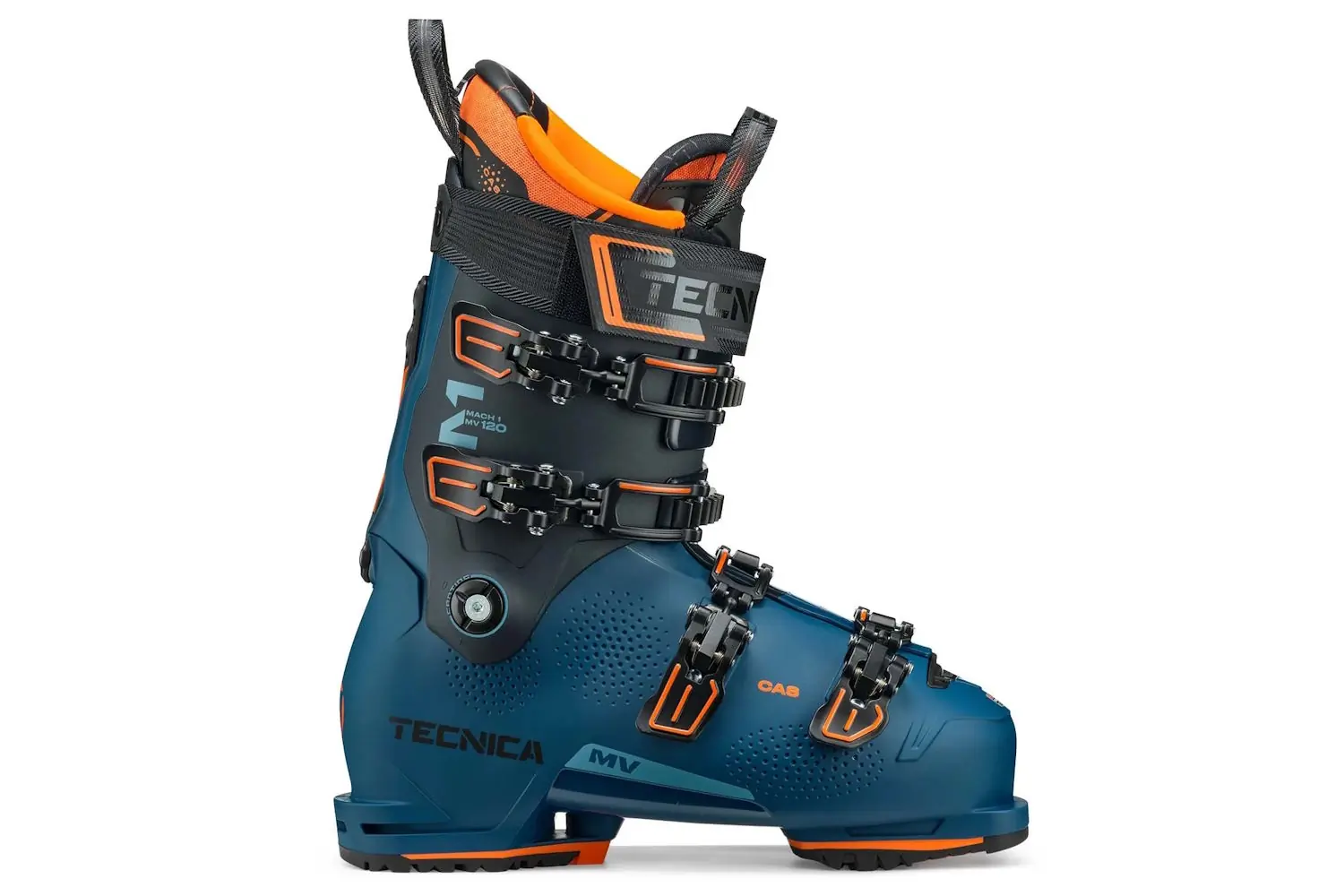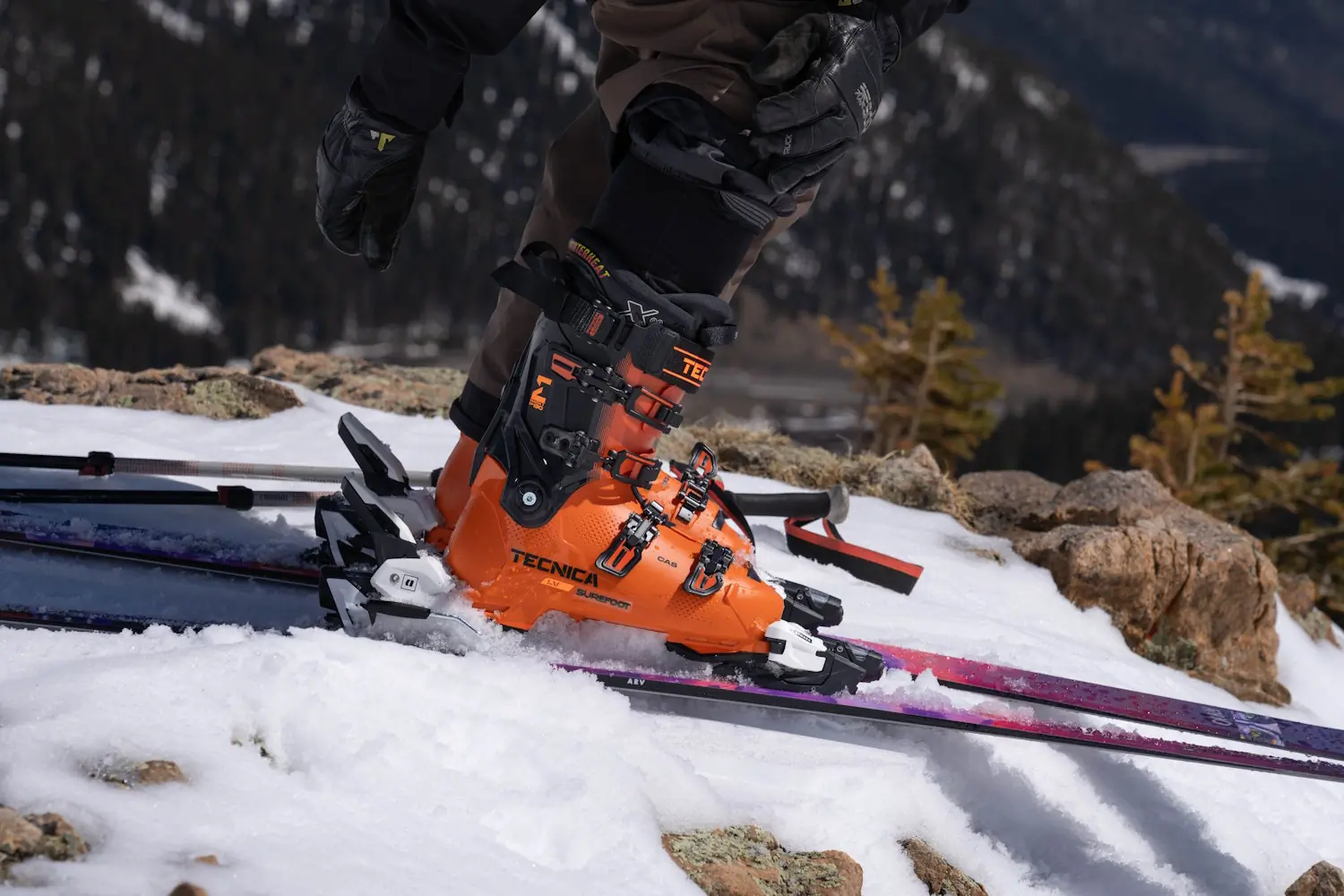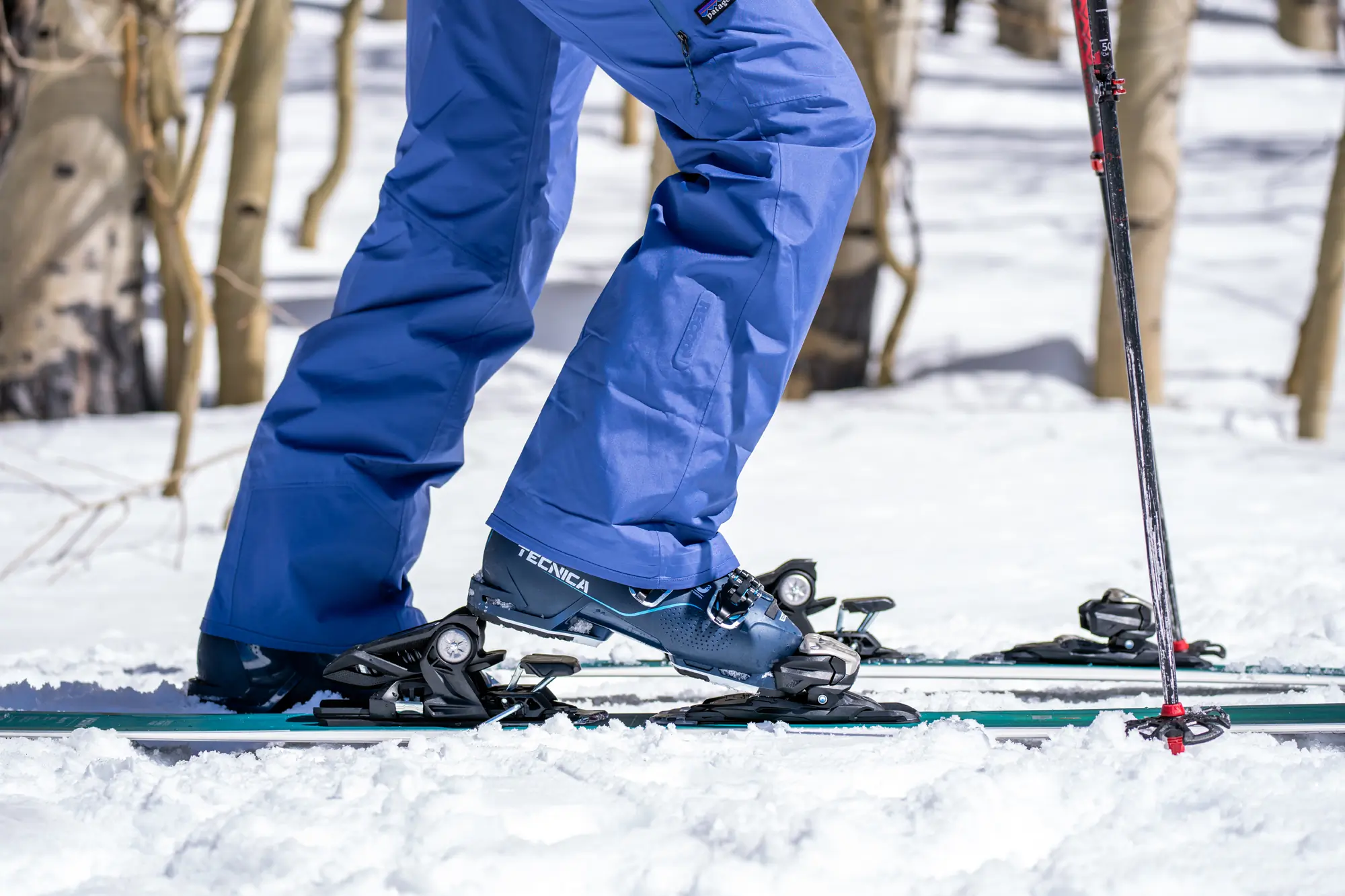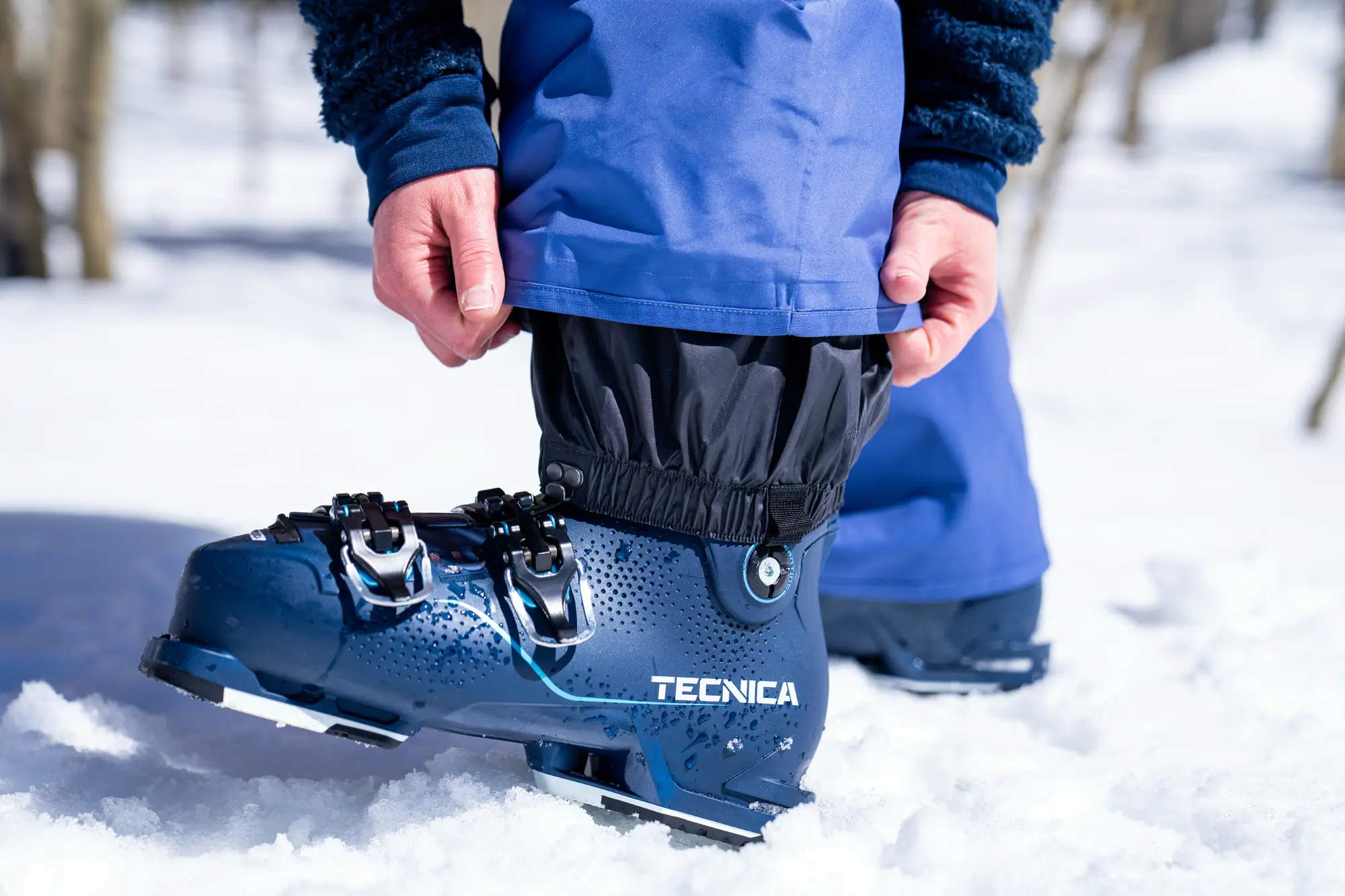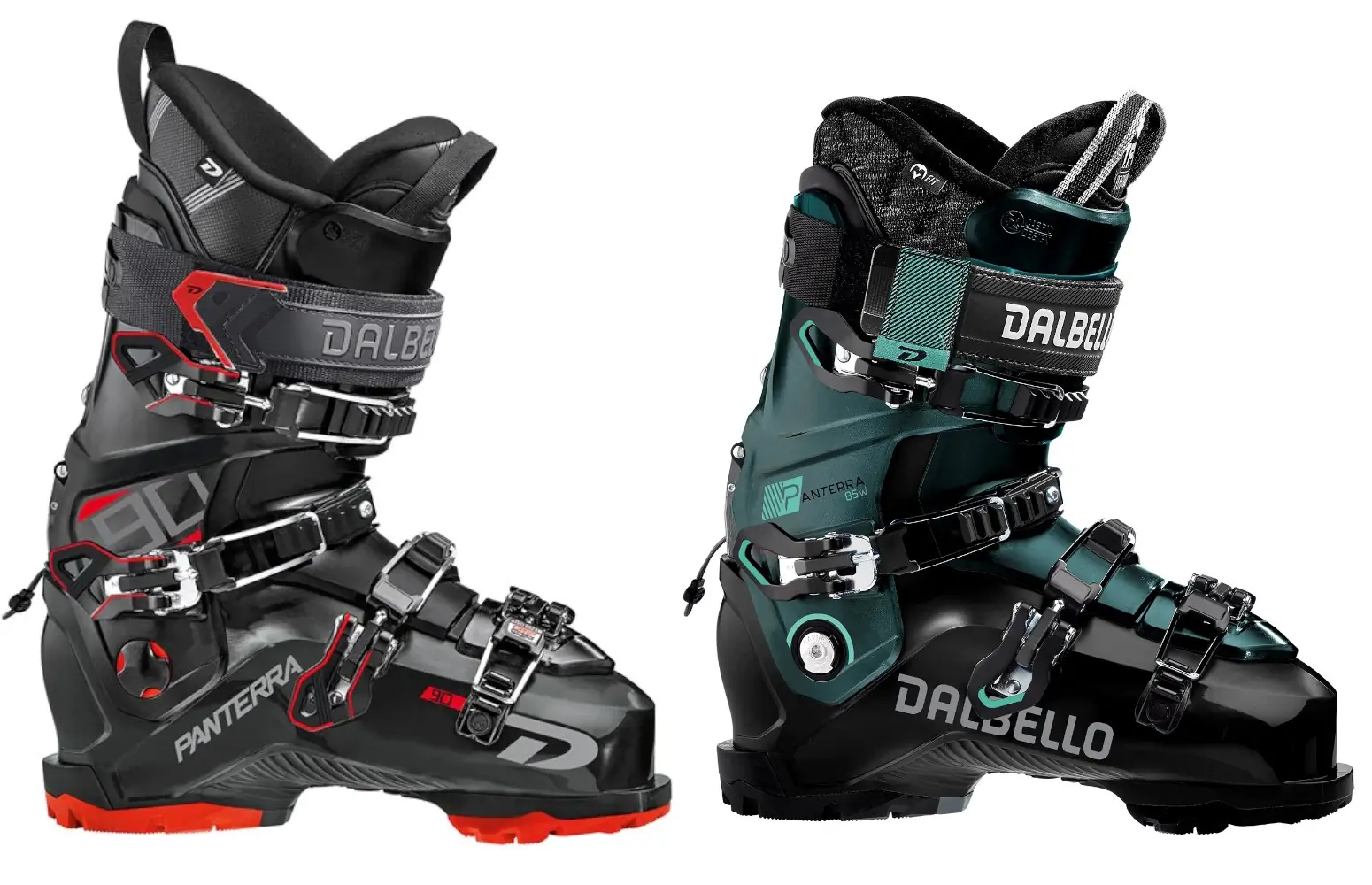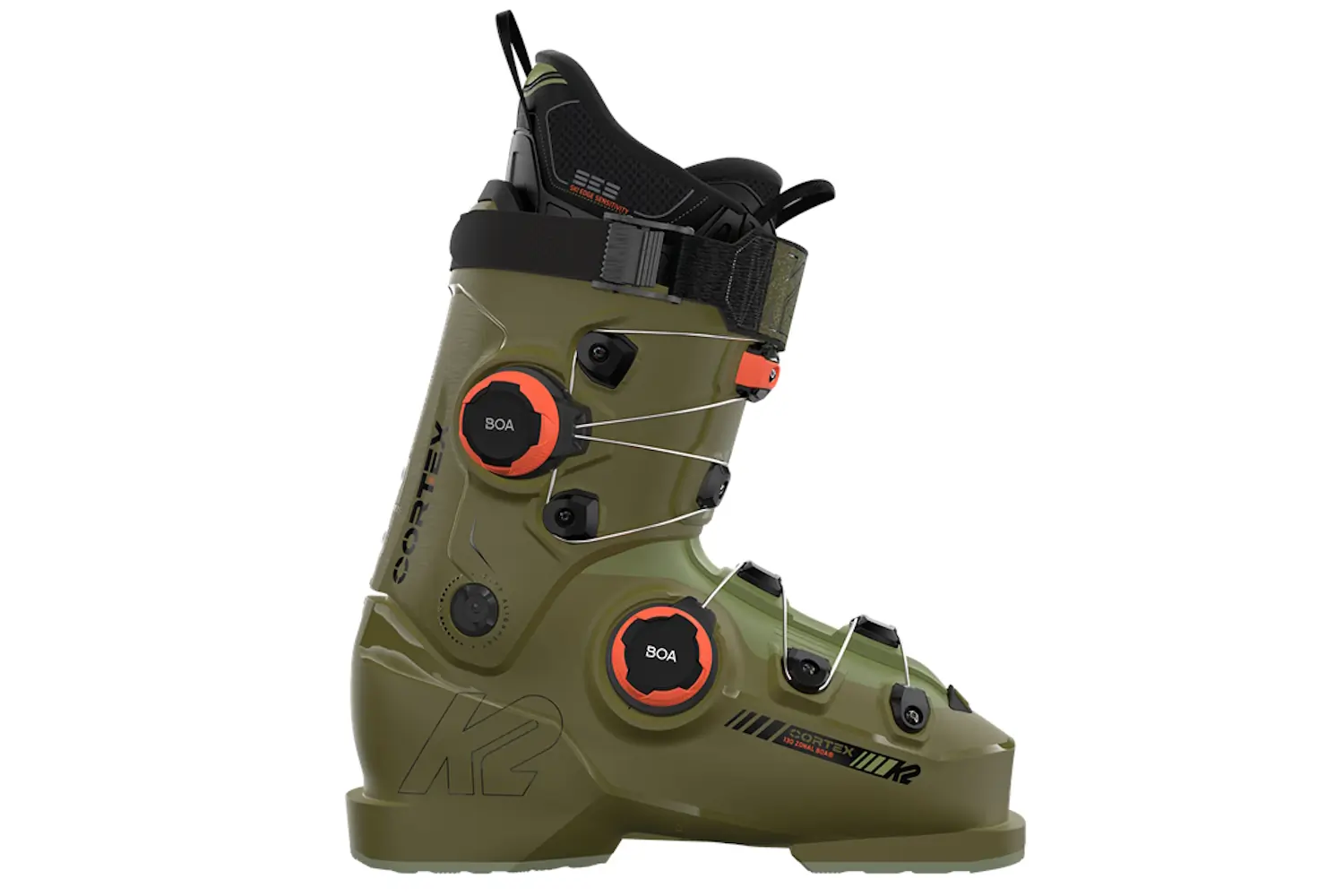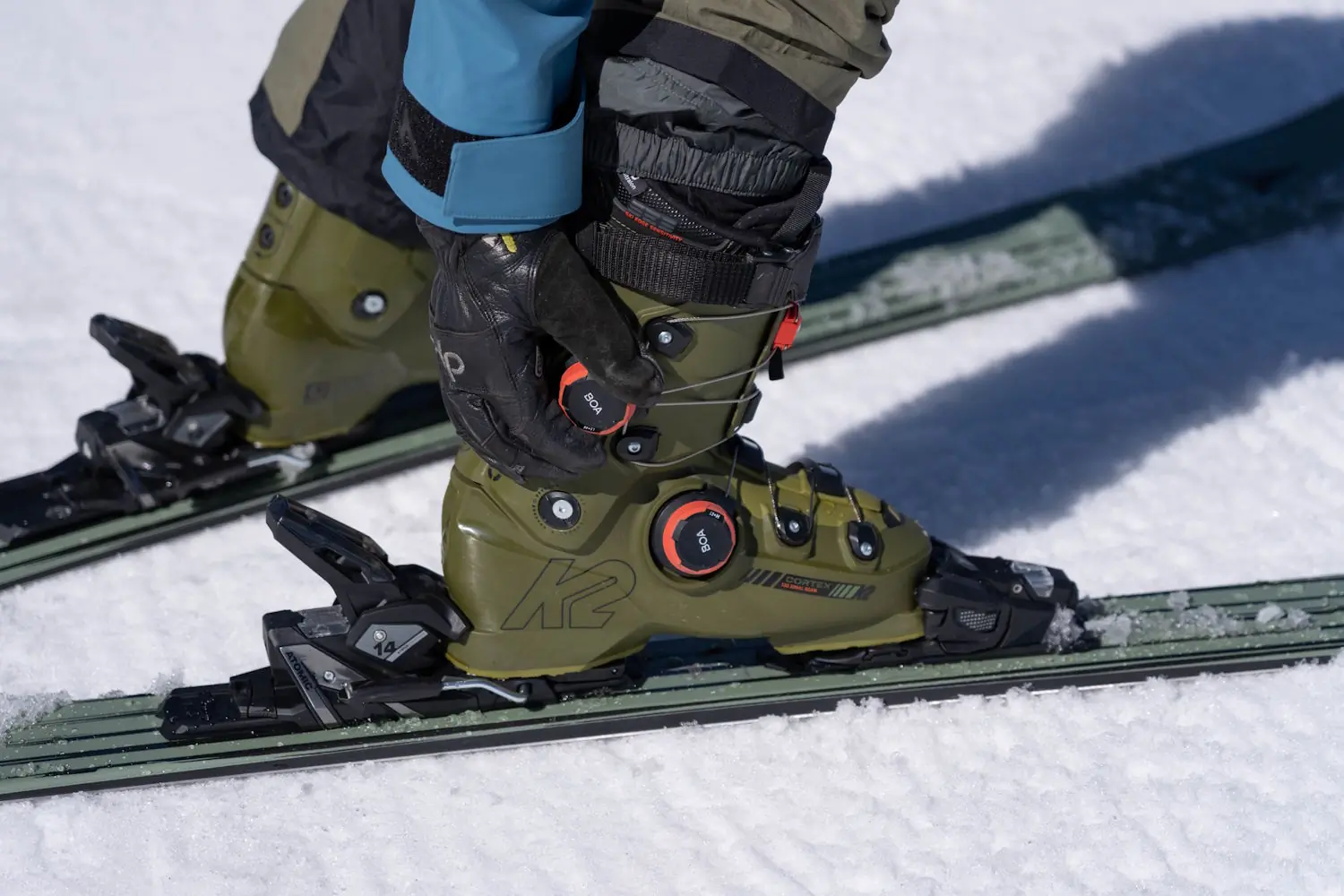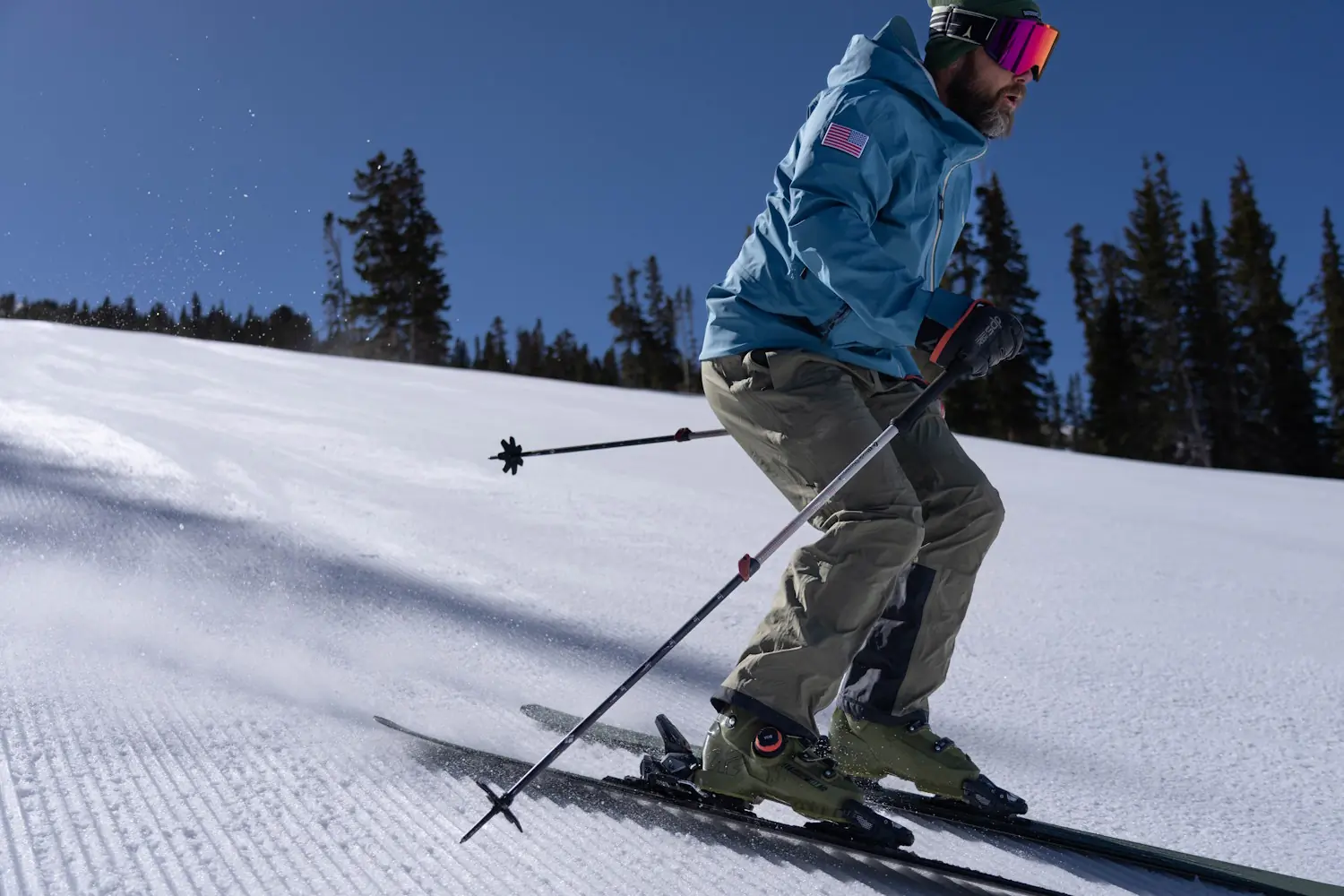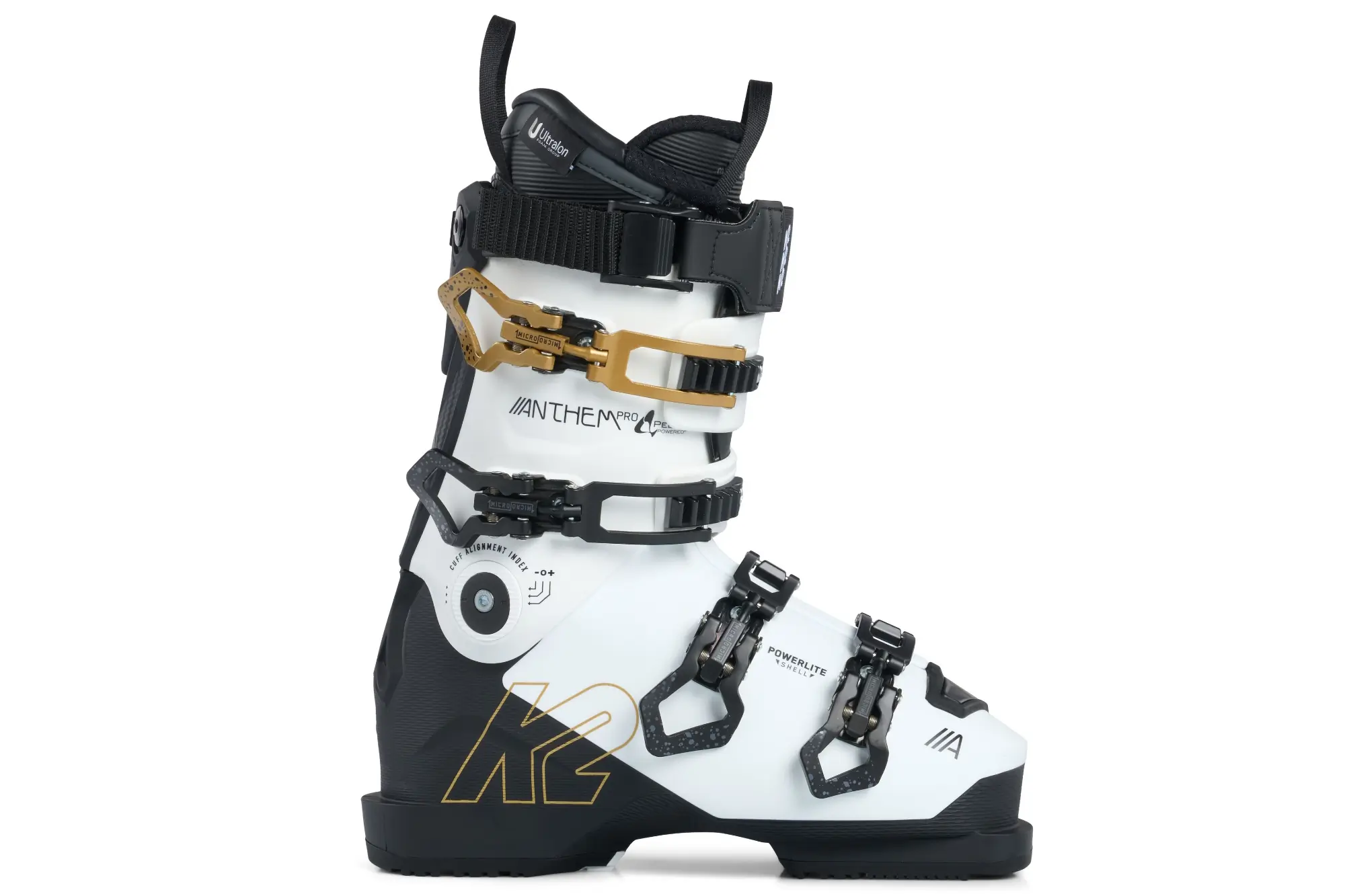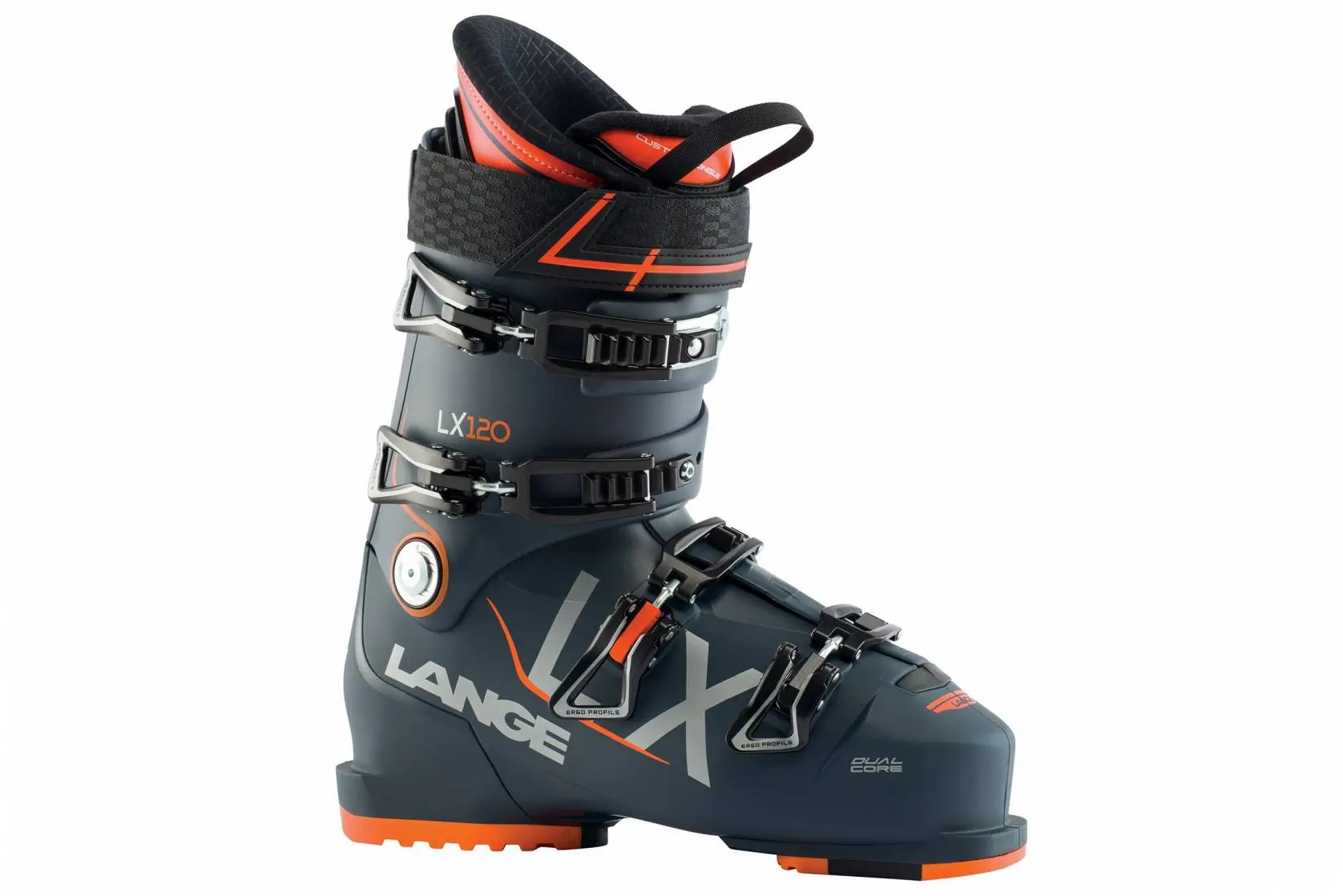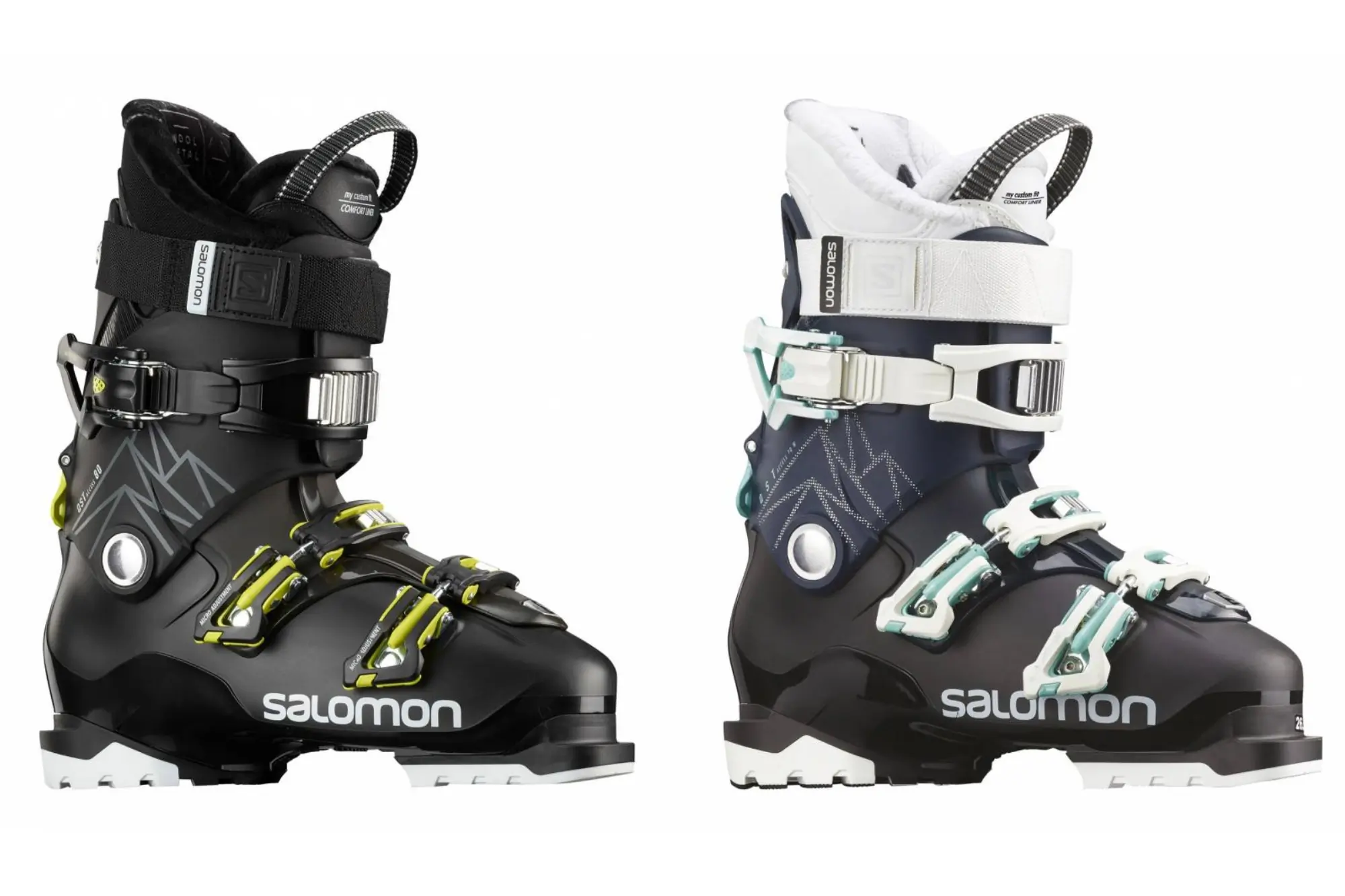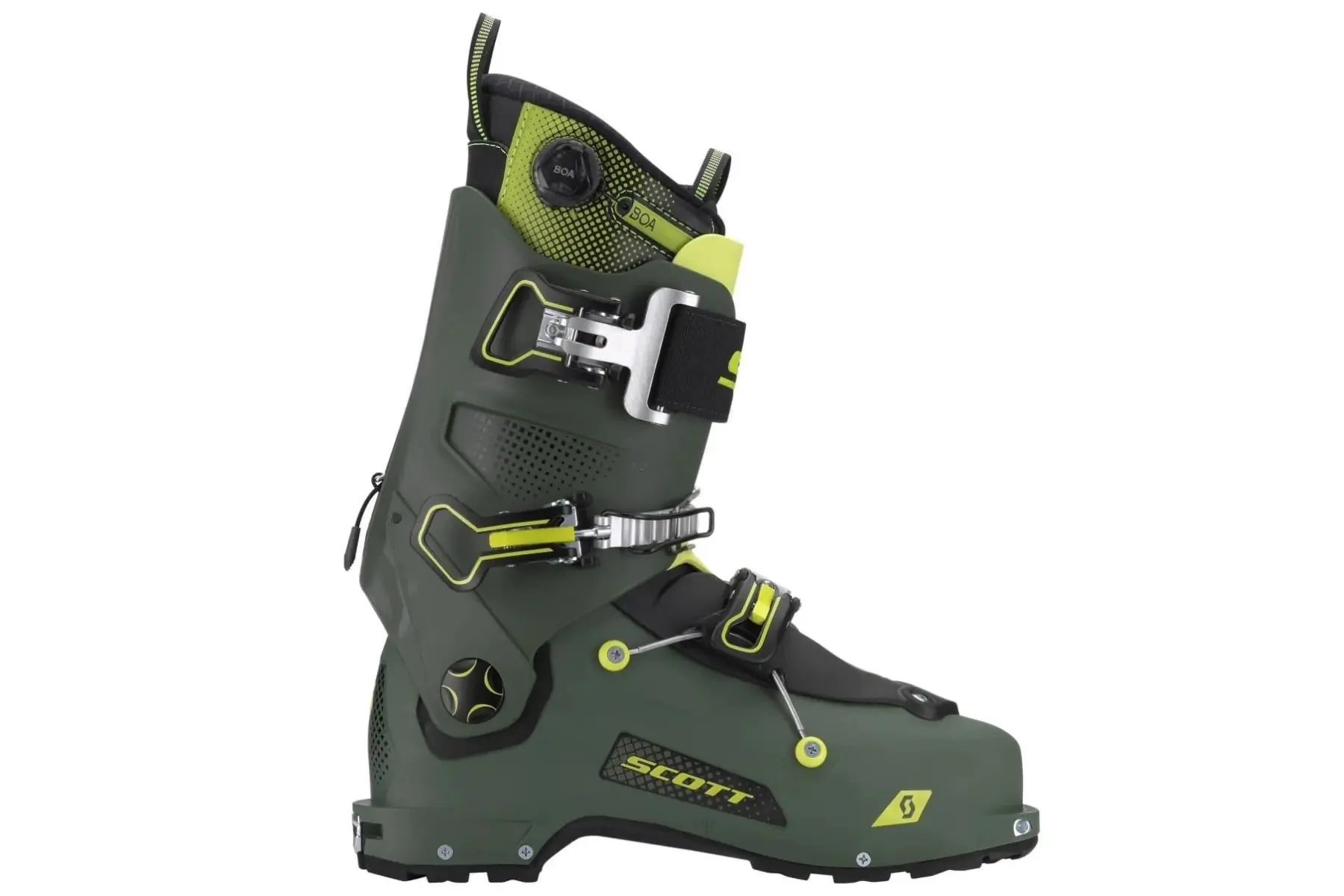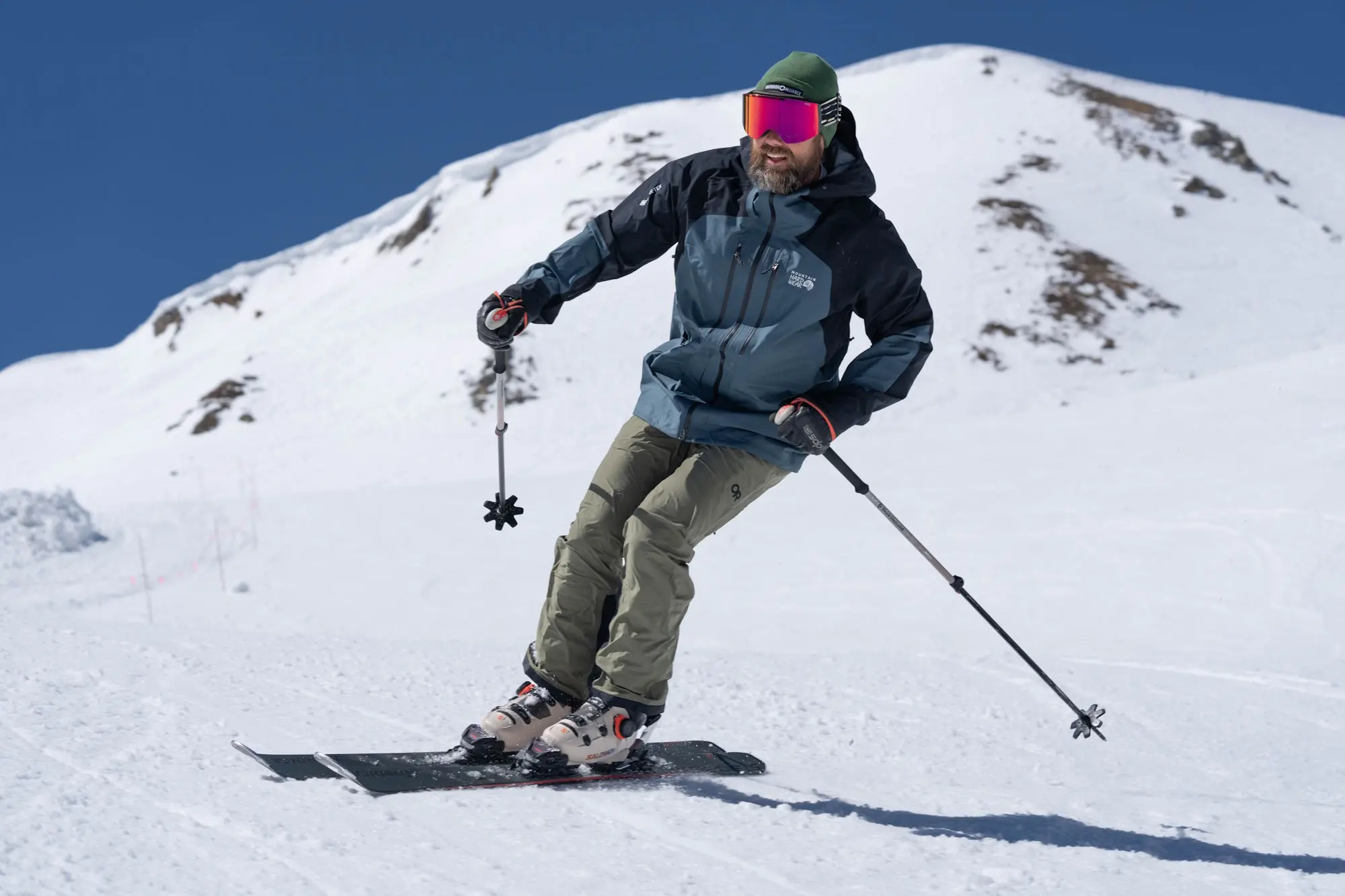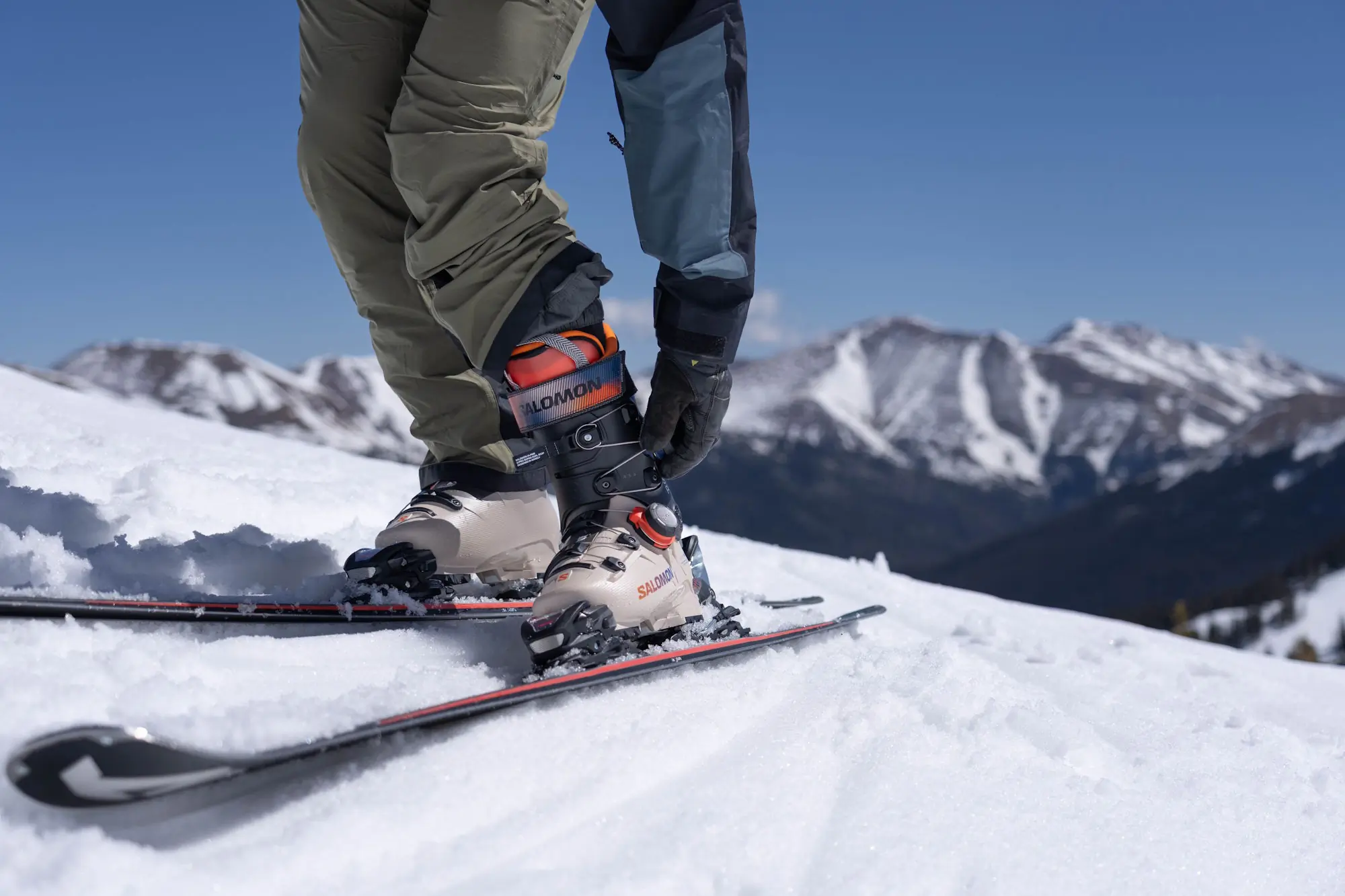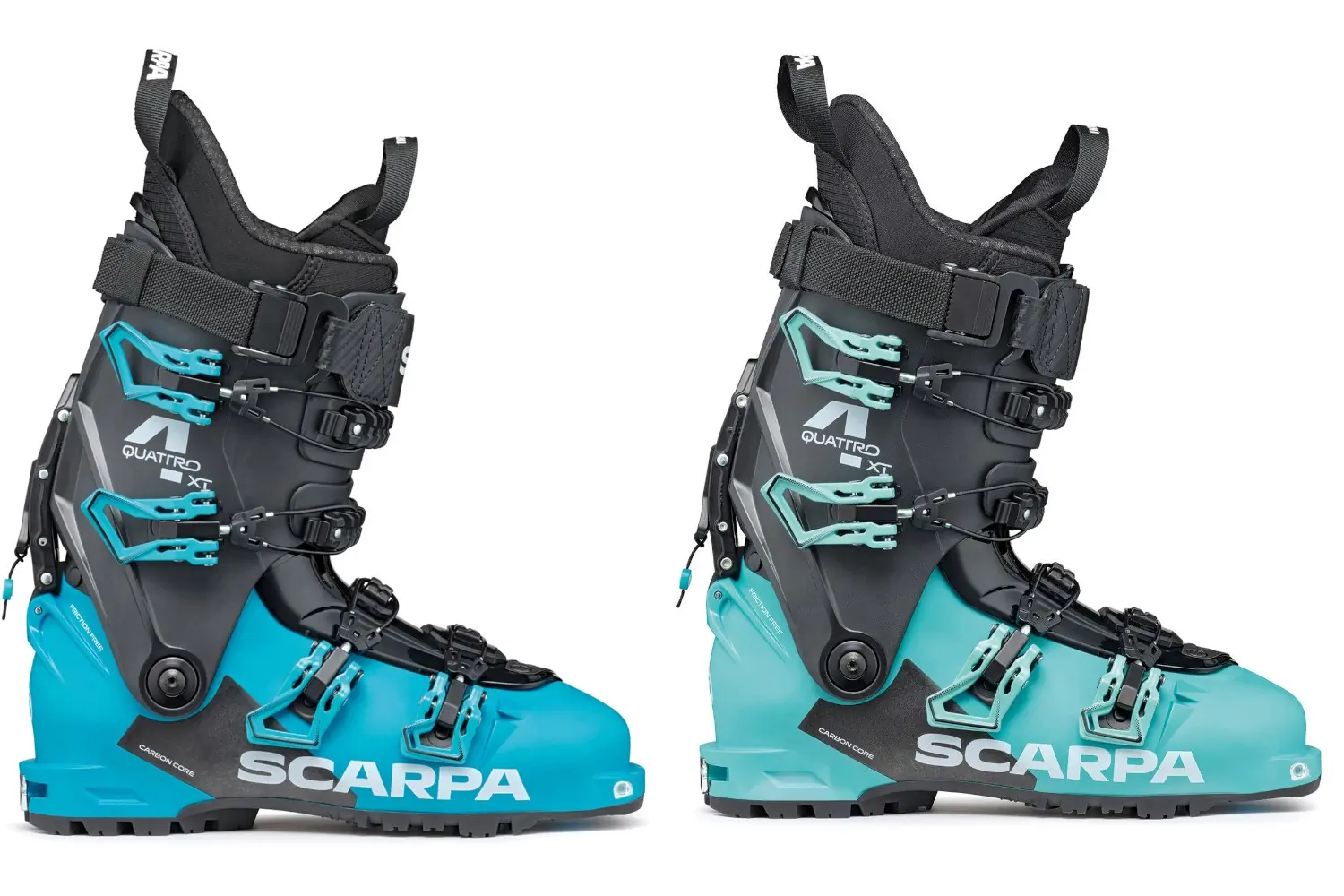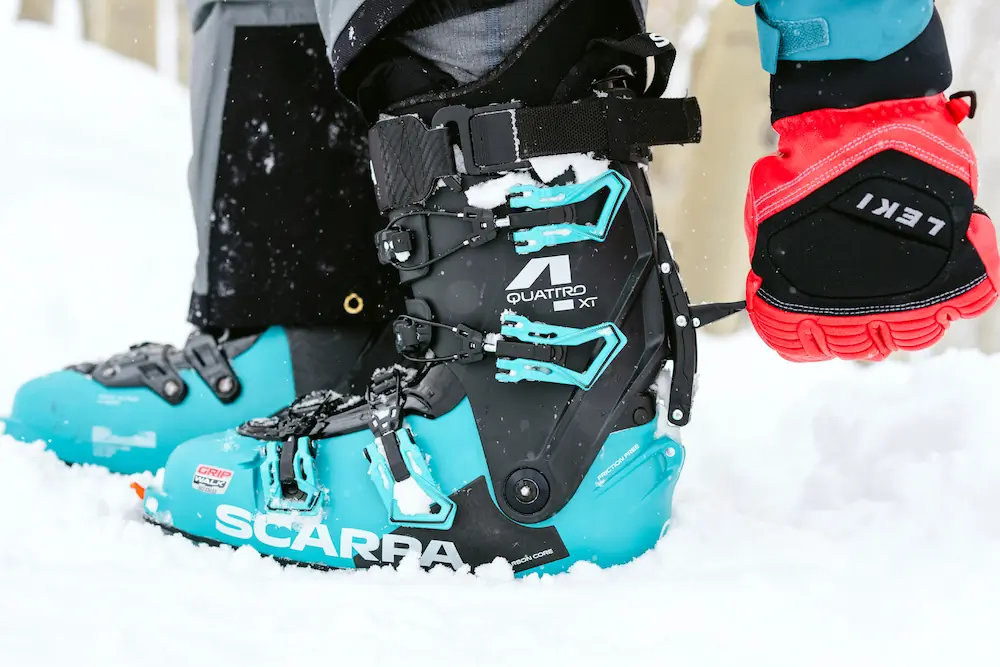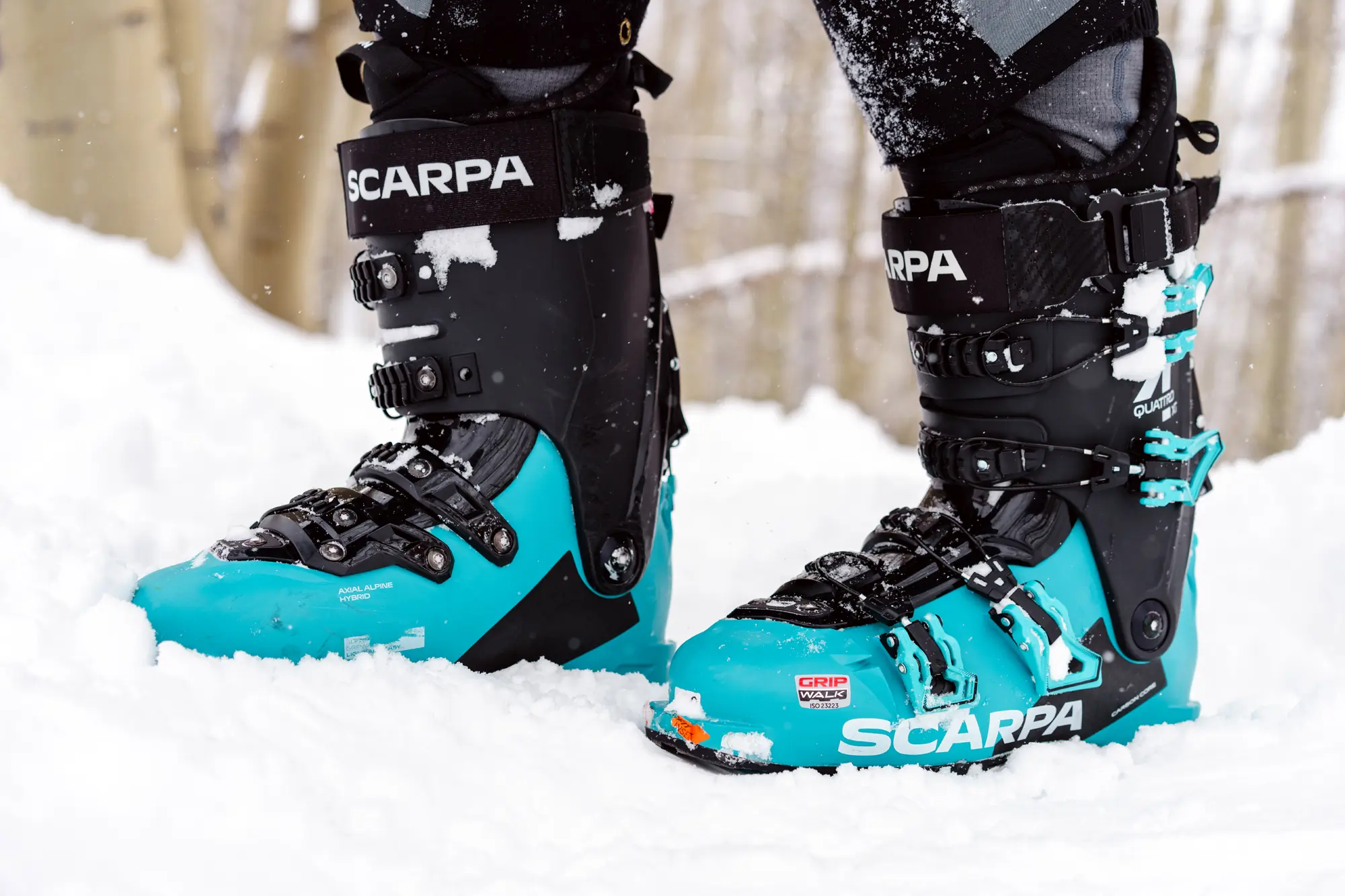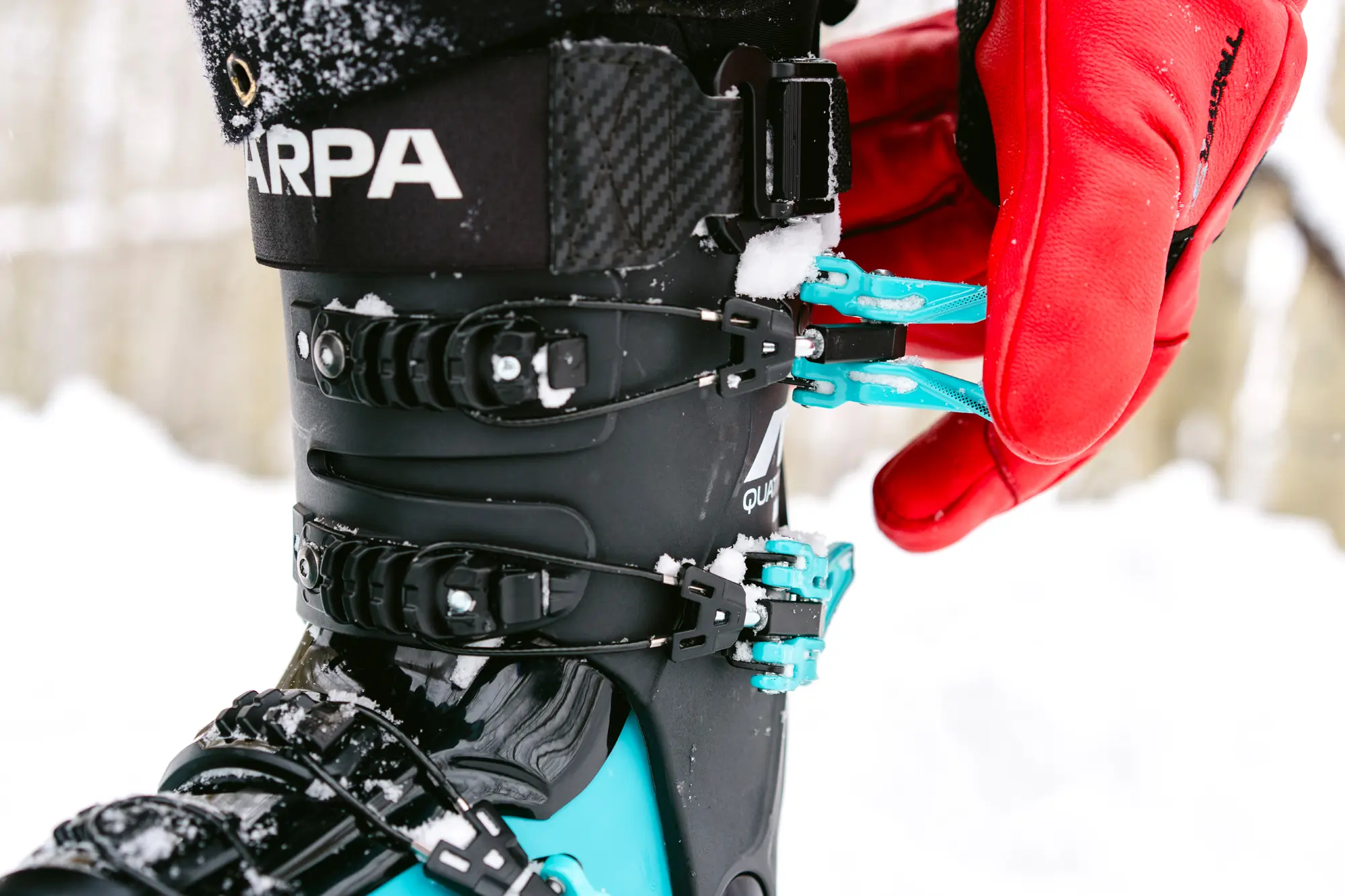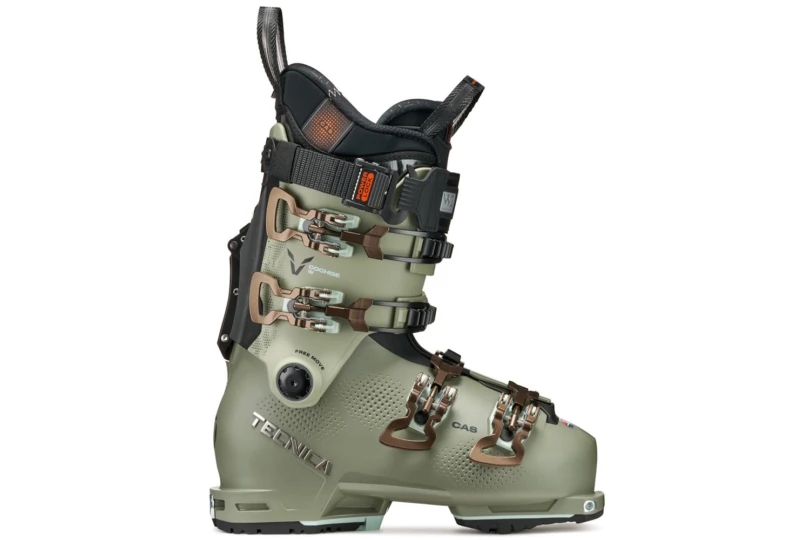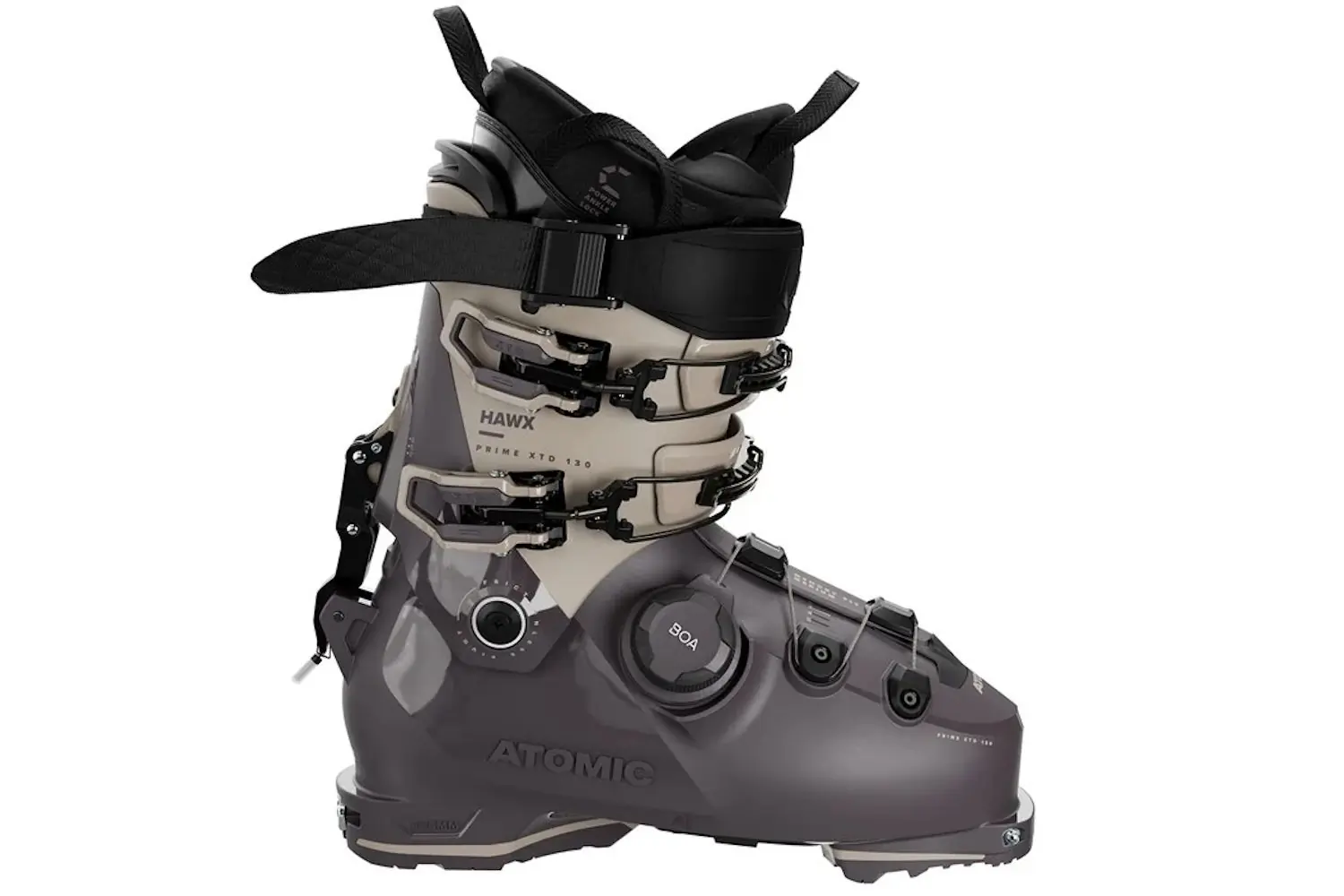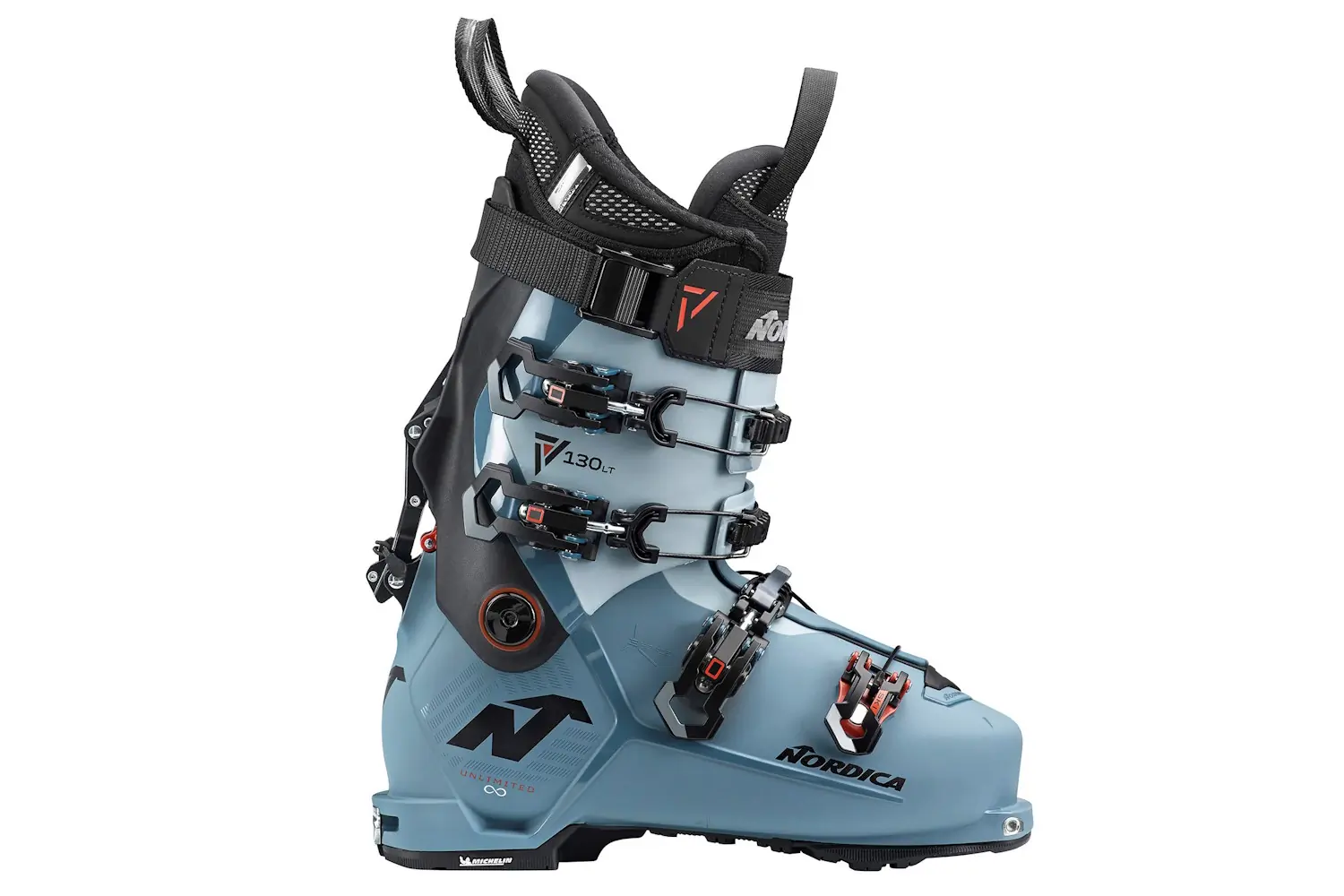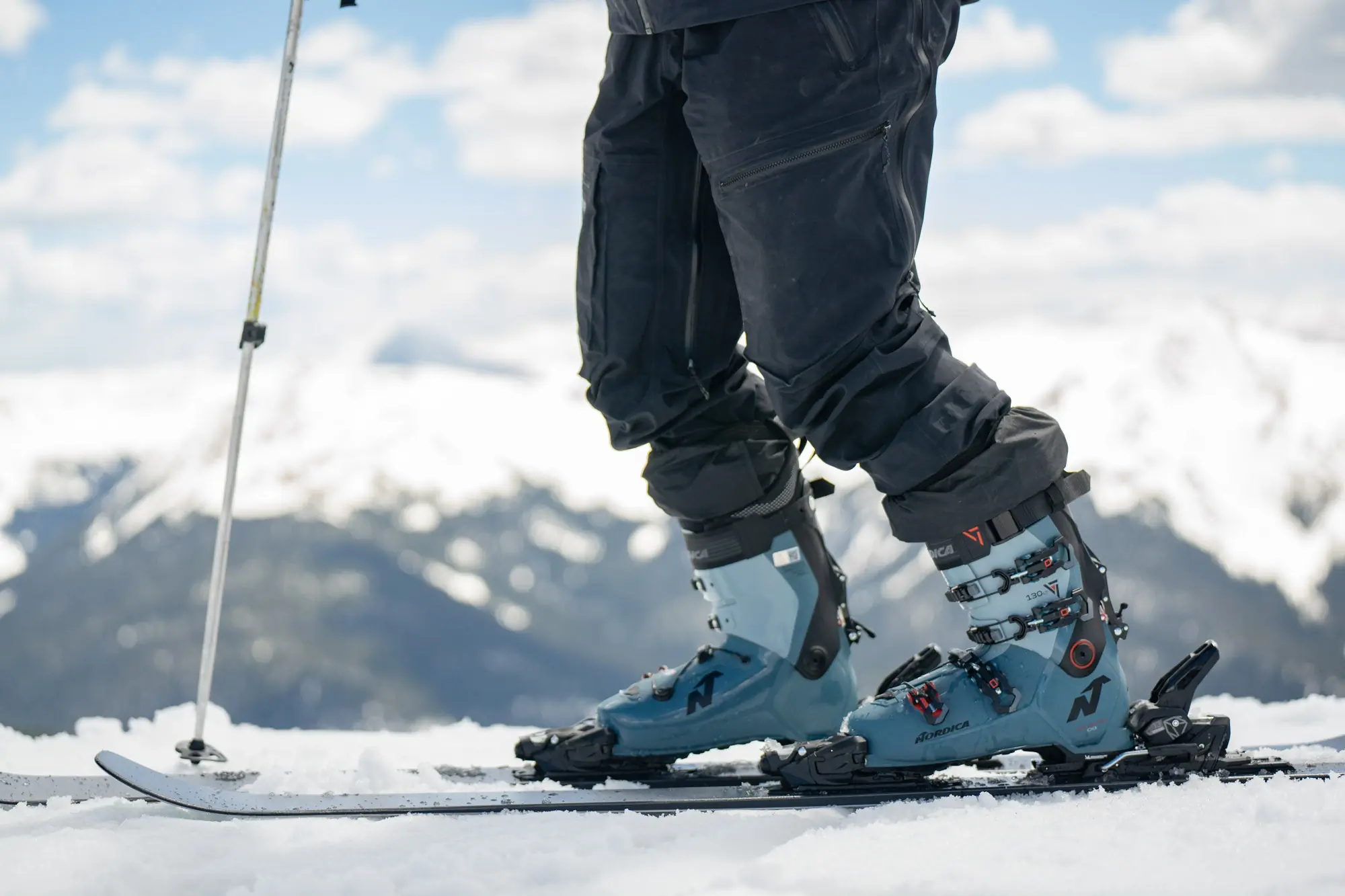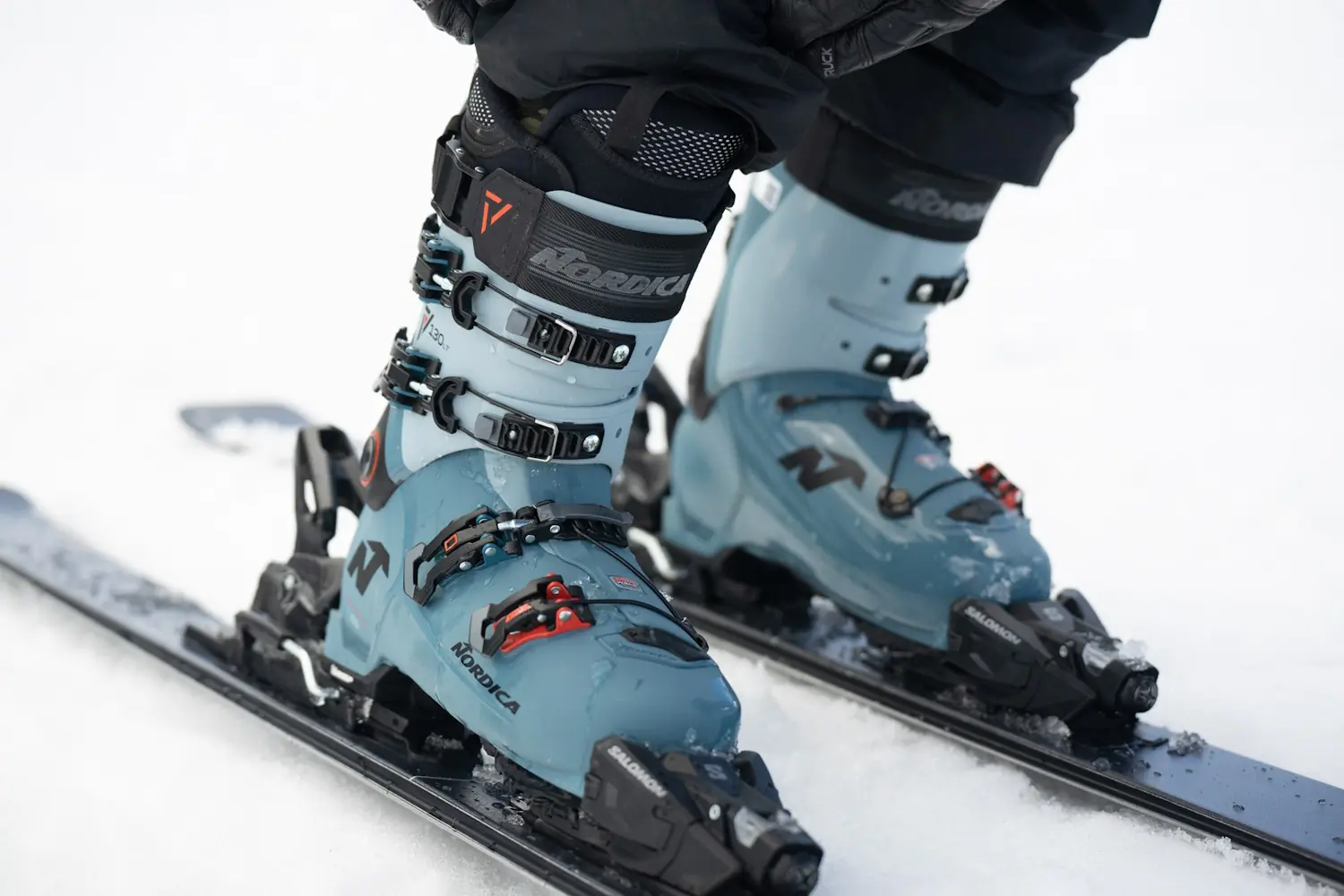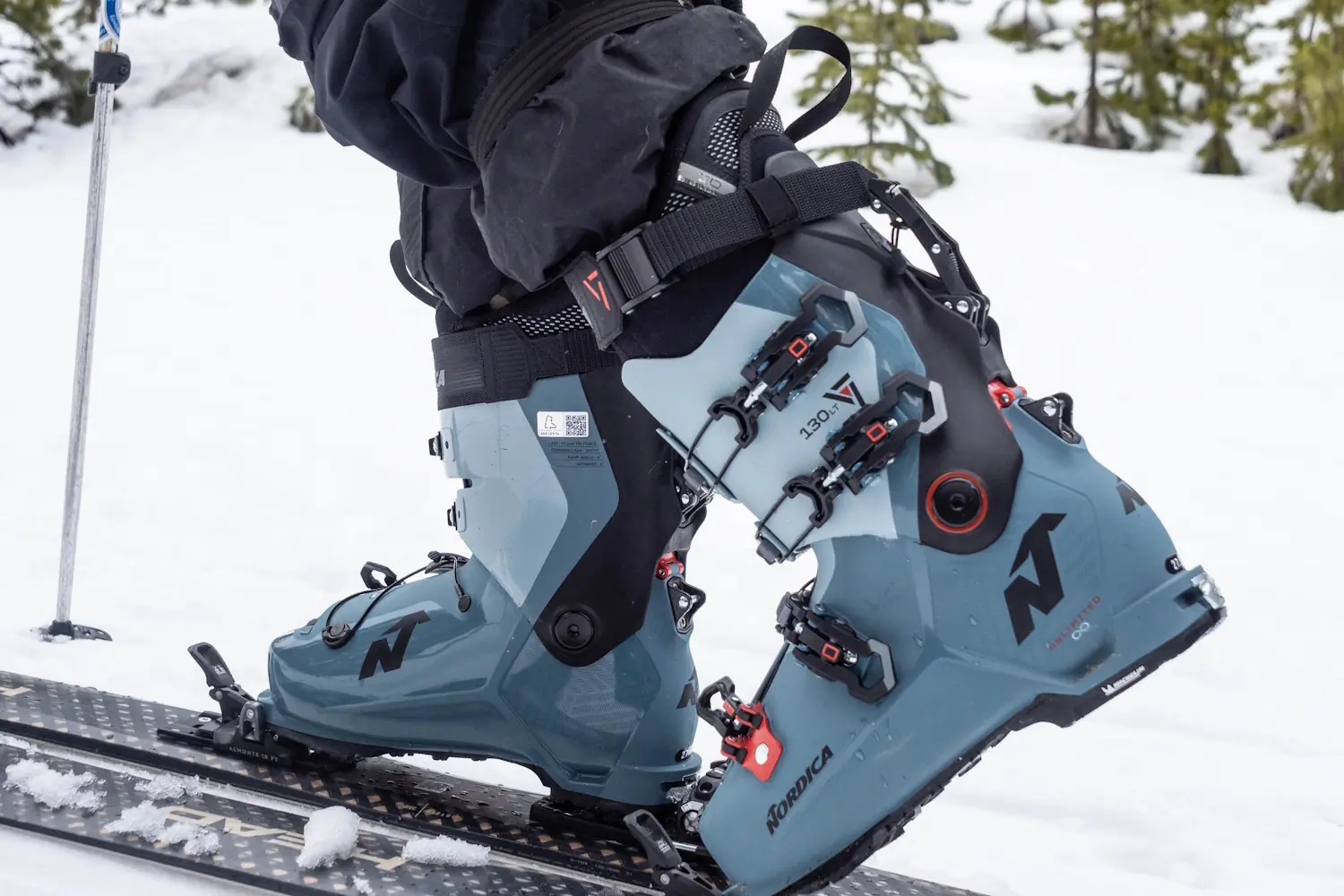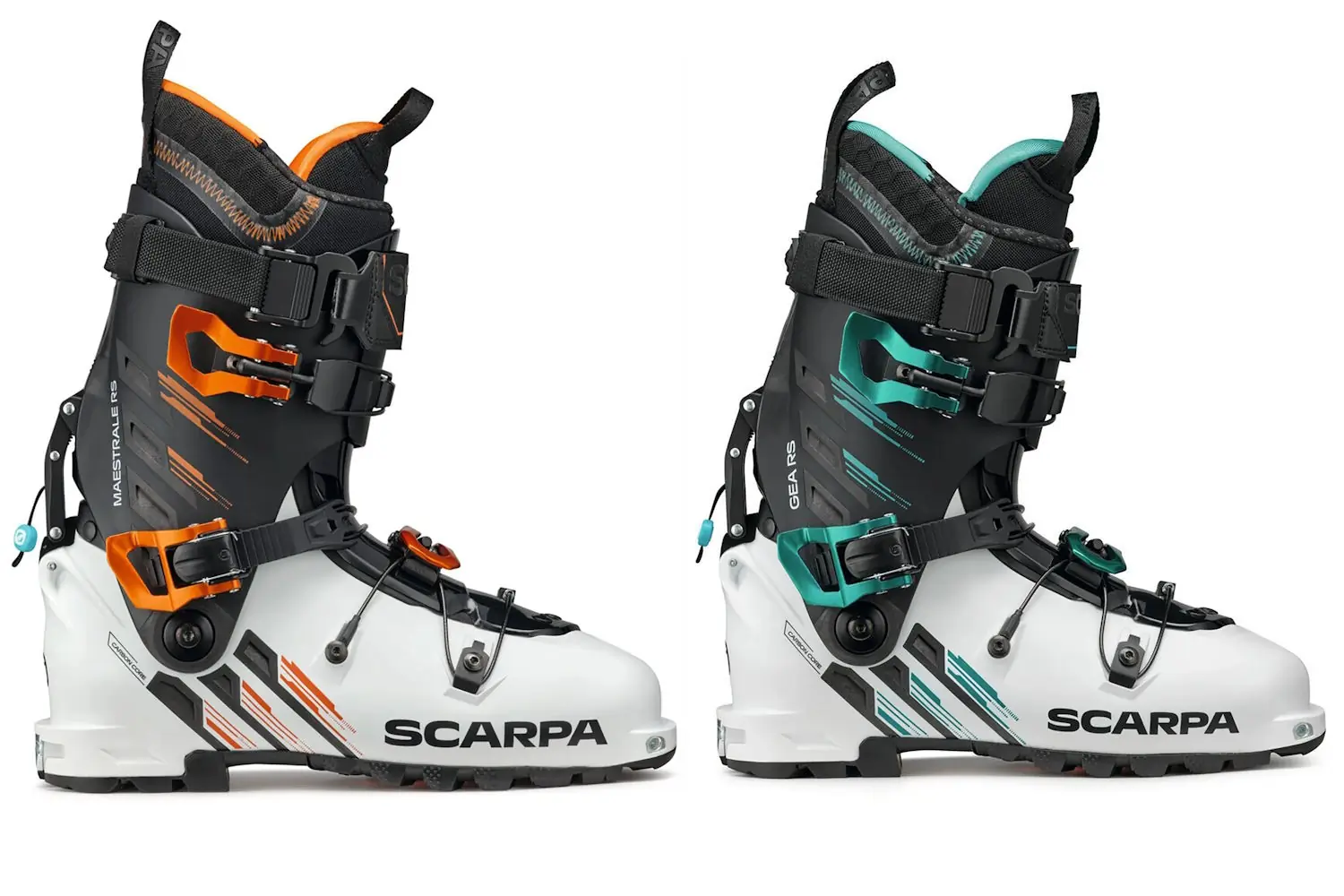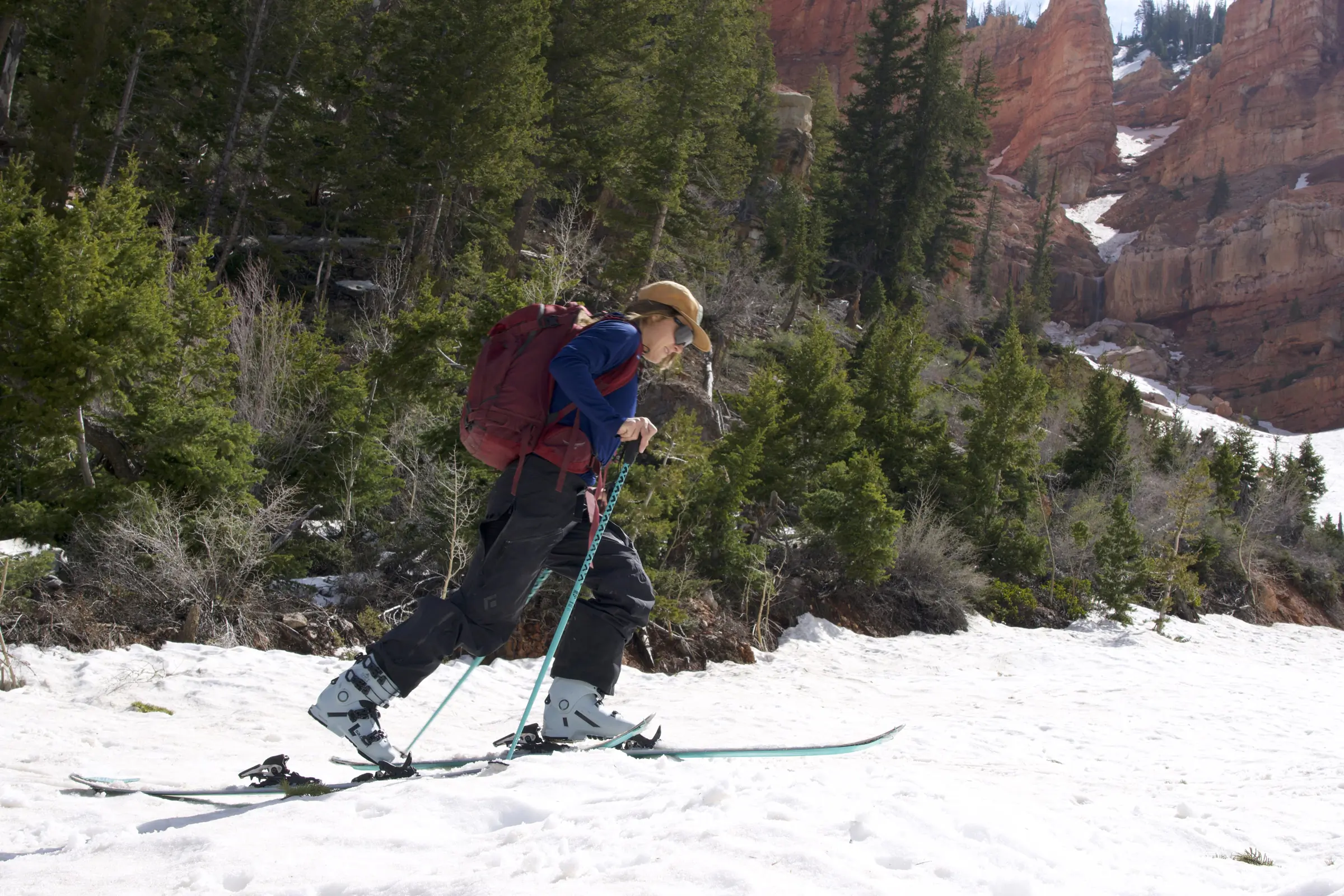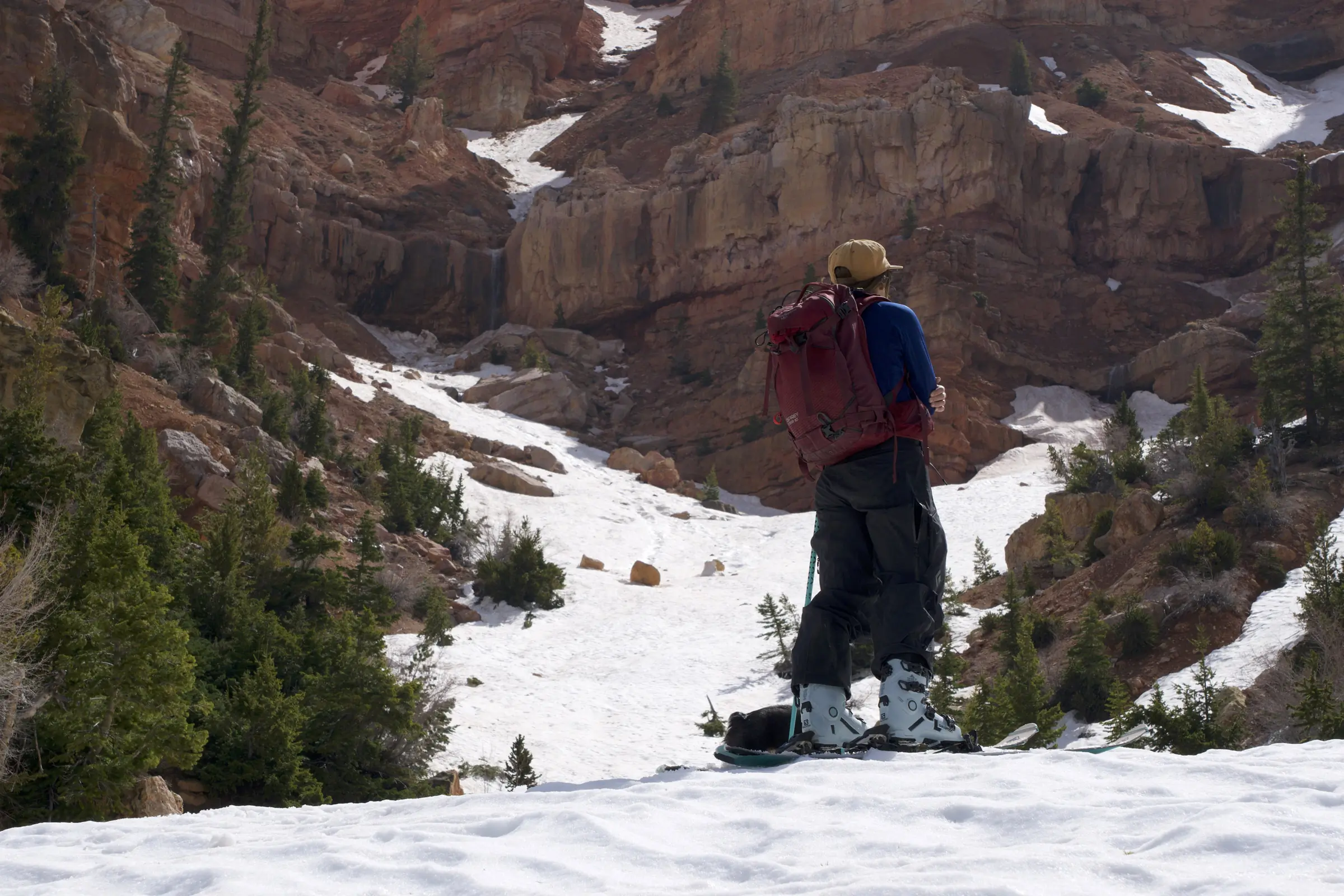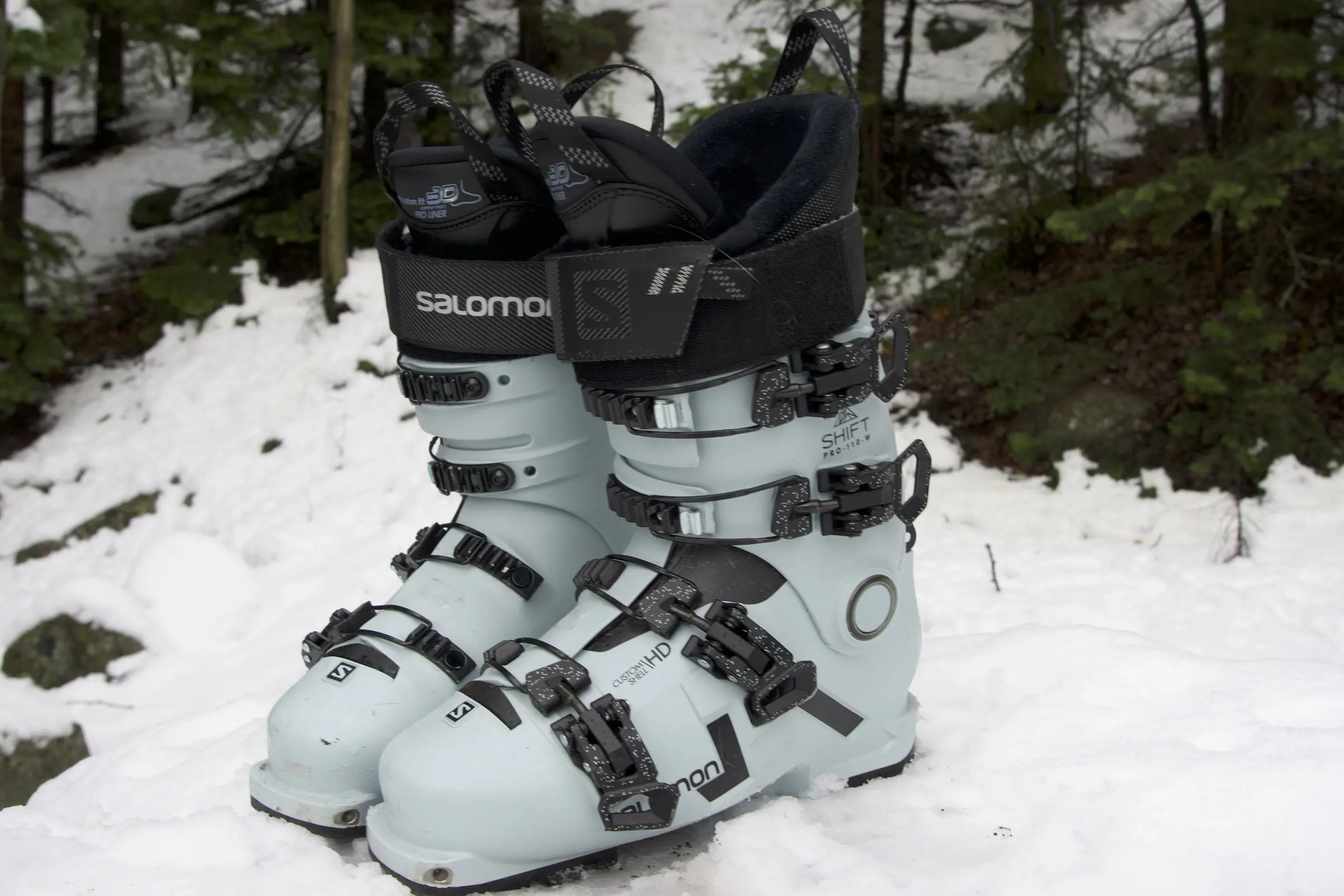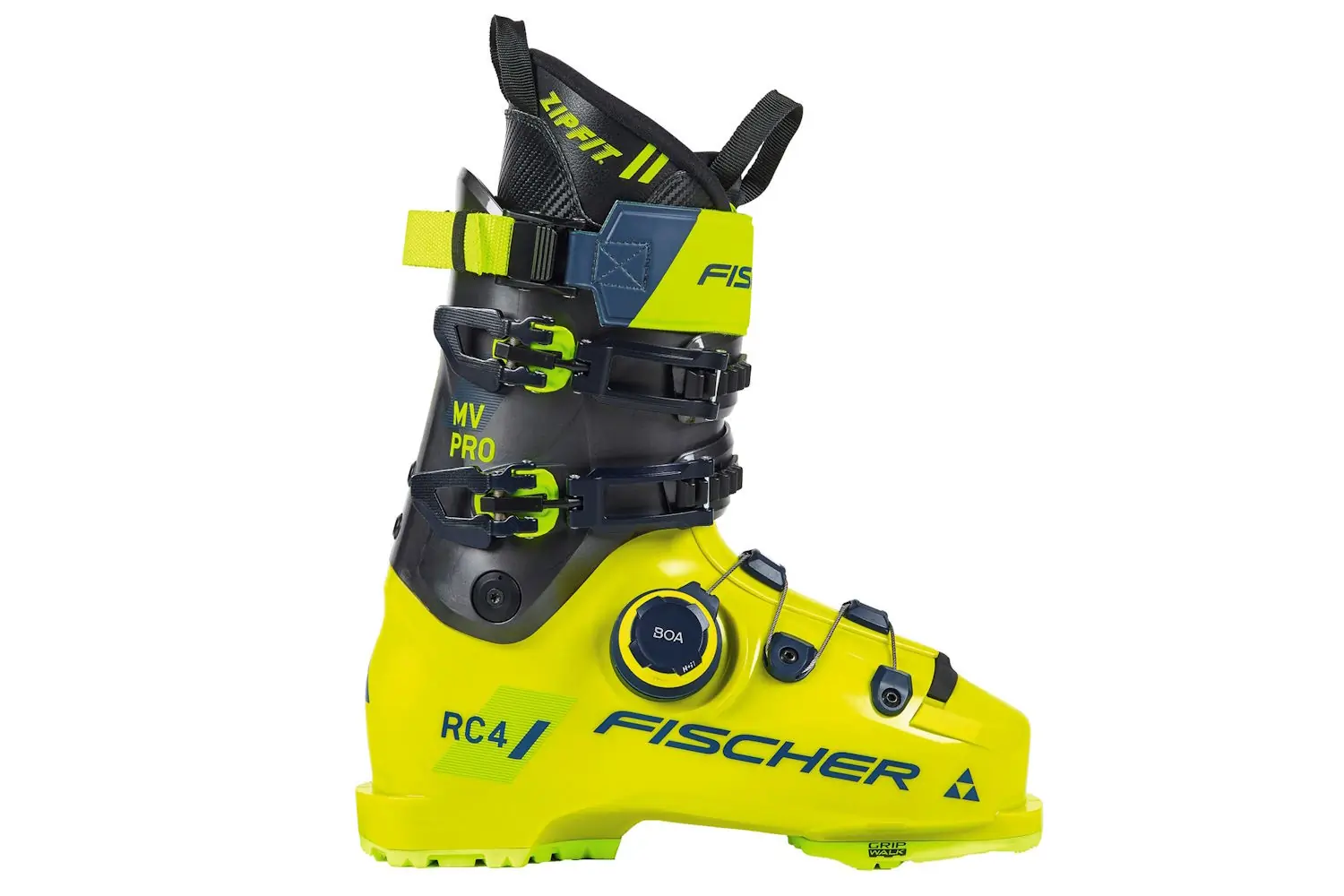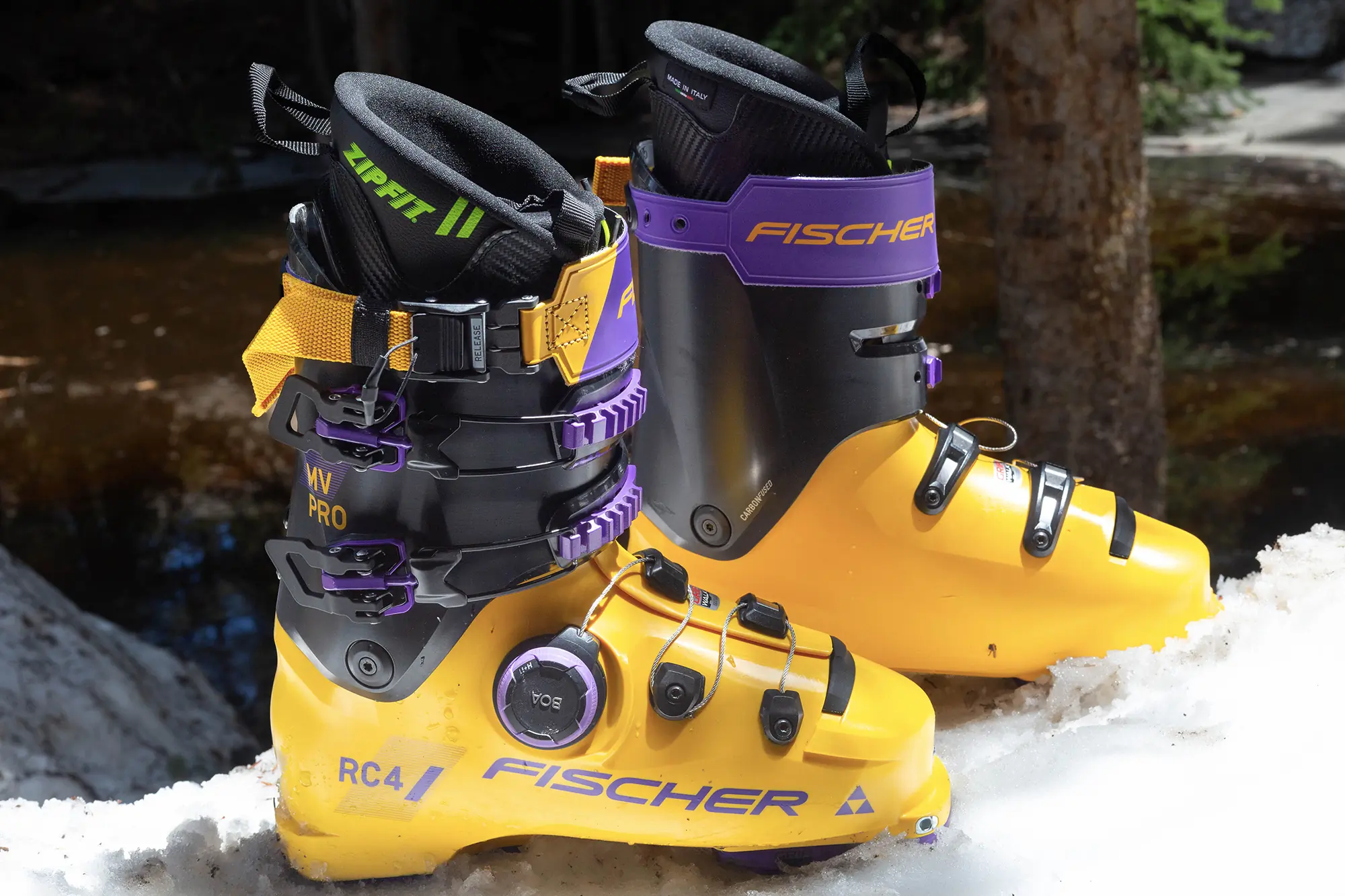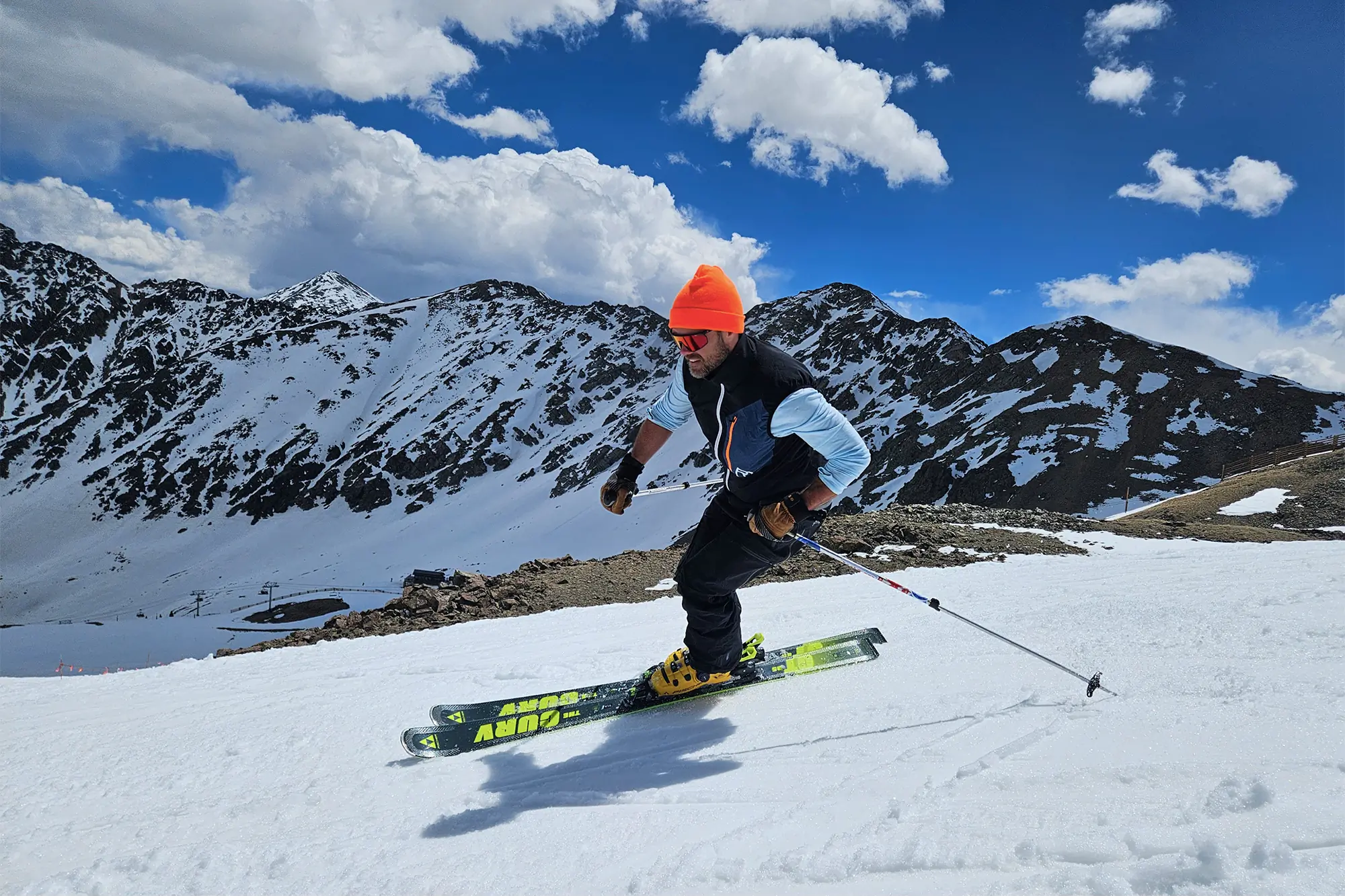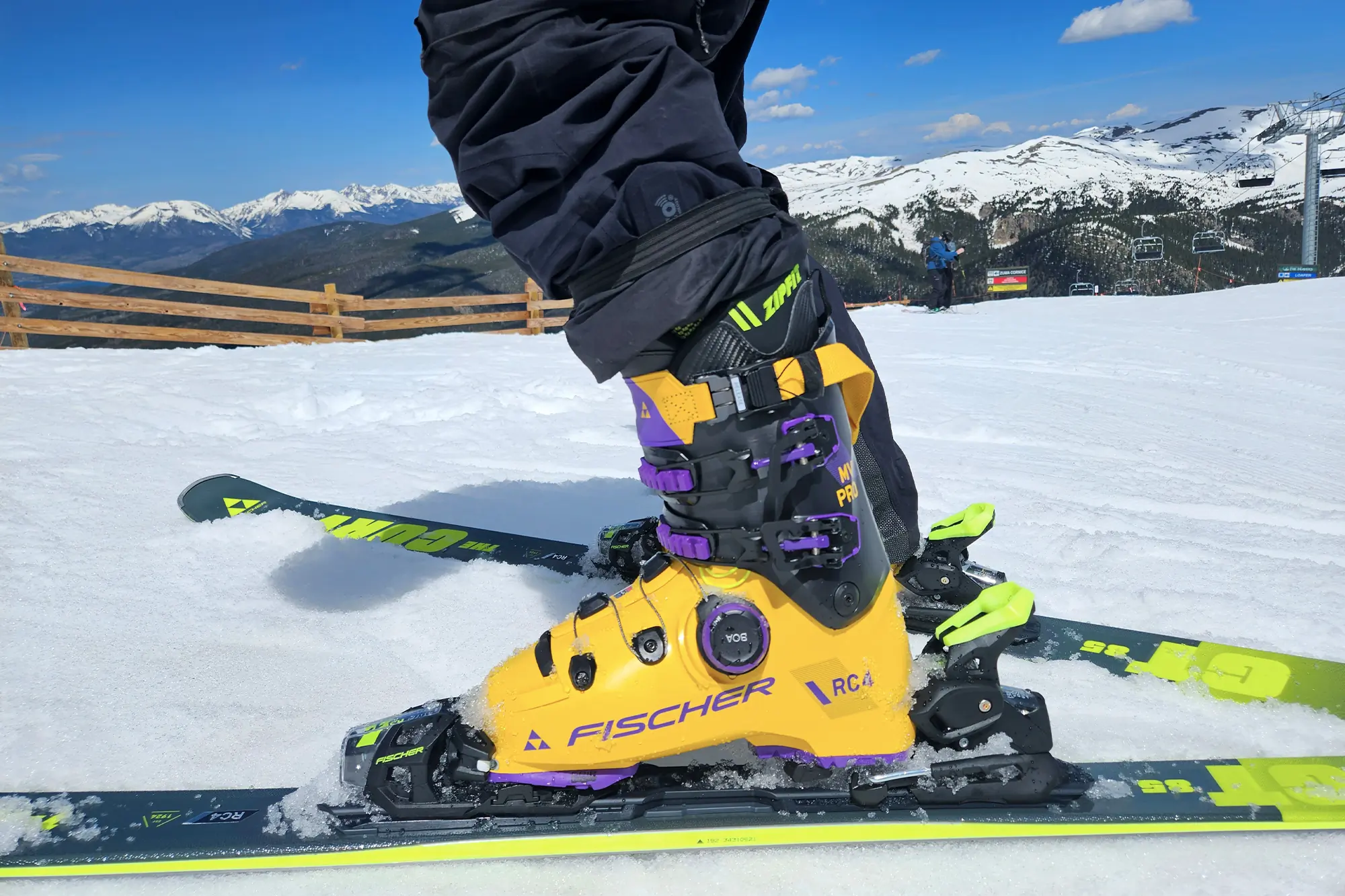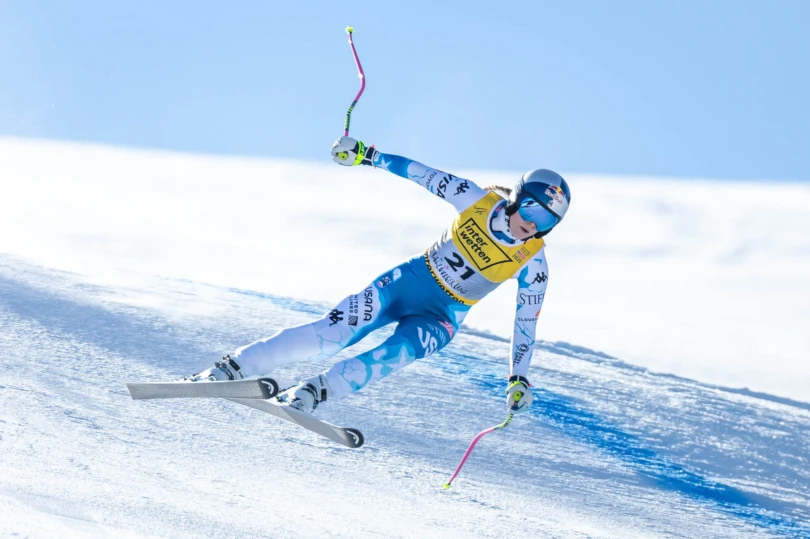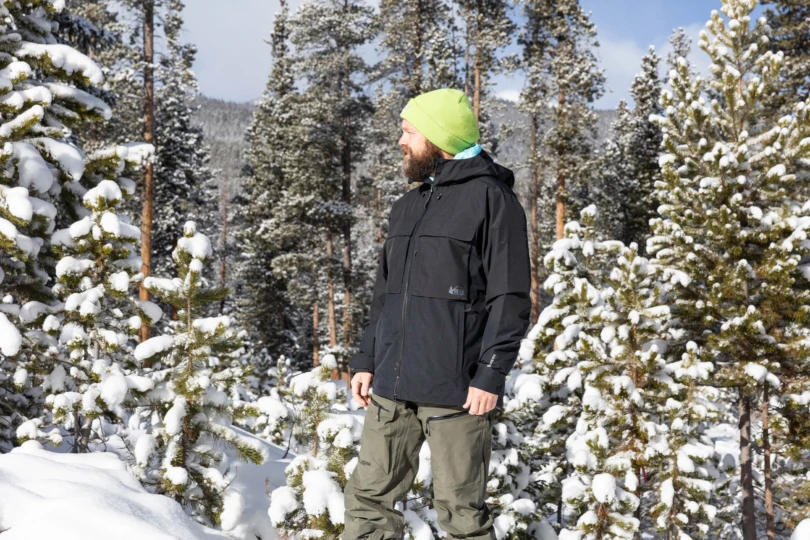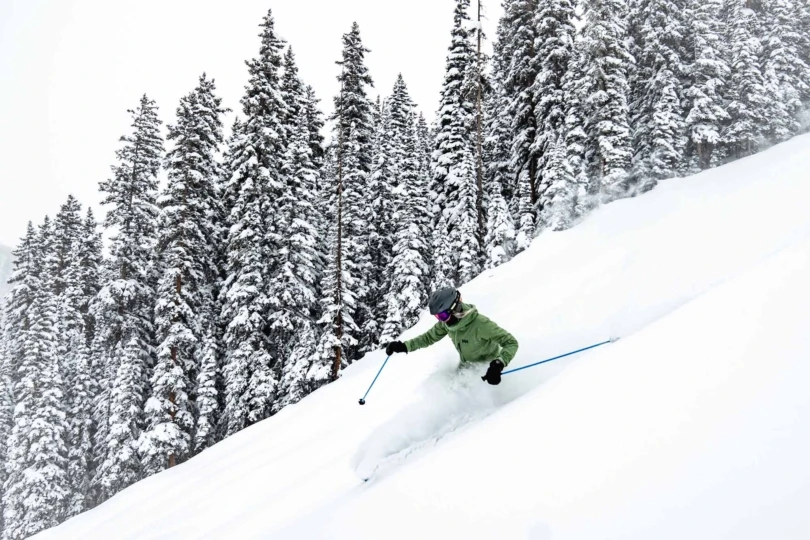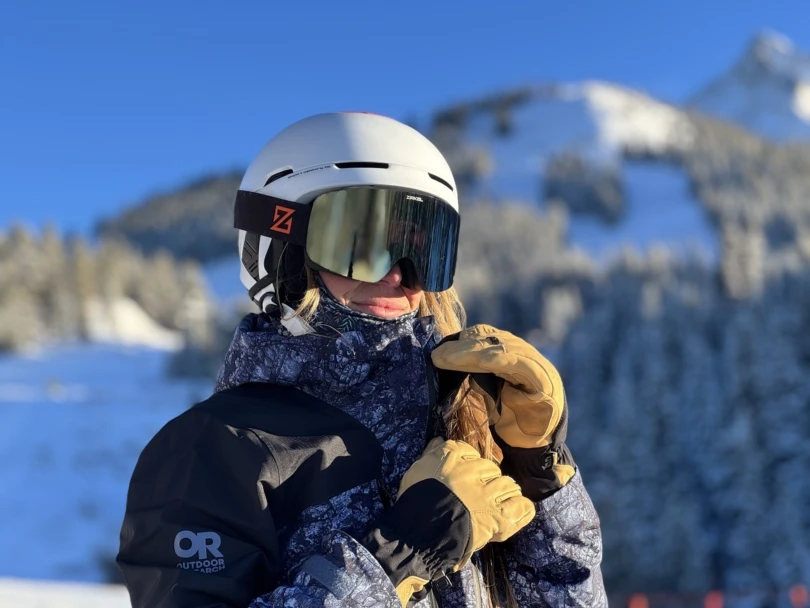The first step in researching ski boots is knowing how and where you want to ski. The best alpine boots, touring boots, and hybrid boots — with a walk mode to go uphill but beefier build than touring boots for resort laps — all bring different features and benefits to the table. For instance, the Scott Freeguide Carbon is an excellent choice for dedicated ski touring, while the Tecnica Mach 1 MV is a solid alpine ski boot for downhill laps at the resort.
Before you walk into your local ski shop, determine if you’ll want to stick to lift-served skiing, explore the backcountry or side-country, race, or get into a little bit of everything.
Buying new ski boots is best done in person or with a customer service representative who knows the category well. A good shop will measure your feet and help you hone in on what brands and models naturally fit you, your experience, and your aspirations. Plus, everyone’s feet are a unique shape, which is all the more reason why you should try boots on in person and consider taking your pair to a professional boot fitter to dial in the fit.
Editor’s Note: We updated our Ski Boots buyer’s guide on October 15, 2025, with the field-tested Salomon S/Pro Supra 120 Dual BOA for intermediate and advanced downhill skiers. We added an extended rating system that includes Fit and Last Shape, Materials and Flex, Liner Quality and Insulation, as well as Closure System. Check out more details in our Ski Boots Rating System section below.
Don’t miss our women’s-specific roundup of the best on-snow boots: the Best Ski Boots for Women.
The Best Ski Boots of 2025-2026
Tecnica Mach 1 — Men’s MV 120 TD & Women’s LV 105 TD
-
Fit and Last Shape
9.5
-
Materials and Flex
9.5
-
Liner Quality and Insulation
8.0
-
Closure System
9.0
- Last: 100 mm
- Flex: 110, 120, 130 flex (men’s)
- Weight: 2,060 g (4.6 lbs.)
- Sizes: 24.5-30.5
- Best for: Experienced/advanced/expert/intermediate alpine skiers, resort skiers
Pros
- Takes less energy to drive this boot
- Warm
- T-Drive is now available in the women’s low-volume boots
Cons
- T-Drive is not available in the HV (high-volume) women’s boot
Dalbello Panterra — Men’s 90 GW & Women’s 85 W GW
-
Fit and Last Shape
7.0
-
Materials and Flex
7.9
-
Liner Quality and Insulation
6.0
-
Closure System
7.5
- Last: 99-101 mm (women’s), 100-102mm (men’s)
- Flex: 85 (women’s), 90 (men’s)
- Weight: 1,785 g (3.94 lbs.)
- Sizes: 22.5-27.5 (women’s), 25.5-30.5 (men’s)
- Best for: Intermediate alpine skiers, resort skiers
Pros
- Good choice for experienced intermediate-level skiers
- Easy entry and exit
- More budget-friendly compared to premium boots
Cons
- Not supportive for narrow feet
K2 Cortex 130 Zonal BOA Ski Boots
-
Fit and Last Shape
8.5
-
Materials and Flex
7.5
-
Liner Quality and Insulation
8.5
-
Closure System
7.5
- Last: 96-98 mm
- Flex: 130
- Weight: 2,244 g (26.5)
- Sizes: 24.5-29.5
- Best for: Freeride and race-minded all-mountain skiers
Pros
- Stiff, overbuilt shell for hard-charging
- Even distribution of pressure via dual BOA
- Plush, comfortable liner absorbs impacts
Cons
- Heavy for lighter skiers
- Double BOA, double the twisting time
K2 Anthem Pro Women’s
-
Fit and Last Shape
8.5
-
Materials and Flex
8.5
-
Liner Quality and Insulation
9.0
-
Closure System
8.0
- Last: 98 mm
- Flex: 125
- Weight: 1,650 g (3.64 lbs.)
- Sizes: 22.5-27.5
- Best for: Experienced/advanced/expert/intermediate female alpine skiers, resort skiers
Pros
- Carbon-reinforced spine for precision and control
- The high-density liner didn’t pack out
Cons
- Liner felt too comfortable to be high-performance, though it wasn’t
Lange LX 120 Ski Boots
-
Fit and Last Shape
6.5
-
Materials and Flex
7.0
-
Liner Quality and Insulation
8.0
-
Closure System
7.5
- Last: 102 mm
- Flex: 120
- Weight: 1,850 g (4 lbs.)
- Sizes: 24-31.5
- Best for: Male alpine skiers with wide feet, resort skiers
Pros
- Heat-moldable liner
- Great for high-volume feet
Cons
- Not suitable for narrow or average feet
Salomon QST Access — Men’s 80 & Women’s 70
-
Fit and Last Shape
6.5
-
Materials and Flex
6.5
-
Liner Quality and Insulation
8.5
-
Closure System
8.0
- Last: 104 mm (women’s and men’s)
- Flex: 70 (women’s), 80 (men’s)
- Weight: 1,560 g (3.4 lbs.)
- Sizes: 23.5-26.5 (women’s), 25.5-30.5 (men’s)
- Best for: Beginner alpine skiers, resort skiers
Pros
- Features walk mode
- Beginner-friendly ski boot
- Best for wide feet
- Great quality
Cons
- Not an option for narrow feet
Scott Freeguide Carbon
-
Fit and Last Shape
7.5
-
Materials and Flex
7.5
-
Liner Quality and Insulation
8.0
-
Closure System
6.0
- Last: 101.5 mm
- Flex: 130
- Weight: 1,455 g (3.2 lbs.)
- Sizes: 25-29.5
- Best for: Ski touring
Pros
- Indicators help skier line up boot with binding pins
- BOA liner gives a great fit
Cons
- Expensive
- Top buckle has to be released for touring
Other Ski Boots Keeping Our Digits Happy
- Last: 100-106mm
- Flex: 120
- Weight: 1,870 g (27.5)
- Sizes: 24-31.5
- Best for: Intermediate to advanced skiers with higher-volume feet
Pros
- Highly customizable fit
- BOA system spreads pressure evenly
- Relaxed, upright stance slows fatigue
Cons
- Double BOA is tedious compared to four-buckle
- Liner packs out quickly
-
Fit and Last Shape
5.0
-
Materials and Flex
6.5
-
Liner Quality and Insulation
8.5
-
Closure System
6.5
- Last: 100 mm
- Flex: 120, 130 (men’s)
- Weight: 1475 g (3.25 lbs.)
- Sizes: 24.5-31.0
- Best For: Advanced/expert backcountry skiers
Pros
- Very moldable liner
- Stock elastic booster strap
- High alpine-style cuff
- Relatively lightweight
Cons
- Hard to put on/take off
- Thin liner
- Fixed Gripwalk soles
-
Fit and Last Shape
7.5
-
Materials and Flex
7.0
-
Liner Quality and Insulation
7.0
-
Closure System
7.9
- Last: 102 mm
- Flex: 65
- Weight: 1,610 g (3.54 lbs.)
- Sizes: 22.5-27.5
- Best for: Female alpine skiers with mid-volume to wider feet, resort skiers, beginner to intermediate skiers
Pros
- Good pair for wider-than-average feet
- Heat-moldable liner
- Economic
Cons
- The soft flex might be outgrown by intermediate skiers
- Not for narrow feet
-
Fit and Last Shape
5.5
-
Materials and Flex
7.5
-
Liner Quality and Insulation
8.9
-
Closure System
7.5
- Last: 99 mm
- Flex: 115, 105, 95
- Weight: 1,630 g (3 lbs., 9 oz.)
- Sizes: 22.5-27.5
- Best for: Hybrid boot for resort days, short tours, and female skiers that are experienced or expert level
Pros
- Super comfortable liner out-of-the-box
- These boots kept our feet warm
- Size run goes down to 22.5
- HV models available for high-volume feet
Cons
- LV (low volume) models not available for narrower feet
-
Fit and Last Shape
7.5
-
Materials and Flex
7.0
-
Liner Quality and Insulation
8.5
-
Closure System
8.5
- Last: 100 mm
- Flex: 120 and 130 (men’s), 95, 115 (women’s)
- Weight: 1,852 g (4.1 lbs.)
- Sizes: 24.5-32.5
- Best for: Hybrid use, downhill alpine ski boot, and freeride tour boot
Pros
- Warm and infinitely moldable
Cons
- It packs out, so don’t get too aggressive with molding before you’ve skied it several times
- On the heavy side
-
Fit and Last Shape
8.9
-
Materials and Flex
9.0
-
Liner Quality and Insulation
7.0
-
Closure System
8.0
- Last: 98 mm
- Flex: 95 (women's), 110, 130
- Weight: 1615 g (3.5 lbs.)
- Sizes: 24.5-30.5
- Best For: Advanced/expert backcountry skiers, or advanced skiers looking for a one-boot quiver to use at both the resort and in the backcountry
Pros
- Excellent range of touring motion for this class of boot
- Very good rearward support
- High cuff
- Heat moldable shell
- Forward lean of 12°
Cons
- Liner is a little too unsupportive relative to the stiffness of plastic
- Not as warm as some comparable boots
- Expensive
-
Fit and Last Shape
6.5
-
Materials and Flex
8.0
-
Liner Quality and Insulation
7.0
-
Closure System
8.5
- Last: 99 mm
- Flex: 105, 120, 130 flex (men’s)
- Weight: 1,480 g per boot
- Sizes: 22.5-30.5
- Best for: 50/50 skiers
Pros
- Light enough for long tours
- Smart, easy-to-use buckling system
- Excellent range of motion when touring or hiking
Cons
- Hard to find a balanced fit for resort and touring
- Much softer than advertised
-
Fit and Last Shape
7.9
-
Materials and Flex
8.0
-
Liner Quality and Insulation
8.5
-
Closure System
8.0
- Last: 102 mm
- Flex: 125 (men’s), 120 (women’s)
- Weight: 1,508 g (3.3 lbs.)
- Sizes: 25.5, 27.5, 28.5, 29.5
- Best for: Ski tours
Pros
- Very stiff (for experienced skiers)
- Comfortable
- Great warmth retention
Cons
- Pricier option
- Not the glass slipper for narrow feet
-
Fit and Last Shape
8.5
-
Materials and Flex
6.0
-
Liner Quality and Insulation
8.0
-
Closure System
7.5
- Last: 100-106 mm with shell-molding
- Flex: 100, 120, 130 in men’s; 90 and 110 in women’s
- Weight: 1,631 g (3.6 lbs.)
- Sizes: 22.5-31.5
- Best for: Hybrid use, downhill alpine ski boot with uphill/tour mode
Pros
- Heat-moldable shell
- Excellent downhill performance
Cons
- Heavy
- Not as much range as most touring boots
-
Fit and Last Shape
7.5
-
Materials and Flex
7.5
-
Liner Quality and Insulation
9.0
-
Closure System
9.0
- Last: 102 mm (27.5)
- Flex: 140 flex
- Weight: 2,185 g per boot (27.5)
- Sizes: 24.5-30.5
- Best for: Expert skiers
Pros
- Pro-grade stiffness
- Even forefoot pressure via BOA system
- High-quality aftermarket ZipFit liner comes stock
Cons
- Limited touring application
- Sizes larger than other boots in the lineup
Ski Boots Comparison Chart
Scroll right to view all of the columns: Price, Last, Flex, Weight, Sizes.
| Ski Boots | Price | Last | Flex | Weight | Sizes |
| Tecnica Mach 1 | $750 | 100 mm | 110, 120, 130 | 4 lbs., 9.6 oz. | 24.5-30.5 |
| K2 Anthem Pro Women’s | $750 | 98 mm | 120 | 3 lbs., 10.2 oz. | 22.5-27.5 |
| Dalbello Panterra — Men’s 90 GW & Women’s 85 W GW | $450-500 | 99-102 mm | 85, 90 | 3 lbs., 15 oz. | 22.5-30.5 |
| K2 Cortex 130 Zonal BOA | $950 | 96-98 mm | 130 | 2,244 g (26.5) | 24.5-29.5 |
| Lange LX 120 | $730 | 102 mm | 120 | 4 lbs. | 24-31.5 |
| Nordica Sportmachine 3 65 | $300 | 102 mm | 65 | 3 lbs., 9 oz. | 22.5-27.5 |
| Salomon QST Access | $430 | 104 mm | 70, 80 | 3 lbs., 6 oz. | 23.5-30.5 |
| Scott Freeguide Carbon | $900 | 101.5 mm | 130 | 3 lbs., 3.3 oz. | 25-29.5 |
| Salomon S/Pro Supra 120 | $840 | 100-106mm | 120 | 1,870 g (27.5) | 24-31.5 |
| Atomic Hawx Prime XTD 130 Tech GW | $1,000 | 100 mm | 95, 115, 120, 130 | 4 lbs., 2 oz. | 24.5-32.5 |
| Tecnica Cochise Pro W | $850 | 99 mm | 115 | 3 lbs., 9 oz. | 22.5-27.5 |
| Scarpa 4-Quattro XT | $869 | 100 mm | 120, 130 (men’s) | 3 lbs., 4 oz. | 24.5-31.0 |
| Head Kore 130 | $849 | 98 mm | 110, 120, 130 (men’s) | 3 lbs., 9 oz. | 24.5-30.5 |
| Nordica Unlimited LT 130 DYN | $950 | 99 mm | 105, 120, 130 flex (men’s) | 3 lbs., 4.2 oz. | 22.5-30.5 |
| Salomon SHIFT PRO 130 AT | $800 | 100-106 mm | 90, 100, 110, 120, 130 | 3 lbs., 10 oz. | 22.5-31.5 |
| SCARPA Maestrale RS, Gea RS | $899-949 | 101 mm | 120, 130 | 3 lbs., 4.8 oz. | 25.5-29.5 |
| Fischer RC4 PRO MV BOA | $1,050 | 102 mm | 140 | 4 lbs., 13 oz. | 24.5-30.5 |

How We Tested the Best Ski Boots
The GearJunkie product testing team is made up of average to expert alpine and backcountry skiers.
Our Expert Testers
Contributor Justin Park tests and reviews gear from his homebase in Breckenridge, Colo., where he skis over 100 days each season, split evenly between backcountry and resort days. From sub-zero January pow days to slushy June touring missions, he puts dozens of jackets, skis, boots, and pants through their paces at high elevation.
Also leading the testing is Sean McCoy, who has been a skier for decades.
Among our testers, Snowsports Senior Editor Morgan Tilton started alpine skiing in her backyard at Telluride Ski Resort at age 4, before learning to snowboard. Several other key testers include Editor Will Brendza, alongside well-established ski boot reviewers and outdoor industry journalists Berne Broudy and Drew Kelly and ski patroller Makena Gross.

Our Testing Grounds
We’ve skied runs in-bounds and hut-to-hut all over North America, including bell-to-bell resort powder days, a ski-to-surf trip in California, and backcountry hut adventures. We’ve trained for the country’s toughest skimo races and enjoyed cross-country laps on countless miles of nordic trails.
We took this season’s newest ski boots up and down the lifts for hundreds of inbounds runs, and then skinned up and hiked for our turns in more than six mountain ranges, three states, and two countries.
The GearJunkie team has gathered twice annually for a ski week at Crested Butte Mountain Resort in 2022 and 2023.
Our Testing Process
While testing ski boots in-bounds and in the field, we assess the shells, liners, and outsoles and considered durability, overall fit, functionality, comfort, value, weight, flex, downhill performance, and for some boots, uphill performance. We considered what type of feet and skier would be the best match for each boot design.
We’ve tested these boots while carving turns in a range of snow conditions affected by ice-cold temperatures, blizzards, blustery wind, intense sun, and even rain from far-out tours to parking lot tailgating.
In addition to our team’s experience, we consider the most popular, innovative, award-winning, and bestselling ski boots on the market as well as a broad range of price points and a variety of features and applications.

Our Ski Boots Rating System
We score each pair of ski boots on a 1–10 scale for Fit and Last Shape, Materials and Flex, Liner Quality and Insulation, as well as Closure System.
Fit and Last Shape: The most critical factor of a boot design is how it fits. It should feel snug without any pressure points. While there’s a spectrum of foot shapes and sizes, there’s a general quality to a boot fit that makes it a solid match for most people. We verify the internal mold shape: A narrower last has a more anatomical contour while wider lasts have roomier toe boxes. Other elements include the instep height, ankle pocket depth, and heel hold zone.
Materials and Flex: The shell’s materials influence the durability, flex, and weight including polyurethane, carbon, fiberglass, grilamid, or polypropylene. The front flex zone (in the tongue or overlap region) affects how much effort is required to bend the boot forward. Every skier has a different preference. In general, the stiffest and softest boots are more niche while most skiers are content with a median flex for resort days.
Liner Quality and Insulation: The liner has an internal moisture-wicking layer, foam, and exterior material that grips. Higher-end liners include reinforcements of plastic or carbon panels around the heel, ankle, or tongue, which adds responsiveness. The liner has different foam densities in different locations. Many are heat-moldable. The type of material used in the liner’s construction influences the insulation: Thinsulate, Primaloft, merino wool, and fleece all add warmth. Some have metallic or reflective barriers to reflect body heat. Liners for touring or hybrid boots are typically lighter and more breathable.
Closure System: As BOA picks up popularity, ski boots have a wide variety of closure systems. Now you can find single or double BOA, buckles (of various quantities and styles) — or both — as well as power straps.
The Overall Rating is based on contextual, editorial judgment, and the complex user experience across various scenarios and conditions.
Buyer’s Guide: How to Choose Ski Boots
“Your boot is the most important part of your skiing setup,” said Dan Weis, master bootfitter and Snowsports Department manager at Outdoor Gear Exchange in Burlington, Vermont.
Weis, who has fitted at least 2,000 pairs of boots over the past decade, said, “Your boot is where your day starts and ends. It needs to be properly sized for all parts of your foot so that you can be comfortable without compromising performance.”
Ski Boot Construction 101
Ski boots are constructed with a squishy foam interior liner that absorbs vibration, provides warmth, and protects the foot. The hard exterior of a ski boot is made with a rigid outer shell, typically made of plastic.
The front of the boot widens a bit for you to slide your foot inside and then closes via buckles. Make sure your liner is flat against and cupping your shin before closing the boot.
Boot designs have various interior liners as well as exterior boot soles and insoles that affect the boot’s fit, compatibility, performance, and comfort in various conditions.

Types of Ski Boots
“The first step in buying ski boots is knowing if you want an alpine boot, touring boot, or hybrid boot,” said Weis.
Buy a boot to match your priorities (alpine/downhill, uphill, or both) and the ski you’ll wear it with. While a touring boot can be skied at the resort, most aggressive downhill skiers prefer a hybrid boot if they’ll ski resort and backcountry equally.
Alpine or Downhill Boot
These boots will have a bill at the toe and a DIN-compatible sole, which means they’ll release when they need to. Some downhill boots come with a cuff release to make it easier to walk to your car from the slopes. But Weis warns not to confuse a “cocktail clip” with a proper touring mode.
- Heaviest weight
- Heaviest duty
- For lift-served skiing
- Compatible with downhill bindings
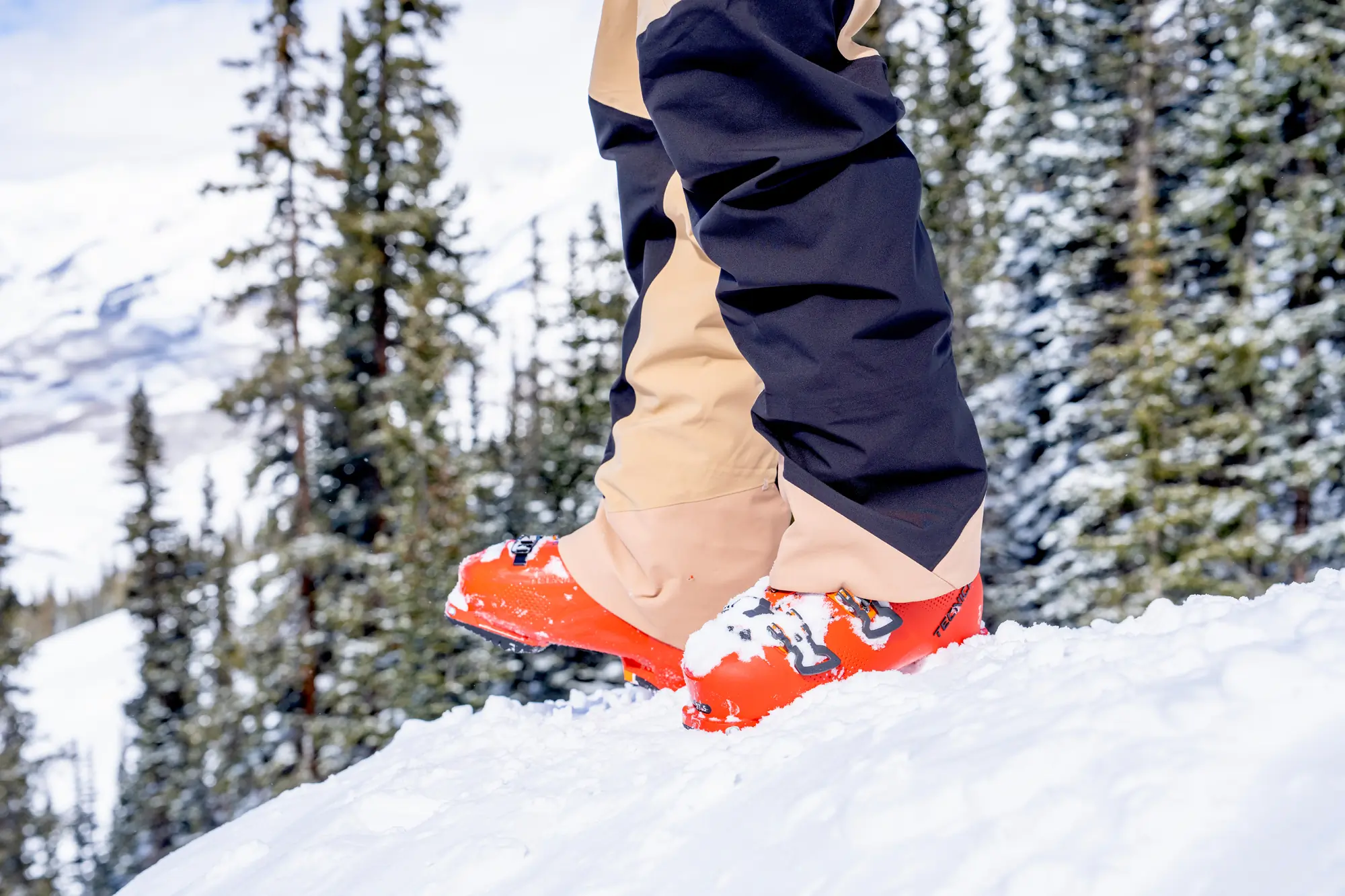
Touring or Backcountry Boot
Also known as an uphill boot, a backcountry boot’s cuff will rotate so you can walk uphill. Some have a bill that’s compatible with a hybrid binding. They typically use pintech inserts in the toe, small metal divets on either side of the toe that accept pins from compatible bindings.
- Many backcountry-specific boots are lightweight
- Usually lighter than a downhill boot
- Some are geared toward quick ascents with a superlight ski, not technical terrain, deep powder, fat skis, or freeriding
Hybrid Boot
A hybrid boot will have a tour mode, like a touring boot, but it will usually ski more like an alpine boot on descents.
- Usually heavier than touring-specific boots
- Somewhat less forward and aft rotation when you’re skiing uphill compared to touring boots
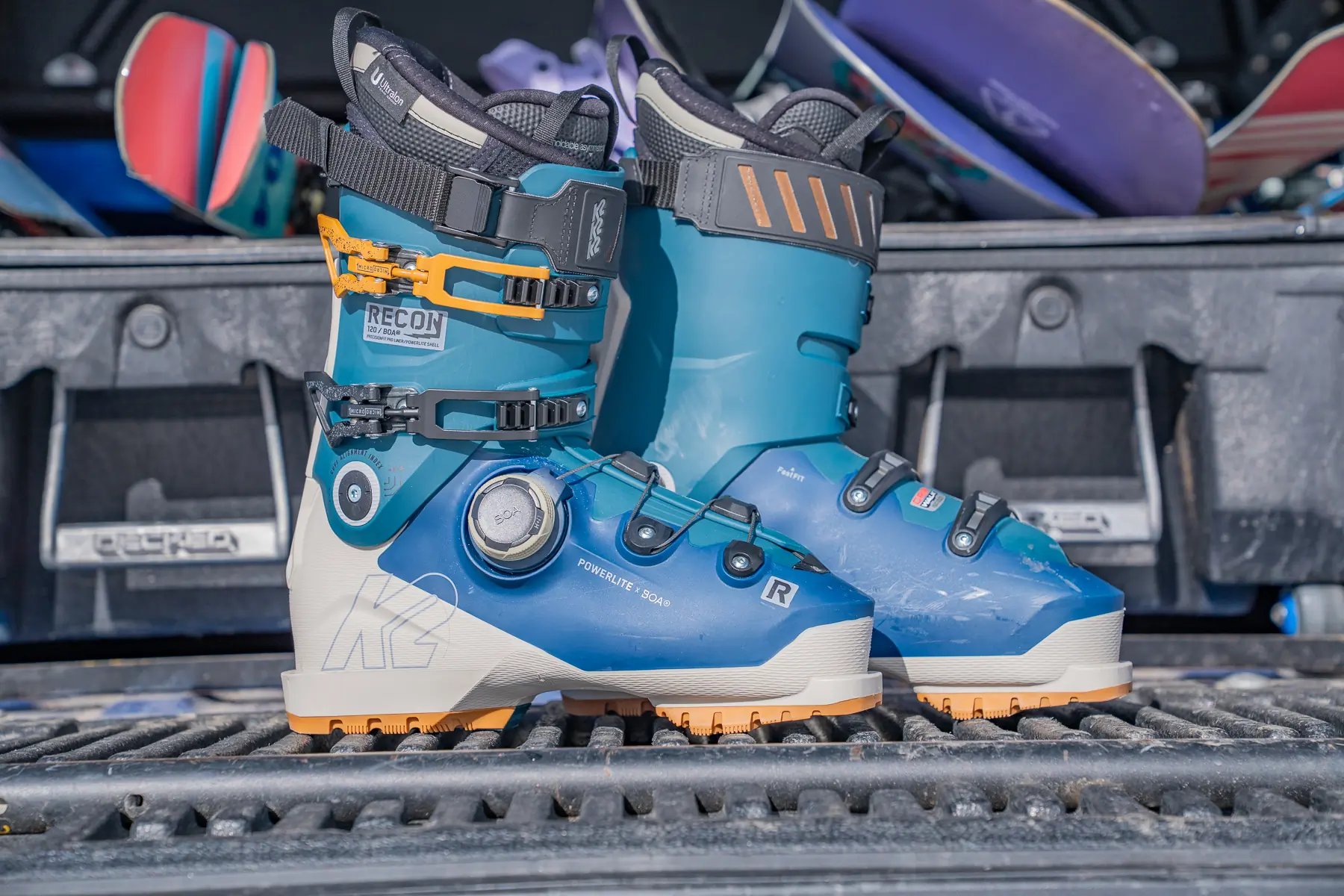



Ski Boot Flex
Flex describes a boot’s stiffness, and the correct amount of flex is determined by a skier’s experience level, strength, style, and preference.
Ski boot flex is determined and assigned by manufacturers. While the ratings give us an idea of how the ski boots feel within a brand’s lineup, the flex isn’t standardized across each company. So, for cross-brand comparison, the flex ratings can help you make broad versus apples-to-apples comparisons.
As you shop around, you’ll see boots with a flex that generally ranges from 65 to 120. The lower number represents a softer boot and gradually stiffens as you go up the scale. You’ll also see these flex ranges are usually lower for women’s-specific ski boots compared to men’s boots.
- Soft: 65-90
- Medium: 100-110
- Stiff: 110-130
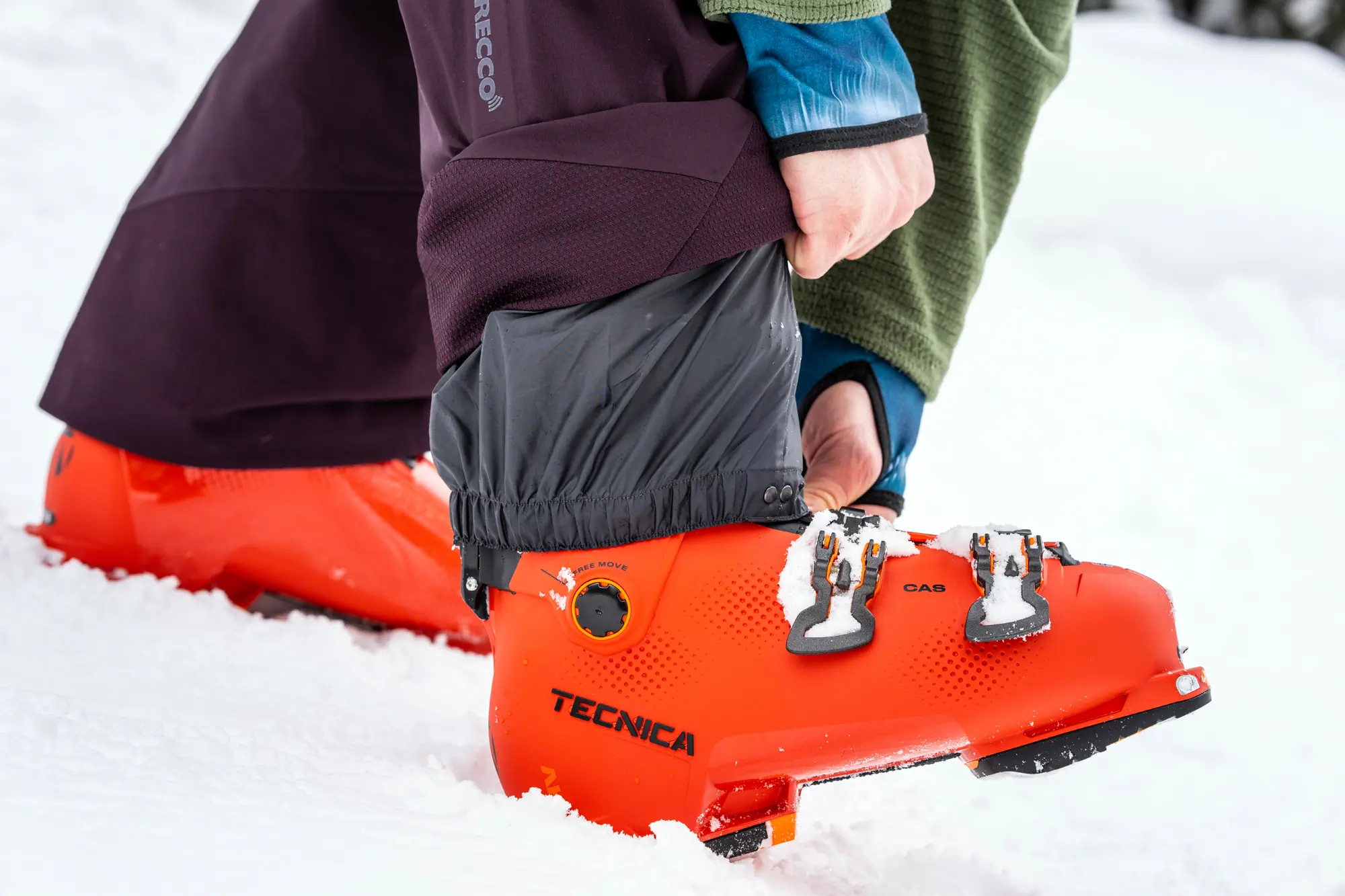



Soft Flex
Weis said a new skier should be looking at boots with flex from 65 to 90. A lower flex number is easier to engage.
“When a skier is engaging a boot, or flexing it forward, the boot needs to have resistance to transfer energy to the ski. If it’s too stiff, a skier won’t be able to flex the ski to carve — there won’t be any energy transfer,” said Weis.
Soft boots are also typically more comfortable and retain heat better than stiff designs. These are a good choice if you prefer cruising on green and blue runs or if you’re just getting started on the slopes. They’re also a fair choice for folks that weigh less.
They’ll also have the most economic price tag, but paying more for boots that match your ski style and skill level is worth the extra cost.
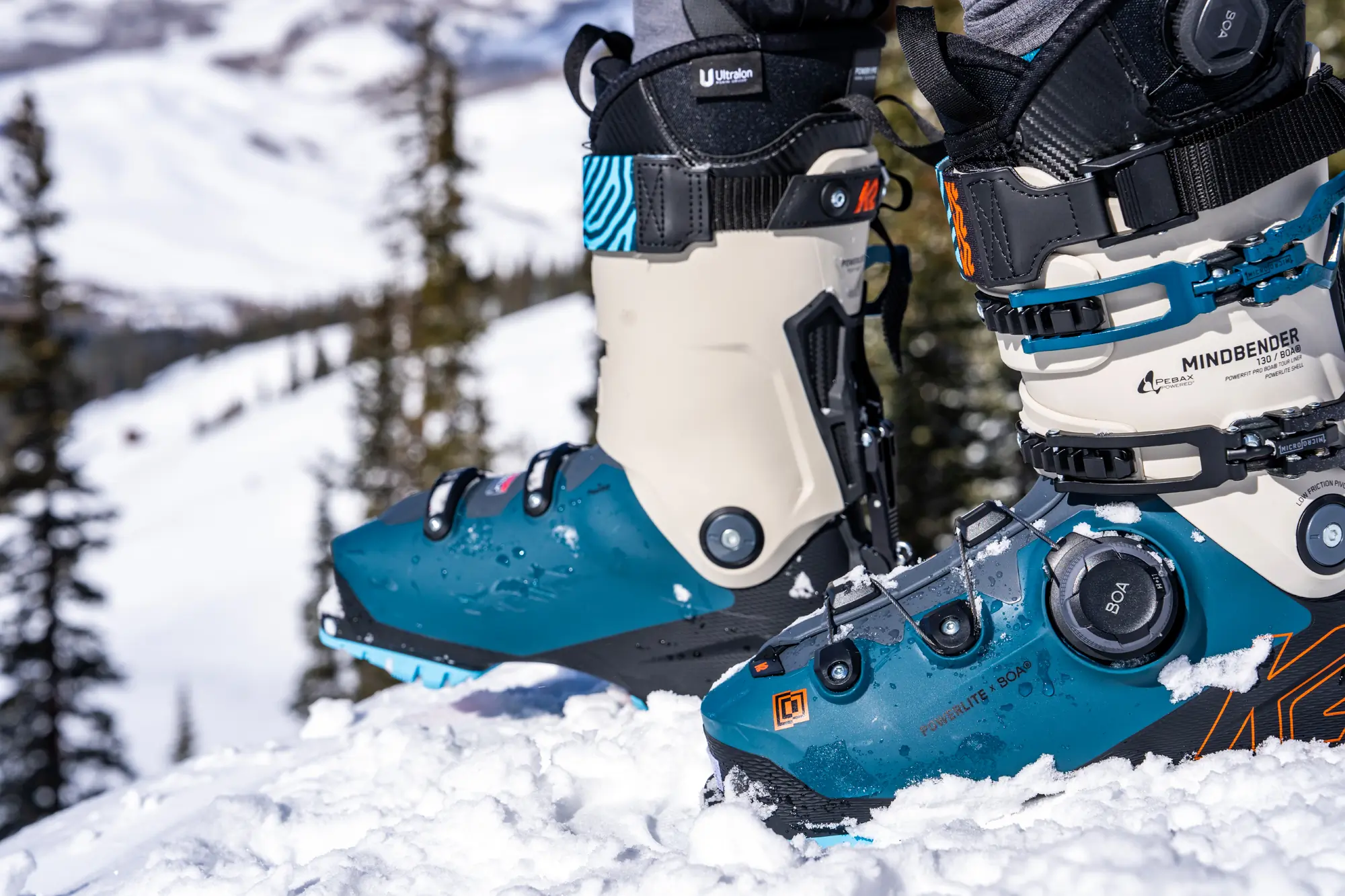



Medium Flex
Intermediate skiers should focus on flex from 100 to 110. A higher flex number indicates the boot will have more resistance and responsiveness. The boot can handle more aggressive turns and faster descents than soft boots. “If the boot is too soft, the skier won’t be able to control their ski,” said Weis.
If you’re a beginner skier but are heavier set, consider a medium flex boot right off the bat.
Stiff Flex
Advanced and expert skiers should buy boots with flex from 110 to 130. These designs provide the highest level of response and hold their own through speed. The price tag is higher in this category because these boots usually have a more technical build.
Advanced-level boots strategically place and integrate a range of soft, medium, or stiff materials into the design for optimal energy transfer. Don’t be surprised if the most rigid boots, typically intended for racers, simply feel too tight to use as an everyday driver.


Ski Boot Sizing: Mondopoint & Last Width
Ski boots use unisex mondopoint sizing, often referred to as “mondo,” which is the foot length in millimeters. You’ll also commonly see this size reference in centimeters, instead, like the 24.5-30.5 size range, for instance.
Mondo sizes start as low as 21.5 (U.S. women’s size 5) and go up to 30.5 (U.S. men’s size 13). They increase by half-size increments.
The last or footbed width ranges from 97 mm to 106 mm. Skiers with a narrower foot will want a slimmer last, as will athletes that want a tighter fit for snappier energy transfer and precision. Many ski boots offer a variety of last width options for narrow, average, or wide feet.
Narrow
- 96-98 mm
- Narrow feet
- Precise fit, feel, and responsiveness
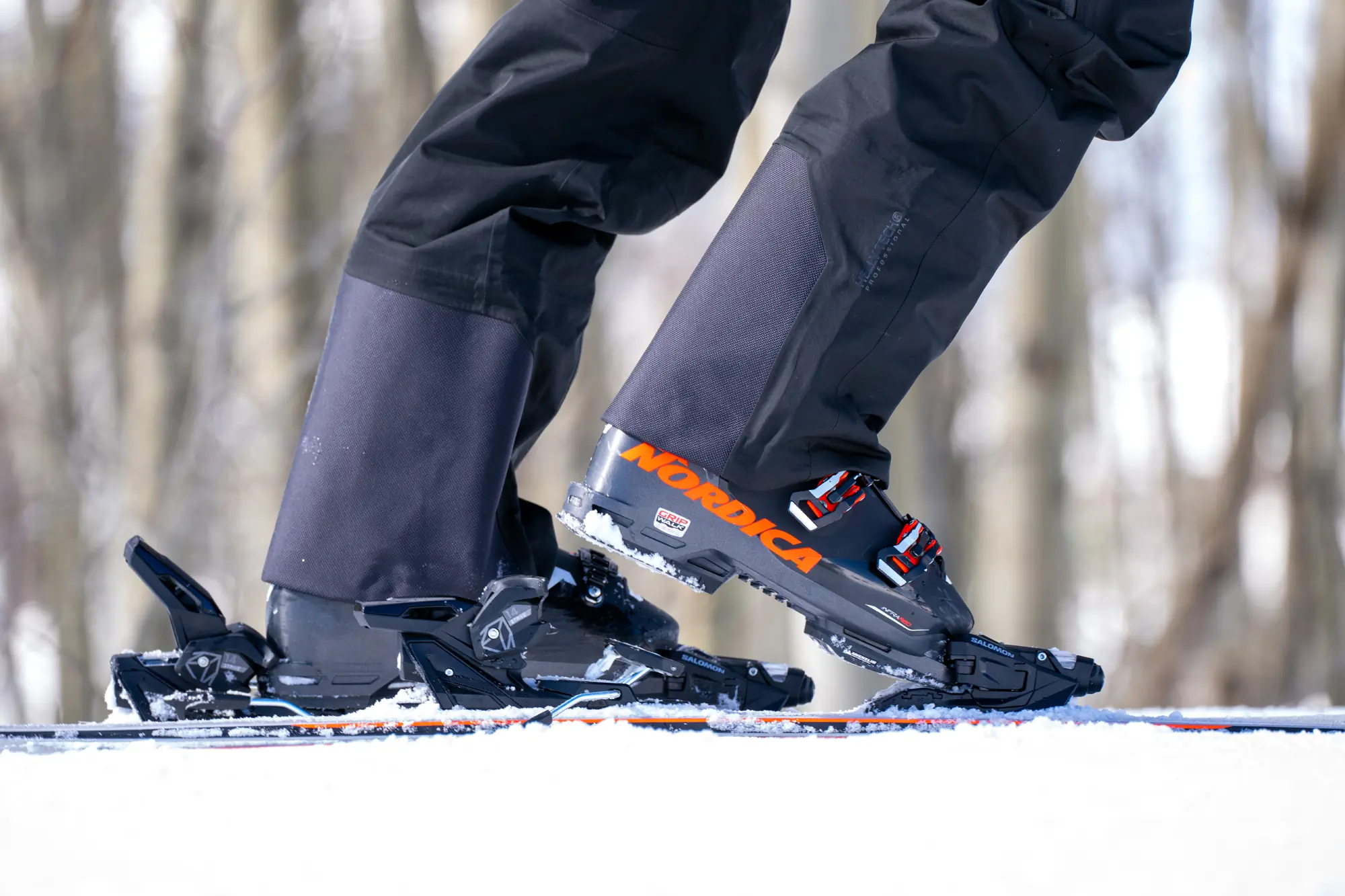



Average
- 99-100 mm for women
- 100-102 mm for men
- Good target range for feet with normal widths
Wide
- 103 mm+
- Wide feet
- Can be more comfortable for beginner skiers but might need to quickly upgrade to an average-width boot
To get the best boot for your foot, Weis recommends scheduling a fitting with your local shop. At that fitting, a ski tech will measure the length and width of both of your feet. They’ll properly determine your ski boot mondo and last size.
Depending on the ski boot model you need and your skill level, you also might need to size down to account for packing out the boot. But once they have those numbers, they should be able to advise you on which boots from which brands will match your physiology and best help you meet your goals.


Ski Boot Fit
Buying new ski boots can be one of winter’s biggest challenges. How a boot feels when you first slip your foot into it in the shop can be a far cry from how it feels once you have had it heat-molded and fit by a reputable boot-fitter. The temperature inside the shop versus on a wind-chilled ski lift will influence the fit, as will how your foot swells on a spring day or during exercise.
“Go with the mindset you’re buying the tightest piece of footwear you own,” said Weis. “And pick the boot that most feels like you could ski it out of the box.” It’s easier to make a boot bigger than smaller, and if a skier has one or two small issues, including pressure points or pain points, a boot should be workable. “If your foot isn’t happy in the boot in the shop,” Weis advises, “try something else.”
Whether you’re buying an alpine, hybrid, or touring boot, the same rules apply. Get your boot fit, consider aftermarket insoles, and be sure the boot you’re planning to buy matches your foot and binding.
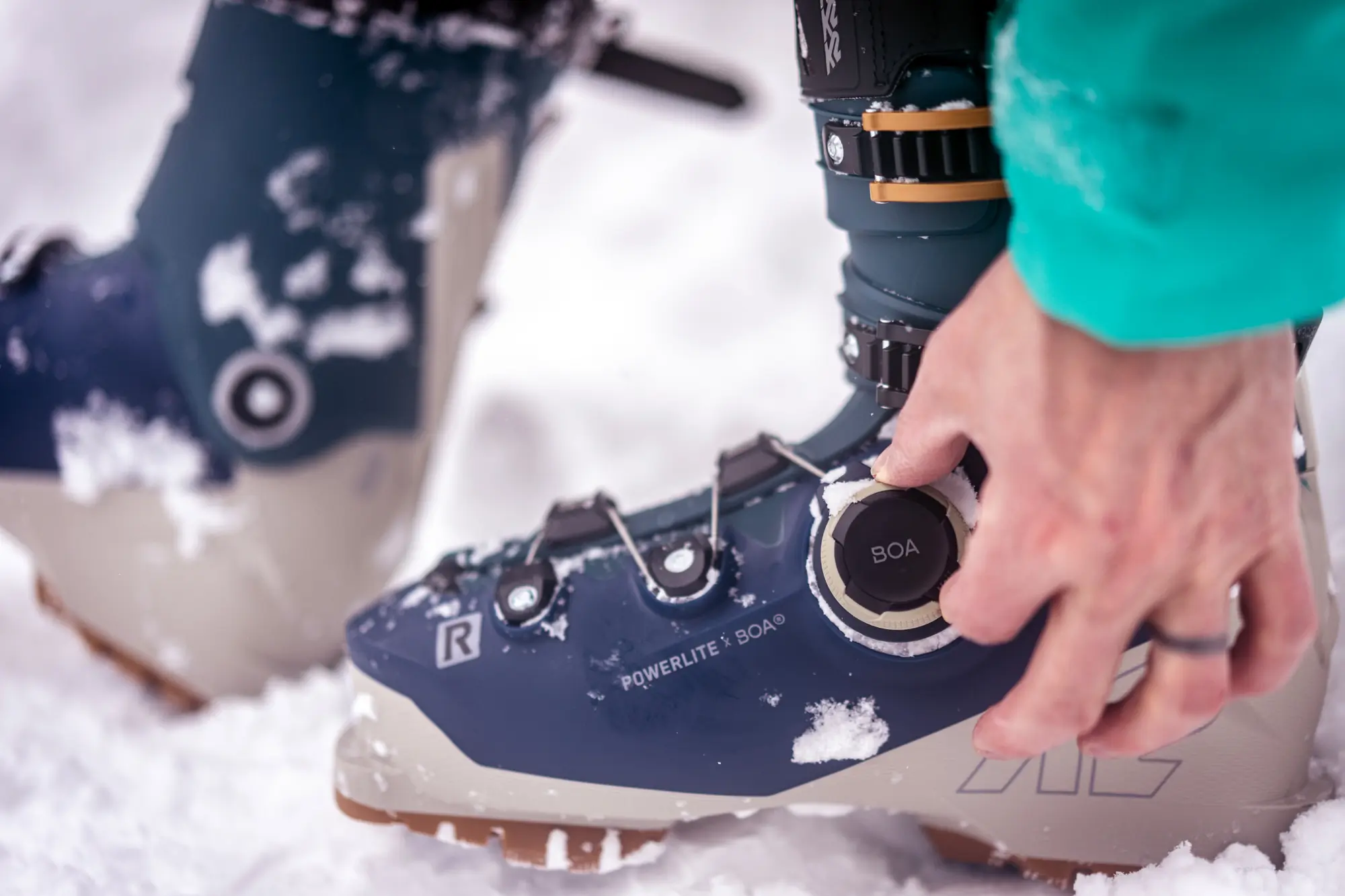



Ski Boot Outsoles & Ski Compatibility
While terms such as a boot’s flex rating are highly subjective, boot soles and their associated binding compatibility are subject to international scientific standards. For safety, this is a good thing as a proper boot-binding interface ensures your skis stay attached unless they really need to detach to help avoid injury.
However, the number of different soles and binding compatibility types can be confusing for recreational skiers. Not all ski boot soles are compatible with all bindings. Check with your ski shop to confirm the boots you’re considering will work with the bindings you own or plan to buy.
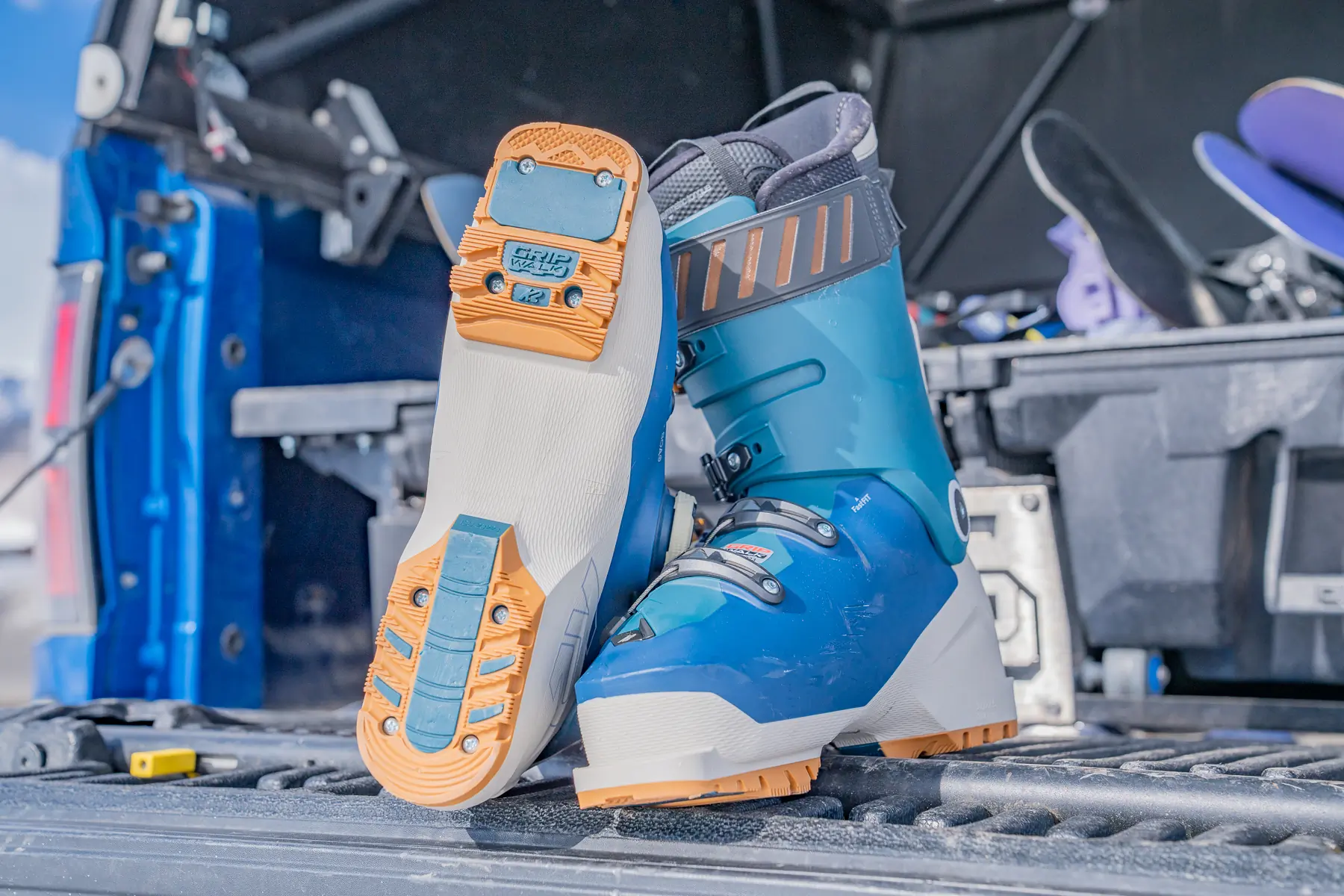



GripWalk
GripWalk soles are a common brand-name option that provides enhanced traction for hiking bootpacks and walking to lifts. Binding manufacturers now make GripWalk-specific bindings to ensure compatibility, but they will also work with traditional alpine boot soles. Multi-Norm Compatible (MNC) bindings are compatible with all boot sole types and are your best bet if you’re unsure. Still, the best practice here is to confirm compatibility with your local ski shop for the bindings you already own or intend to buy before purchasing your boots.
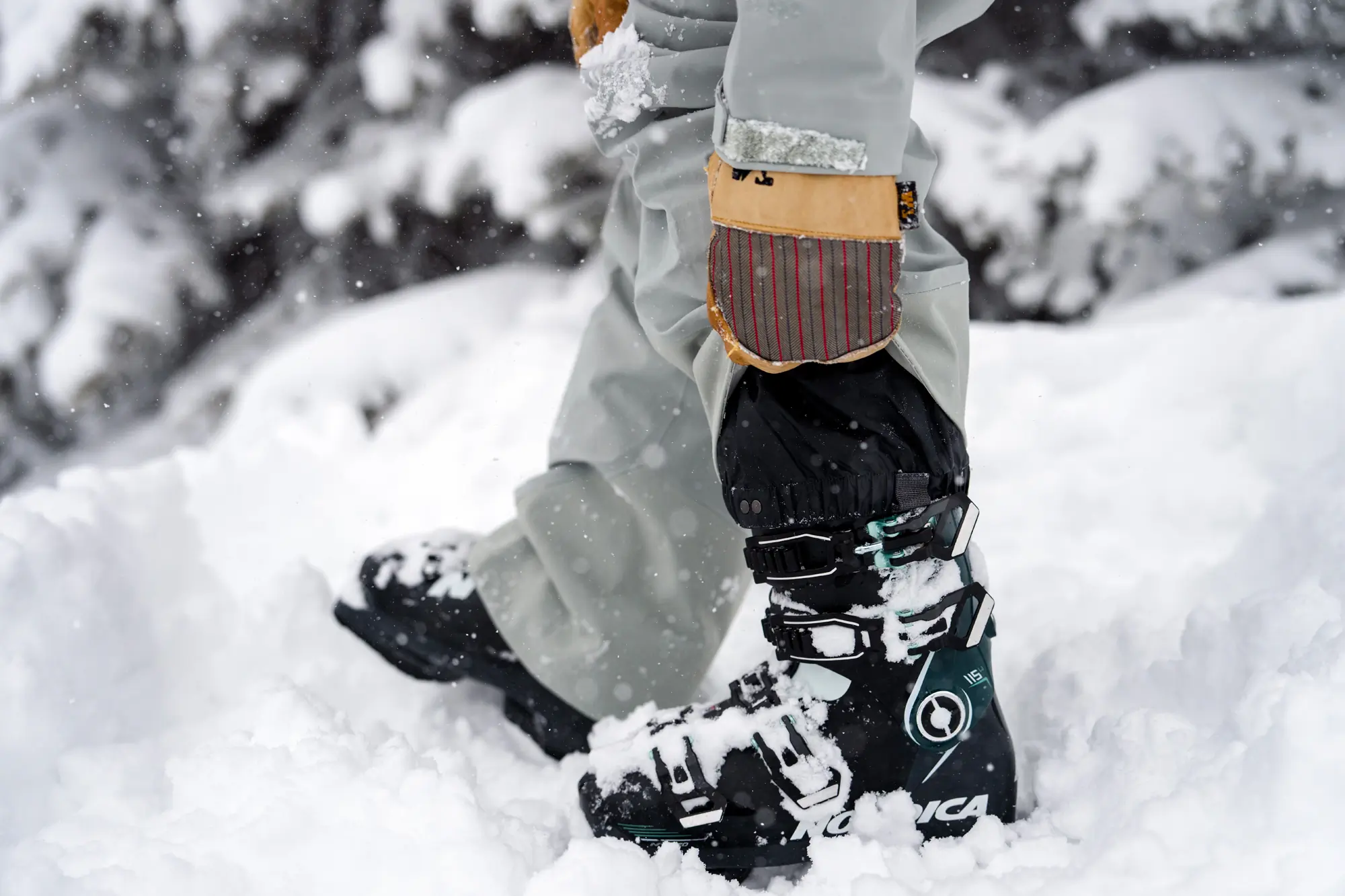



Ski Boot Weight
Following the growth of backcountry, side-country, and uphill exercise on skis, a boot’s weight has become a more important differentiator between boot types and preferences. There are more lightweight boot options for downhill and backcountry skiing on the market today than in years past. And the lighter a ski boot, the less weight you’ll need to slide atop the snow or step with as you climb a bootpack.
For instance, the SCARPA F1 LT is an ultralight boot for ski mountaineering that weighs 990 g (2.18 pounds). The SCARPA Alien 1.0, which is a hit among skimo racers, weighs 785 g (1 pound, 11.7 ounces).
Hybrid boots, like the Tecnica Cochise Pro W — 1,630 g (3 pounds, 9 ounces) — are heavy enough to drive skis at the resort but still light enough for touring. Pure alpine ski boots are heavier, like our top pick, the Tecnica Mach 1, which weighs 2,060 g (4.6 pounds).
Note: Our guide references the weight of one ski boot out of the set.
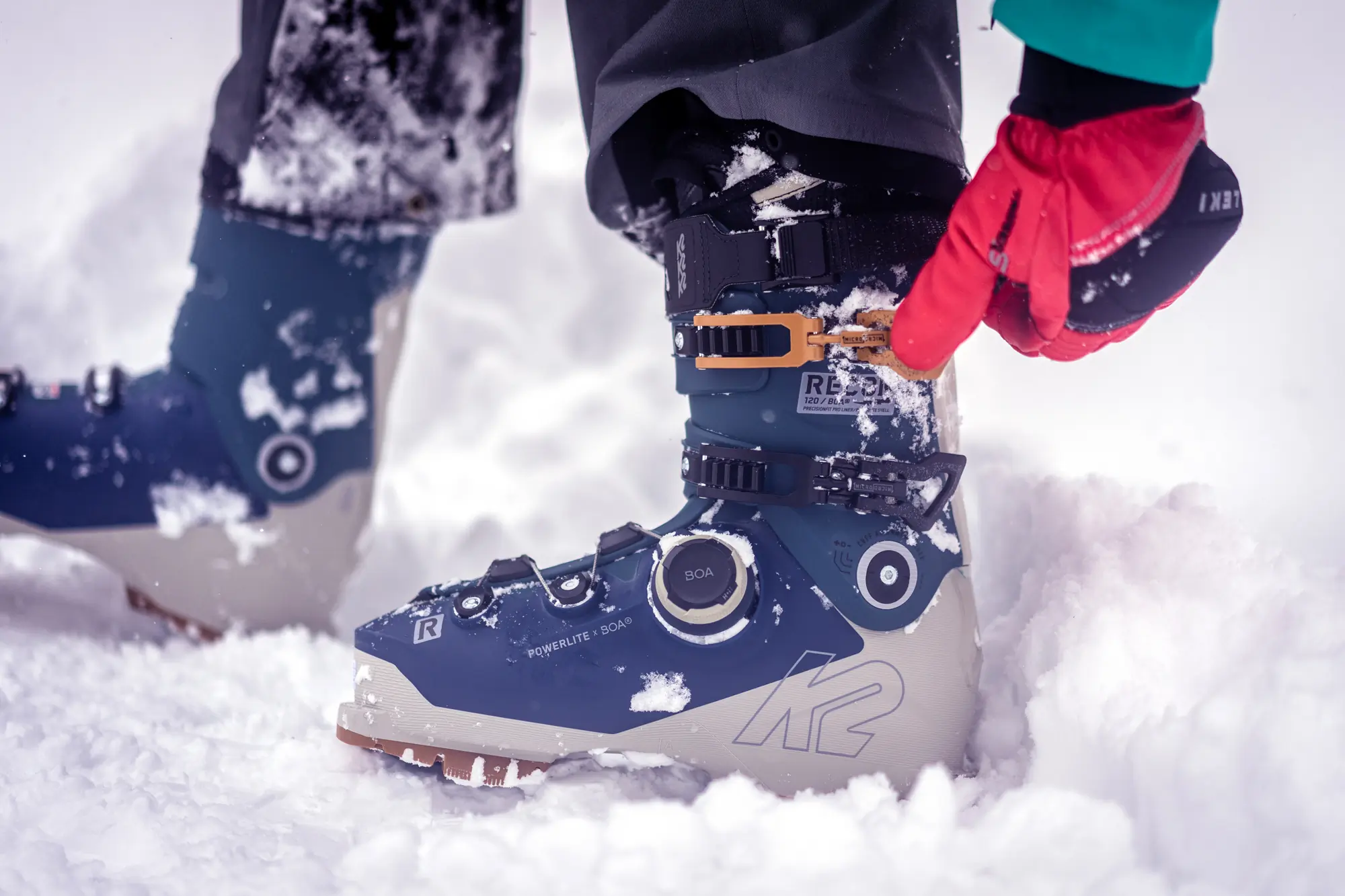



Ski Boot Buckles vs. BOA Closures
For years, almost all ski boots used essentially the same buckle styles to cinch the boot’s shell firmly onto your foot. Over the past few seasons, however, ski boot manufacturers have begun adopting the BOA system common in snowboard boots and other footwear.
If you’ve seen a ski boot before, you’re already familiar with traditional buckles. A hinged clasp reaches across the front of the boot to a ladder-like series of notches that let you adjust the compression.
The BOA system is a major departure that uses a network of thin but strong metal cabling and a twist knob to perform the same operation. One BOA often replaces two buckles on a ski boot, somewhat simplifying the process of locking in for a descent.
The advantage of BOA, borne out in our testing of many BOA-enabled models such as Fischer’s RC4 PRO MV boots, is that it exerts more even pressure and allows for more precise micro-adjustments than traditional buckles. As a result, it’s easier for beginners to properly operate and is less likely to result in a fit that’s too loose or too tight.
The downside for some advanced skiers is that it can be harder to achieve high levels of compression, sometimes requiring many, many twists of the knob to eat up enough slack in the cable. Traditional buckles give you plenty of leverage to clamp down the boot’s shell and it’s faster to close a buckle, especially when you already know which notch feels best for you.




Ski Boot Liners
Inside the hard plastic shell of a ski boot is the liner, which provides cushioning and insulation. Boot liners are made from various densities of foam. They provide foot and ankle support and comfort and help prevent fatigue. They also add a layer of heat insulation inside the boot’s exterior, which is a hard plastic shell.
Most stock boot liners are made using injected foam covered in thin fabric and are made by the boot manufacturer, though some boots can be found with third-party boot liners from brand names such as Intuition.
Some skiers will choose to replace stock liners with custom options if they have foot and ankle shapes or problems or simply want to avoid the uncomfortable break-in period. Companies such as Surefoot will take molds of your lower leg and foot to create a custom foam-injected liner built to fit your individual shape.
While simply skiing in your boots often breaks them in adequately, professional heat-molding and other bootfitting techniques can help alleviate hotspots caused by the liner and/or the boot shell. Finding a good initial fit can minimize the amount of customization and your local bootfitter can help guide you.
ZipFit uses a unique leather liner filled with bits of cork for a more precise fit that improves with use. These liners usually are purchased aftermarket for around $500 to replace stock liners, but Fischer’s expert-oriented RC4 PRO line comes stock with ZipFit liners.
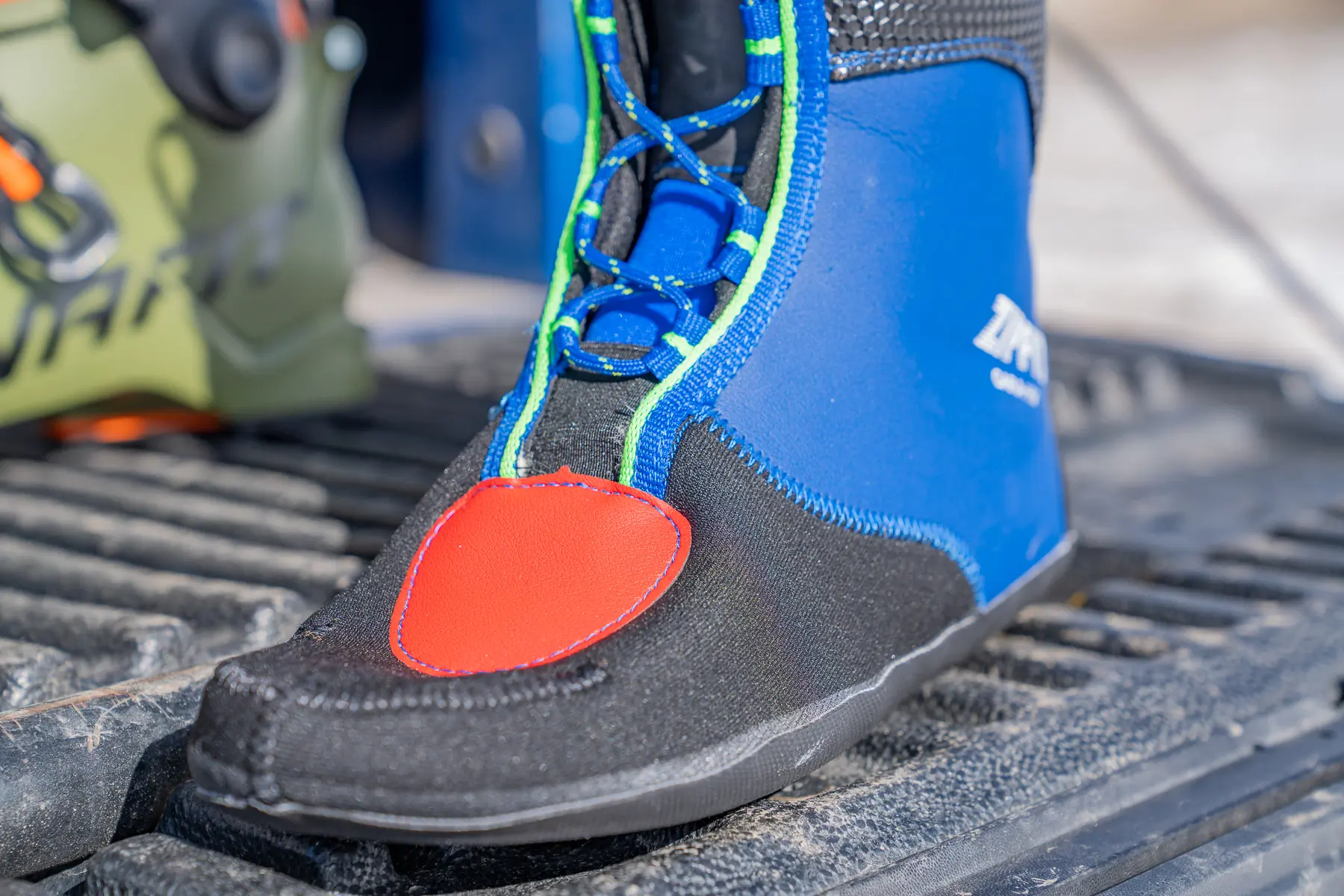







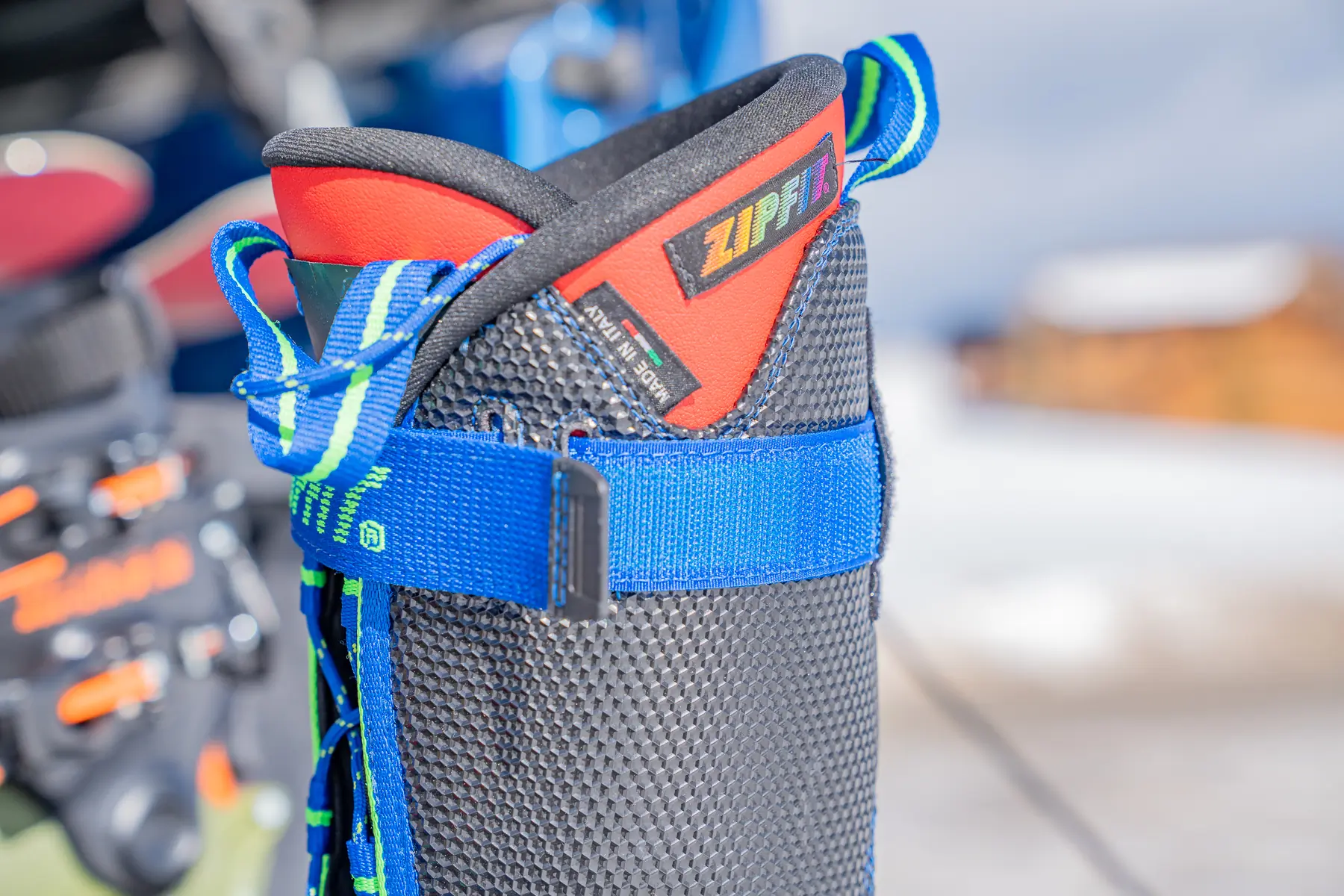



Ski Boot Insoles
Don’t think you’re just being upsold if the ski tech recommends custom insoles. Weis said skiers with a soft or collapsed arch will especially benefit from aftermarket or custom insoles. By supporting the arch, an insole keeps your foot from over-splaying inside your boot.
“You want to make sure the natural shape of your arch is matched to the insole of your boot,” said Weis. “When your foot sits in the correct spot in your boots, it’s less likely to become fatigued.”
While the stock insoles that ship with ski boots may have some anatomical shape, they are necessarily generic and will be no match for a custom insole. Most ski shops with professional boot fitting will offer custom insoles created by taking an impression of your foot and crafting an insole to match it.
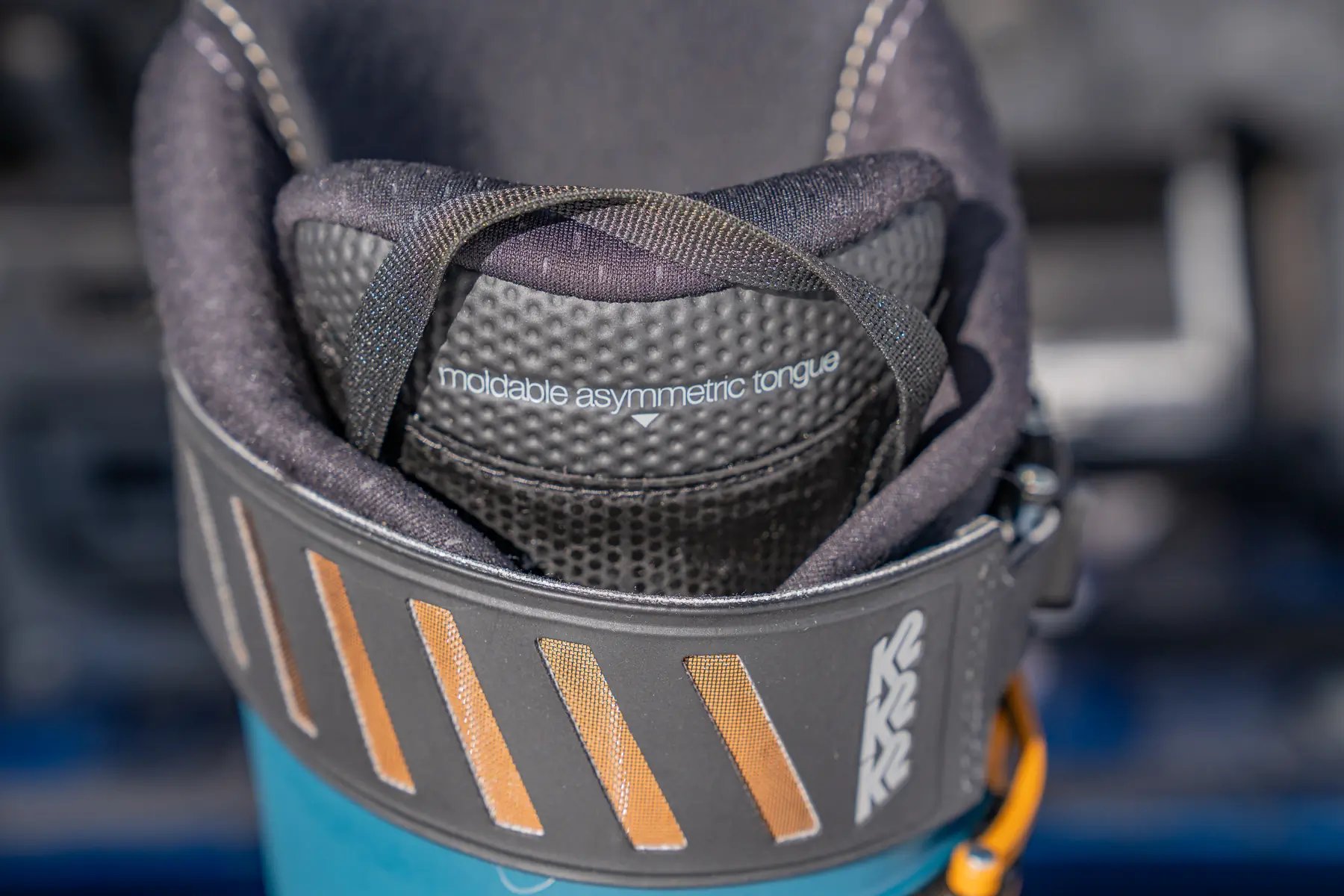



Ski Boot Warmth
One of the most common complaints about ski boots (and the top reason good ski days are cut short) is cold feet. The best way to avoid cold feet is to get a proper fit by purchasing boots that fit well and having a professional boot fitter adjust the fit as needed.
While skiers understandably want a snug, secure fit, overtightening boots can also hamper circulation and quickly lead to cold or numb feet. Fit should be firm without creating excess pressure on the foot and, again, this is easiest to achieve with a properly fitted boot.
If proper fit isn’t enough, there are a variety of options to address cold feet in ski boots. Finding a boot with thicker liners can provide some additional insulation and some companies such as Nordica include additional insulation materials such as PrimaLoft, but skiers with recurring cold feet problems often turn to one of several ways to add external heat to ski boots.
Heated socks are usually the cheapest option, and several companies, such as Therm-ic and Hotronic, make ski-specific options. Heated insoles are another option and plenty of companies make them, but you will have to choose between a custom ski footbed and a heated insole.
The best and most expensive option is heated boot liners, which can be purchased aftermarket and customized from companies such as Surefoot. A handful of bootmakers, such as K2, sell ski boots pre-loaded with heated liner systems, but going this route will severely limit your choices when shopping for ski boots.


Women’s-Specific Ski Boots
A handful of manufacturers make ski boots that are women’s-specific. Compared to a unisex or men’s ski boot, women’s lineups typically have a lower flex rating set, so the boot options are softer. The models usually feature a smaller size or mono range compared to the men’s models.
Sometimes you’ll see narrower last options for women but not for men in a particular ski boot. The style features, like the color scheme, are usually tailored to a female demographic, too.
Some women’s-specific boots also have anatomical differences based on research, boot-fitter input, and feedback from female skiers. That includes the Tecnica Mach1 LV 105 TD boots, which are built with a unique upper liner that molds to the shape of the female calf. The result is no pressure points while charging steep laps or making fast carves.
The cuff is also built with a tad more forward lean and a higher spine, which increases performance while decreasing overall fatigue. In general, some ski boots have a narrower or tapered heel and greater cushion around the ankle for security.
While the male- and female-labeled ski boots might help the average skier, there are folks who identify as male who need narrower, softer boots, and there are female skiers who want extremely stiff boots. Don’t be afraid to try on boots across these two general categories. Choose the style and fit that best matches your feet.
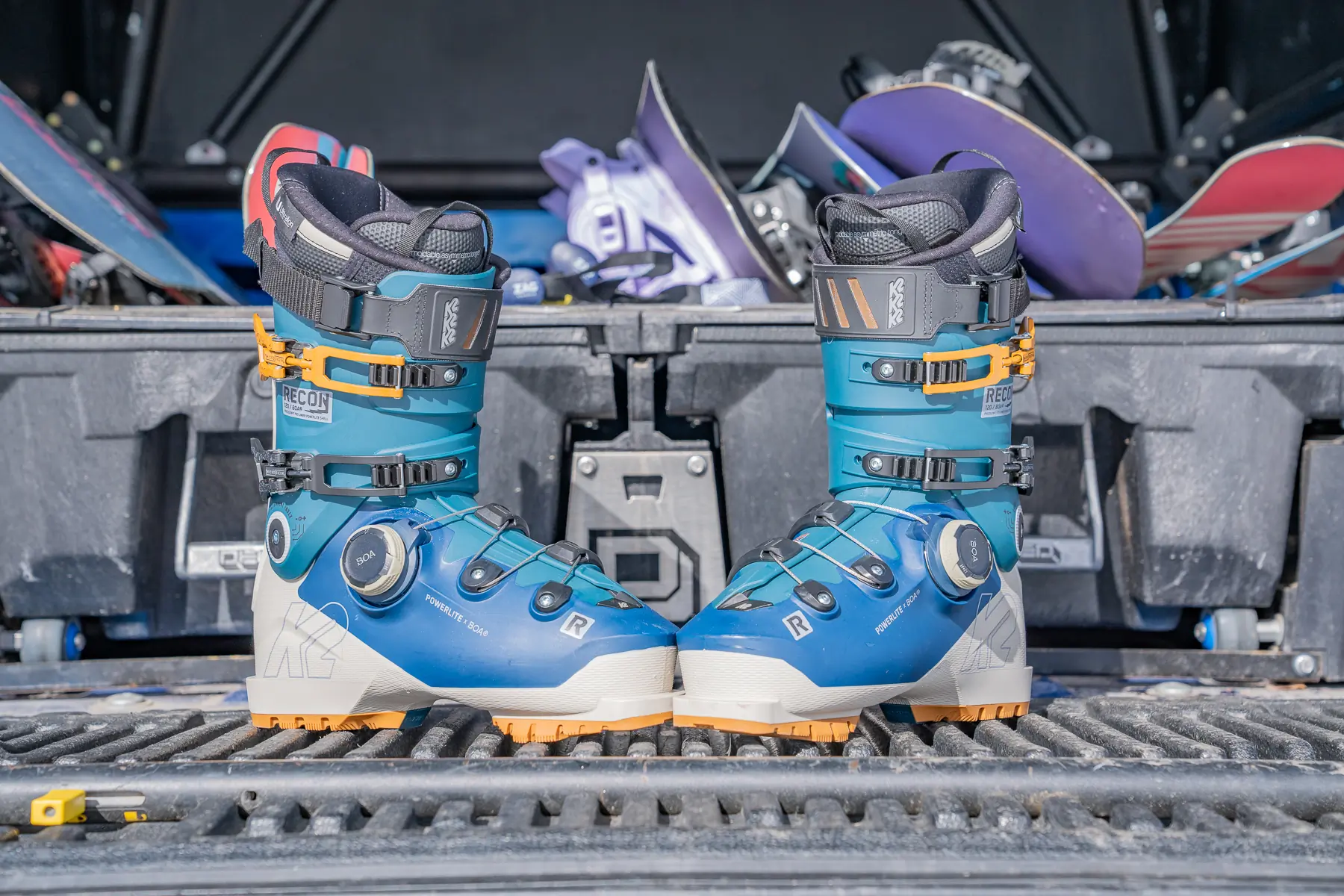



Sustainability: Ski Boot Designs
Improvements in the environmental friendliness of ski boots have been hard to come by due to the need for specific performance characteristics of the shell which has traditionally used lots of petroleum-based plastics.
A few bootmakers such as SCARPA, Head, and Fischer have introduced a bio-based alternative, however, using Pebax plastic created from castor bean oil.
Another way bootmakers such as Dalbello have approached the problem is by using a percentage of recycled materials that, while still petroleum-based, do not require additional raw materials to produce. Italian ski brand Tecnica has a pilot program in Europe to recycle the materials in ski boots.
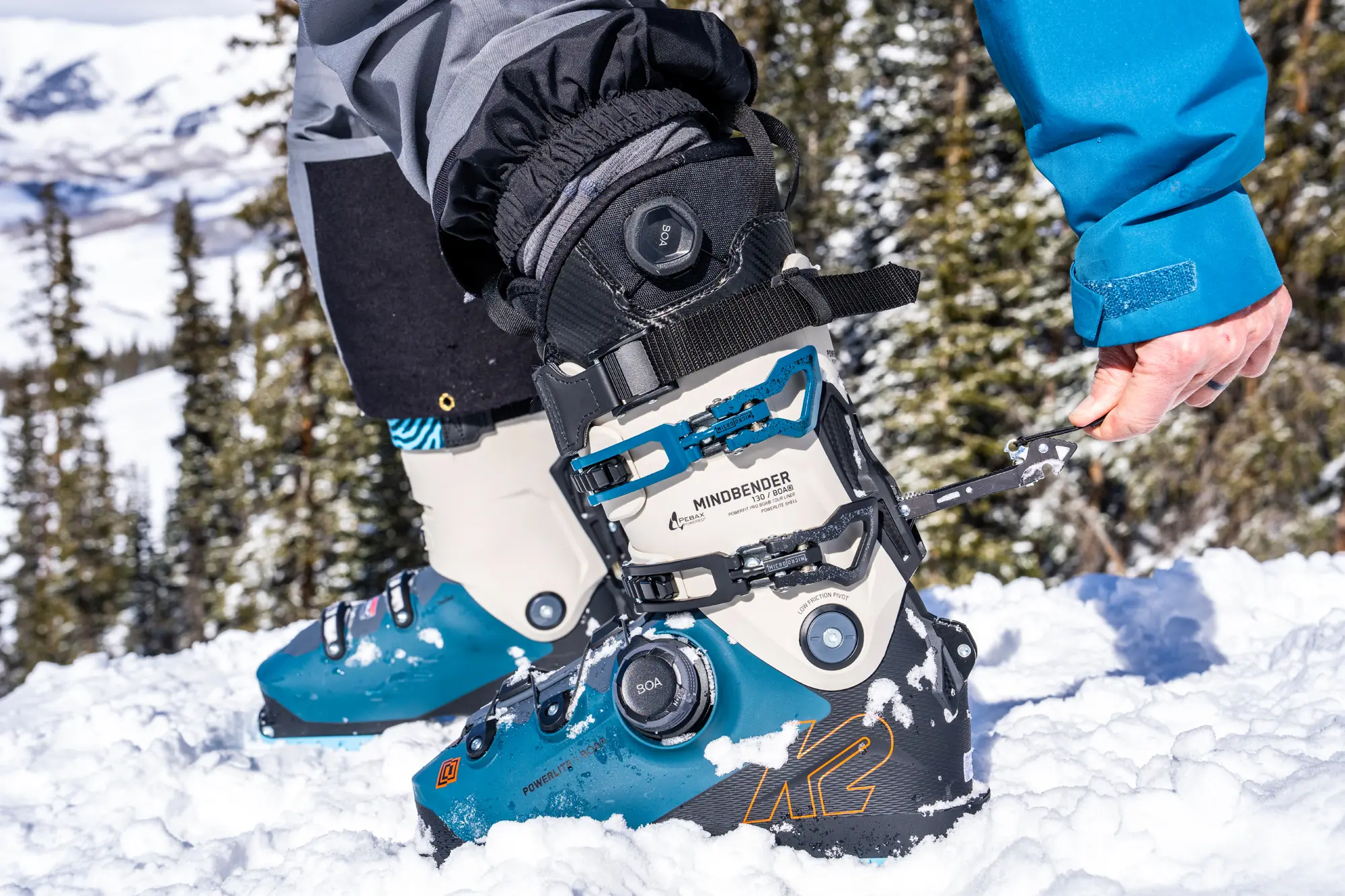



Price & Value
As with most things ski-related, ski boots don’t come cheap. Expect to spend between $250 and $1,000 on a pair, though buying in the offseason can produce deep discounts on previous years’ models.
Budget Ski Boots
Luckily for beginners, entry-level ski boots are often the cheapest options on the shelf since they don’t require the same grade of materials and performance as expert-grade options. You’ll find options like the Dalbello Panterra — Men’s 90 GW & Women’s 85 W GW that range from $450-$500. These boots have a basic shell, liner, and buckle closure design. These designs are generally not as stiff.
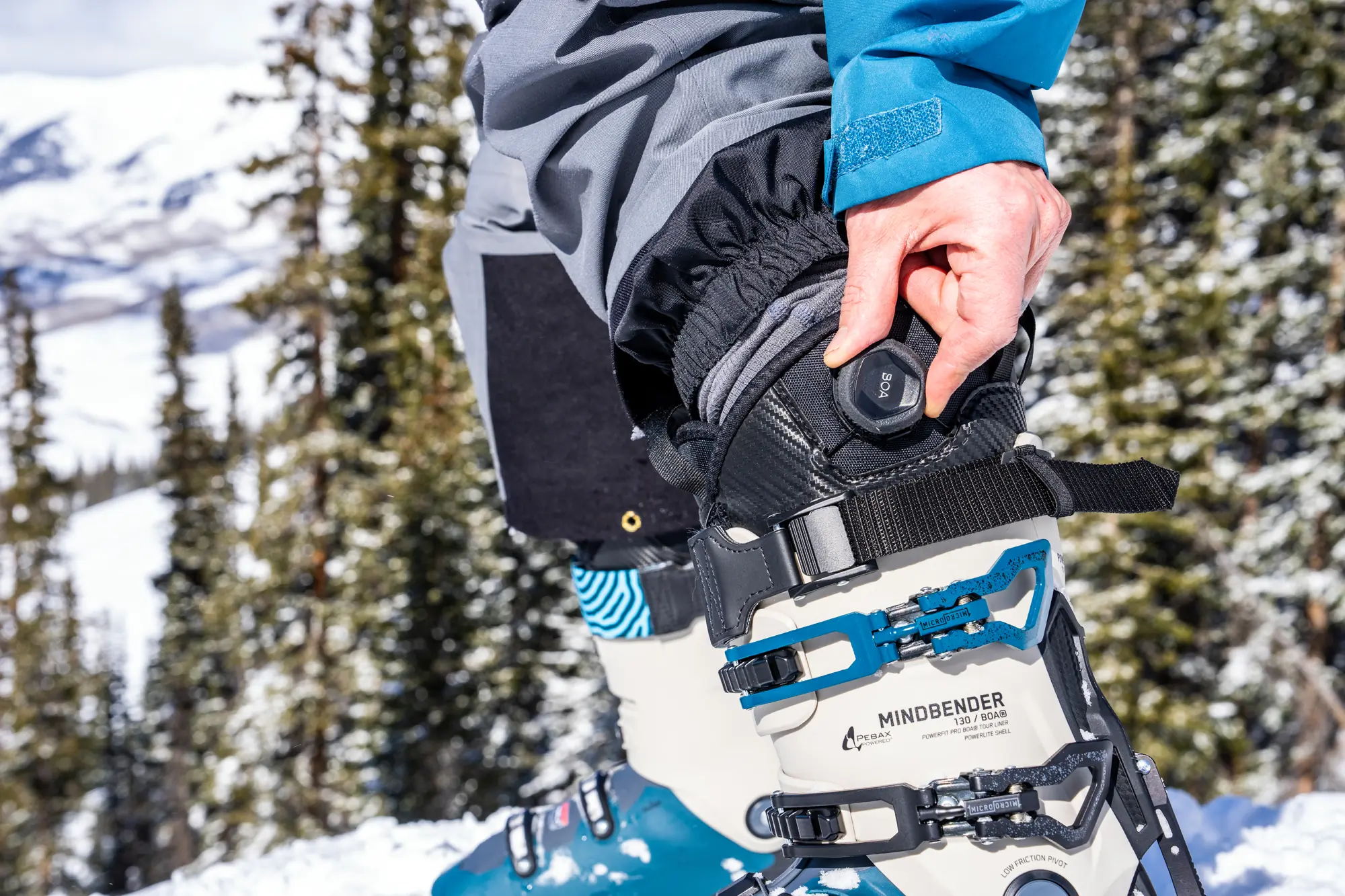



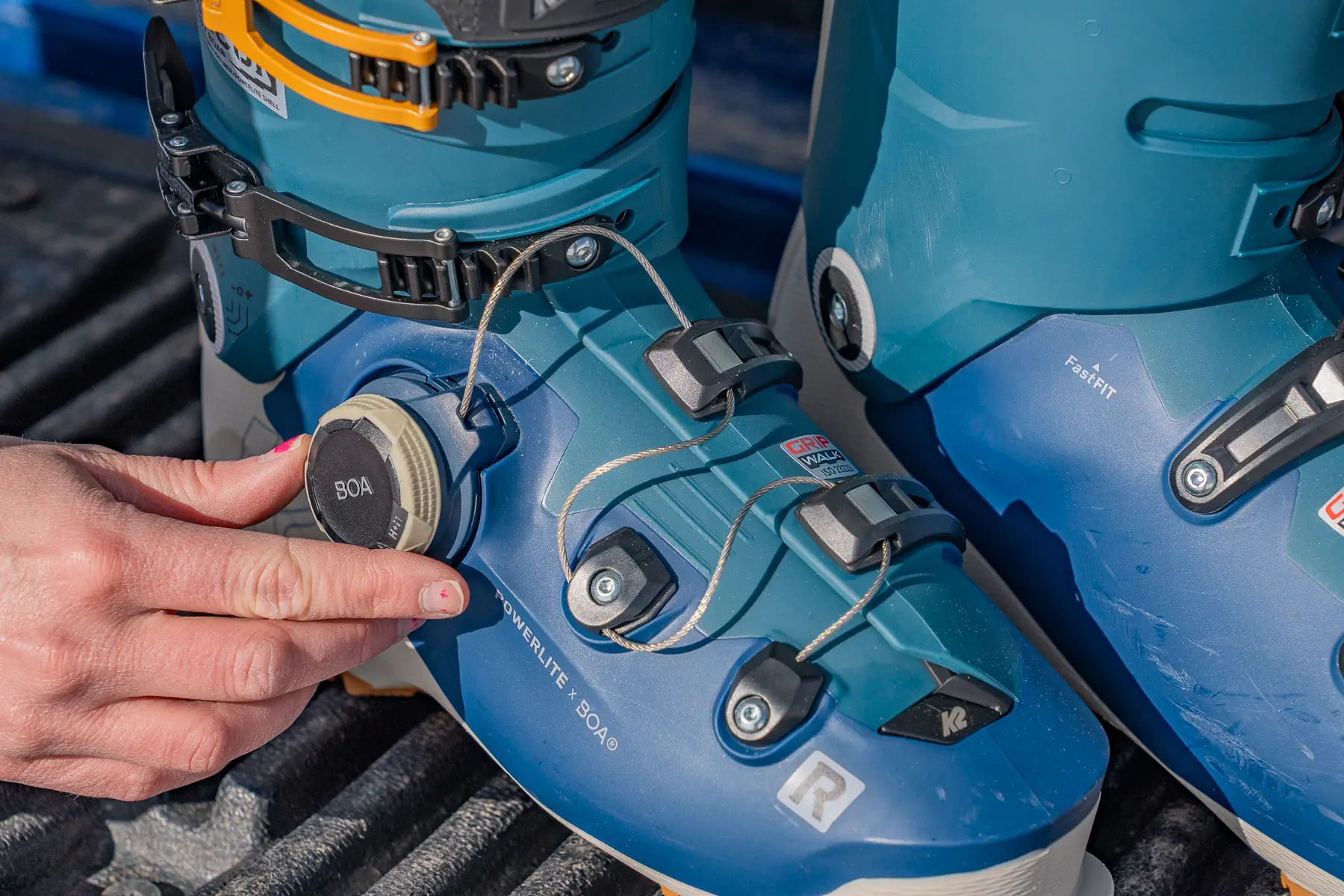



Mid-Tier Ski Boots
The majority of our favorite downhill ski boots are in this price range. You’ll find stiffer builds like the Tecnica Mach 1 ($700) that go up to a 130 flex, and you’ll start to see a range of volumes, including low, mid, and high.
Hybrid boots start to enter the arena like the Salomon SHIFT PRO 130 AT ($800), which is more tailored for downhilling but has uphill capability for the occasional hiker. In recent seasons, BOA started making its way into designs, and some of those boots cash in at less than $1,000.
Premium Ski Boots
In general, backcountry ski touring boots are more expensive than their alpine counterparts and there aren’t many budget options when it comes to backcountry boots. One way to save if you want the option to ski away from the resorts is to look for a hybrid boot to use both in- and out-of-bounds to avoid having to buy two expensive pairs of ski boots.
Tipping close to a grand, the Atomic Hawx Prime XTD 130 Tech GW ($950) is an example of a premium hybrid boot with a 54-degree range cuff flex while its in tour mode, yet the boot loses no power on the descent.


Frequently Asked Questions
The types of ski boots include alpine or downhill boots, which are the burliest, heaviest, and used for downhill lift-served skiing at the resort. You’ll also find touring or backcountry boots, which are lightweight and made for off-piste terrain.
There are hybrid boots that have a tour mode and weigh more than lightweight touring boots, but can perform more like a downhill boot. They withstand more aggressive descents. Read more about the differences between these types of ski boots in the buyer’s guide above.
To get the best boot for your foot, schedule a fitting with your local shop. At that fitting, a ski tech will measure the length and width of both of your feet. They’ll properly determine your ski boot mondo and last size, which might also be influenced by the type of boot you choose and the type of skiing you aim to do. Read more about ski boot sizes, including the mondopoint and last width, in the buyer’s guide above.
Generally, new or beginner-level skiers, or skiers who prefer mellow terrain (greens and some blues), prefer a soft ski boot. A medium-flex ski boot is great for an intermediate skier who’s progressed to steeper terrain, more and sharper carves, and speedier days. The stiffest boots are sought by advanced and expert skiers for a higher level of responsiveness.


Women’s-specific ski boots are different from men’s ski boots in a variety of ways, and not all boots are women’s-specific for the same qualities. Some boots differ aesthetically, and the size range is smaller and has a narrower option, too.
Other women’s-specific boots are anatomically designed based on female input. Those features could include unique liners that mold better to the female calf muscle, more forward lean in the cuff, a tapered or narrower heel, and additional cushion around the ankle.
Higher-priced ski boots typically have a more complex blend of pliable materials, which provide a precise boot fit and performance. They can offer a more tailored fit out of the box and additional features like grippy soles for walking over ice.
Also, narrower boots typically cost more, so skiers with those alleyway feet should upgrade from the get-go for a good fit. Premium boots also have liners with a blend of various foams, which enhances security.
Overall, more expensive ski boots are worth the investment for a better fit but not at the exchange of comfort. If you are new to skiing, it’s a good idea to start with a cushy, soft boot versus pulling on a more aggressive-fitting premium boot right away.
To preserve ski boot soles, don’t walk on gravel, asphalt, or long distances on a sidewalk. Walking on firm surfaces will degrade the toes and heels. To help protect the soles, you can wear cat tracks, which are detachable sole protectors.
After every use, hand-remove the snow (joint bang the boots together). Then remove the liner and thoroughly dry it with a boot dryer. Moisture builds throughout the day from snow and sweat. If they stay wet, then mold, mildew, and bad odors can form. Wetness can also deteriorate the liner.
You can also wipe down the exterior and interior of the ski boot shell with a dry cloth. Close each buckle so the shell can sit in its preferred shape and avoid damage or getting warped over time.
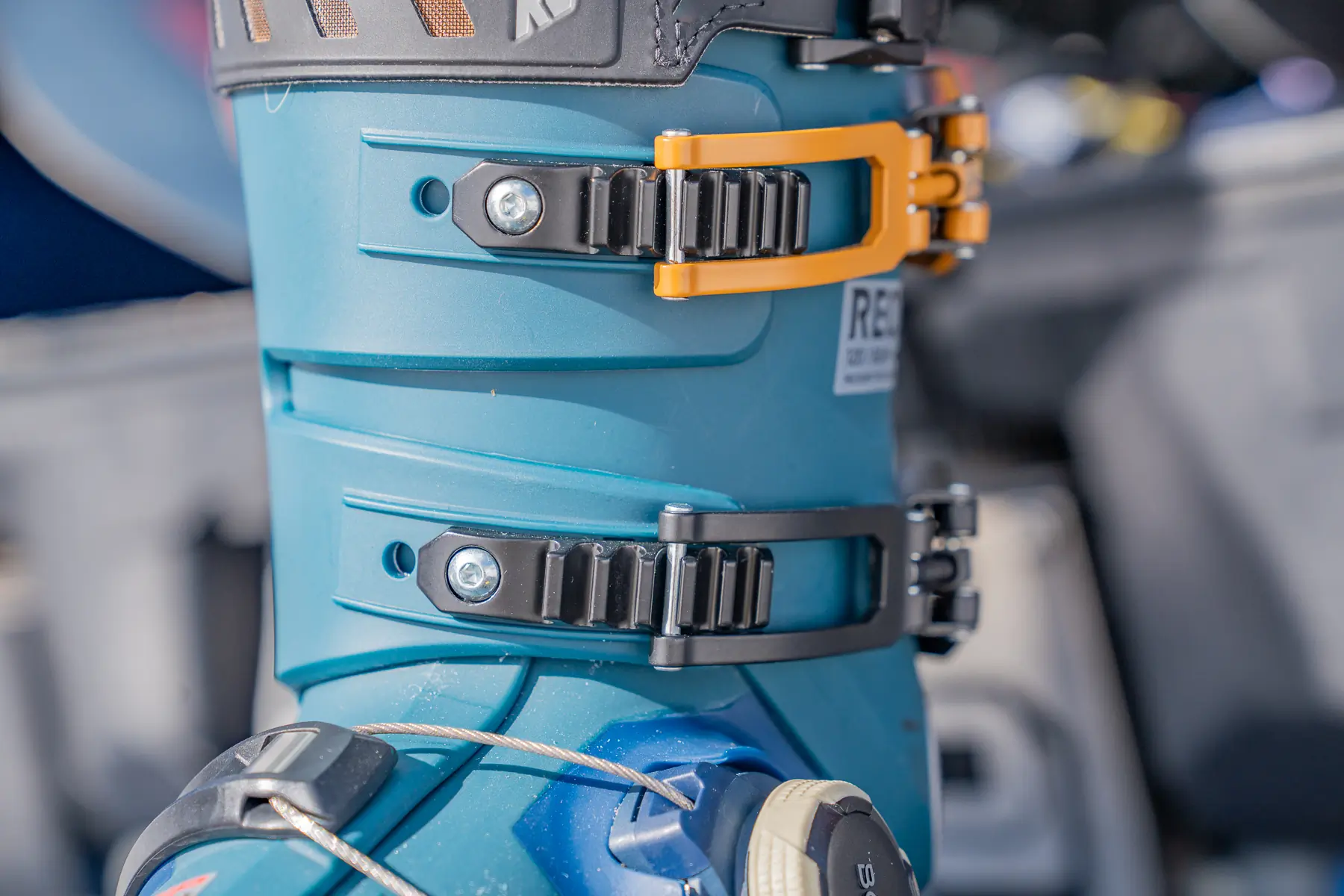





Salomon S/Pro Supra BOA Review: Low-Volume Ski Boots Never Fit So Precise
Ski boots are so subjective — it all depends on your feet. Luckily, BOA’s dial adds the ability to make micro-adjustments for fit.
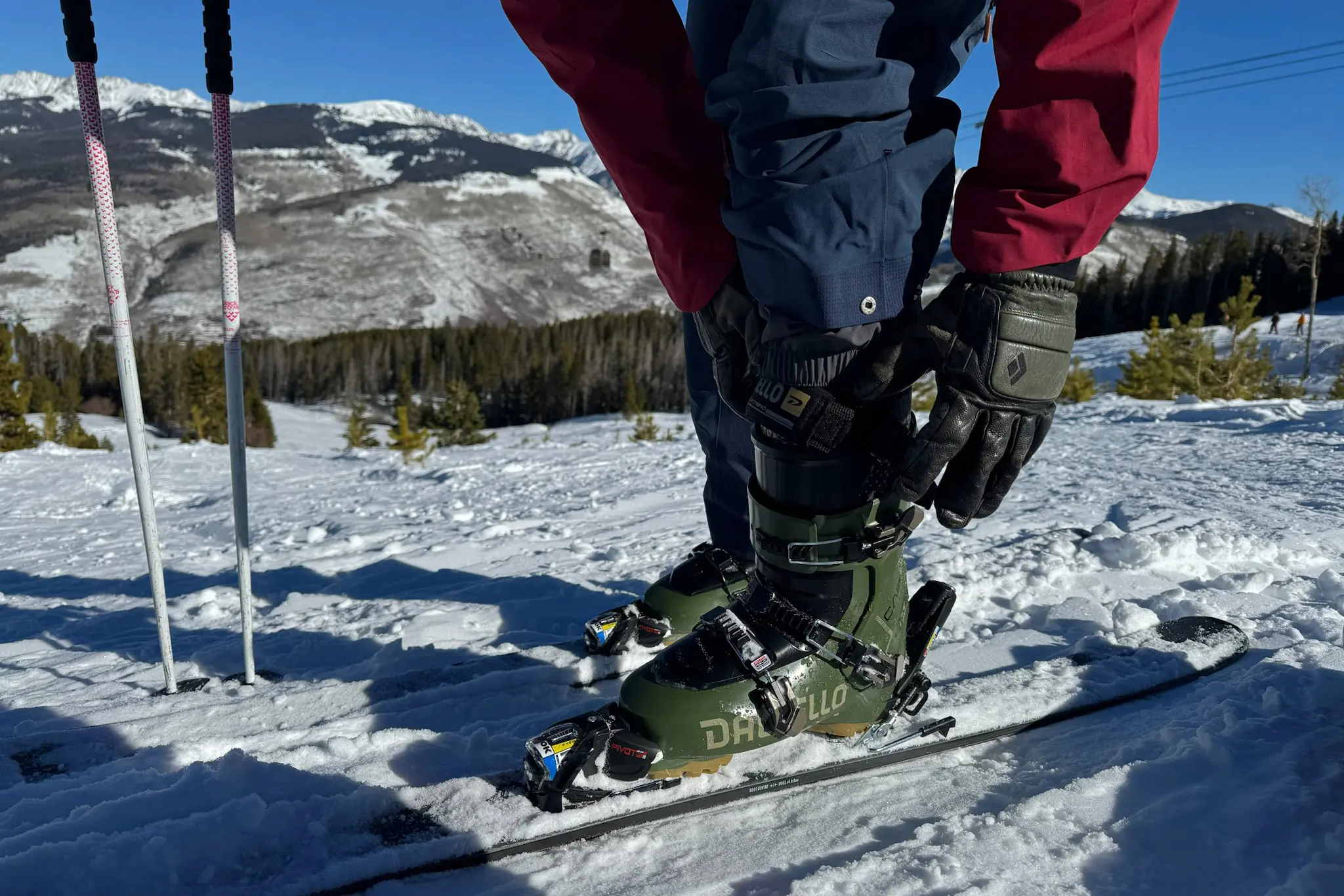

Easy-On, Easy-Off, Expert-Level Ski Boots: Dalbello Cabrio LV 130 Review
The Dalbello Cabrio LV 130 three-piece boots ski smooth and powerfully, yet soften impacts in harder snow — and unlike most traditional overlap boots, getting in and out of them is easy-breezy, painless, and quick.

